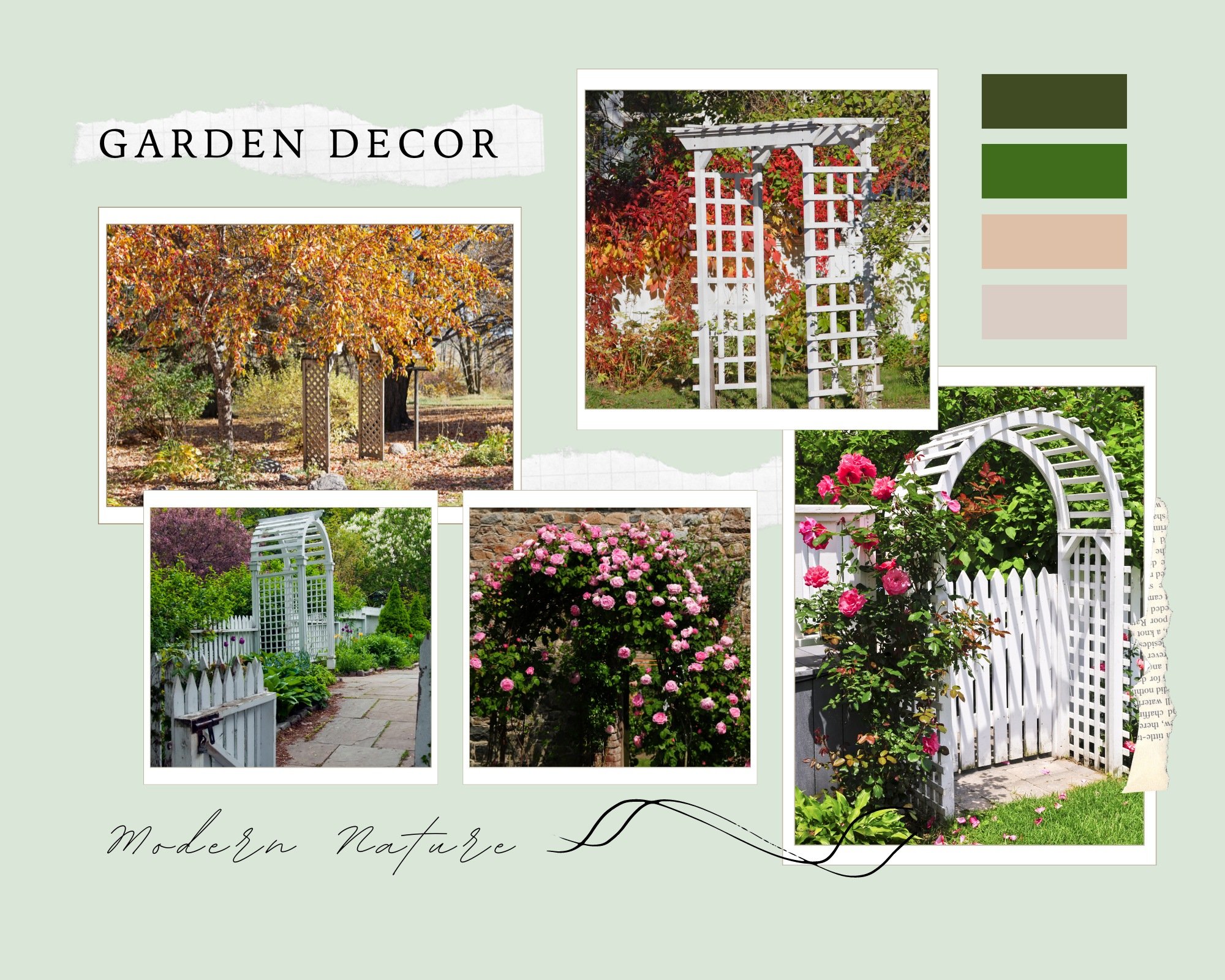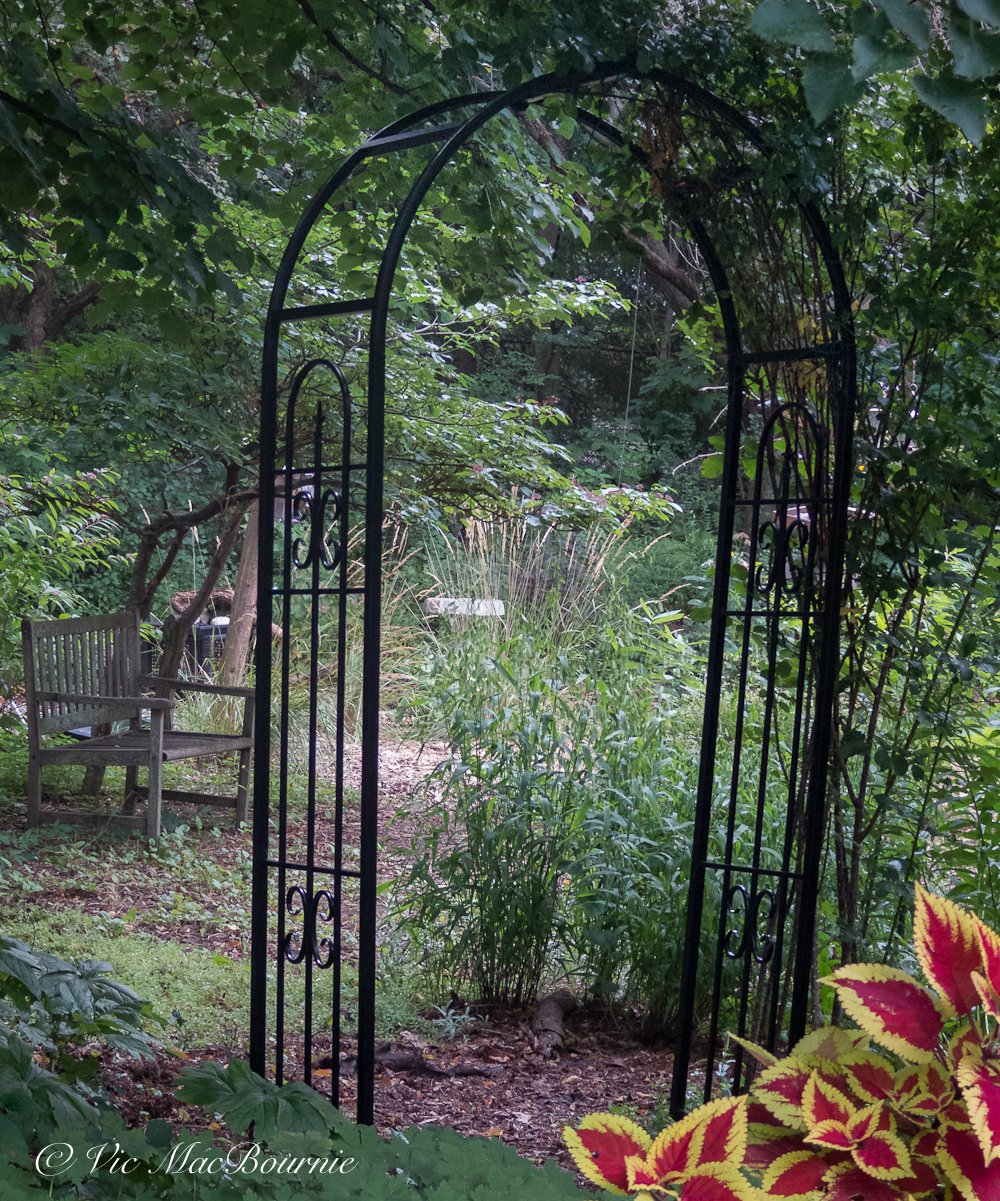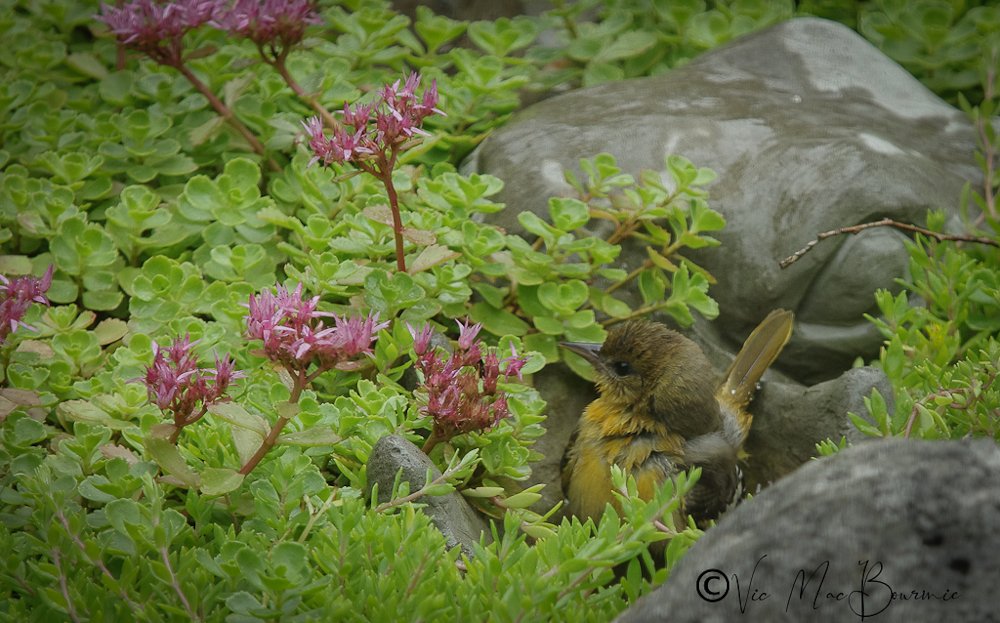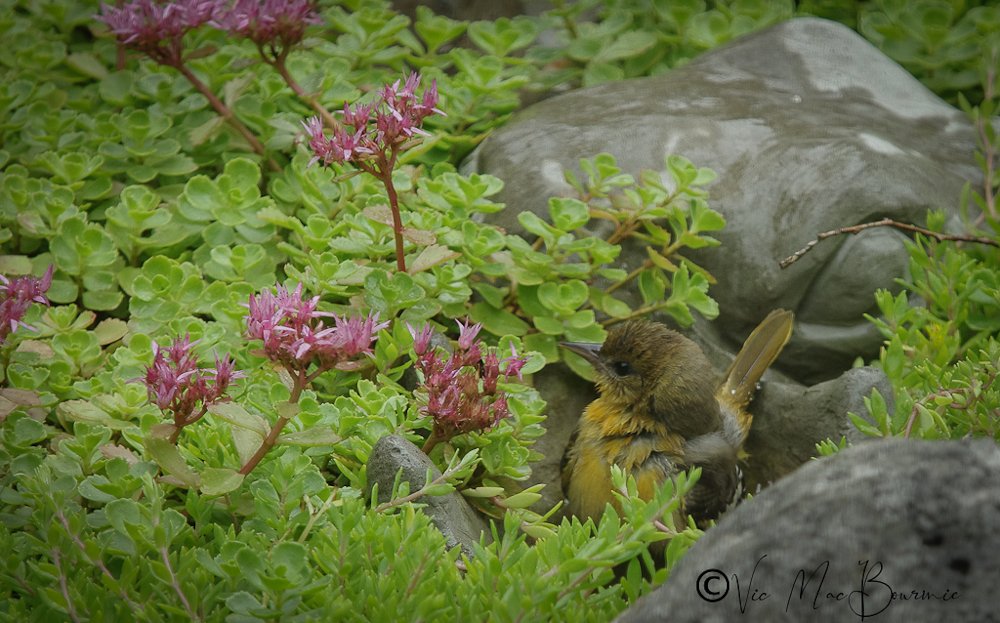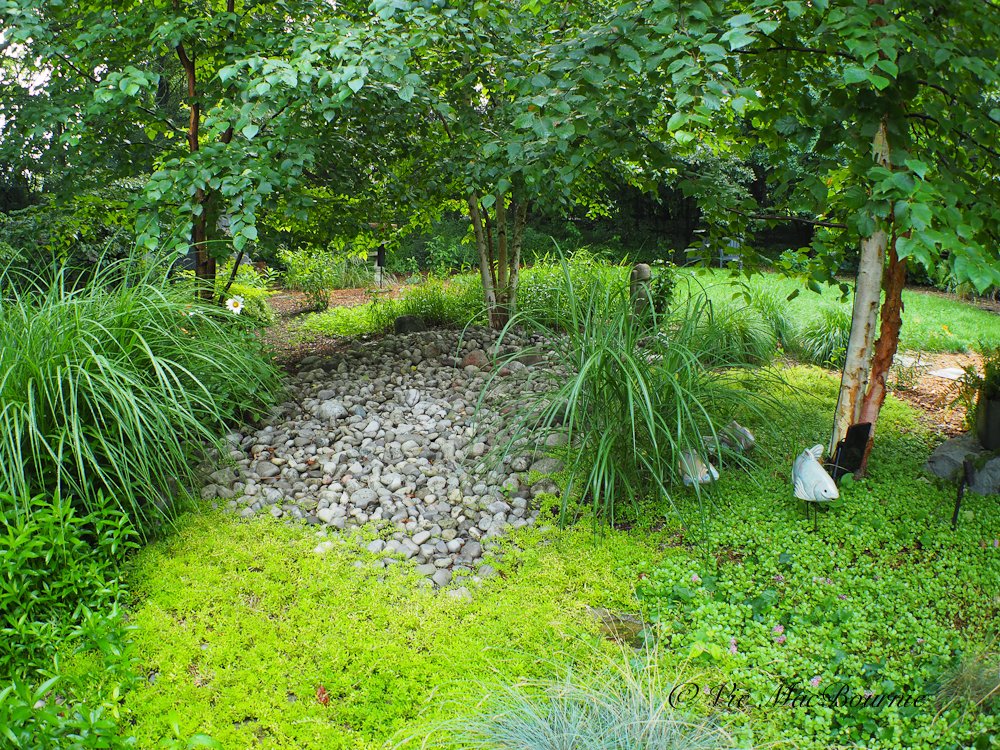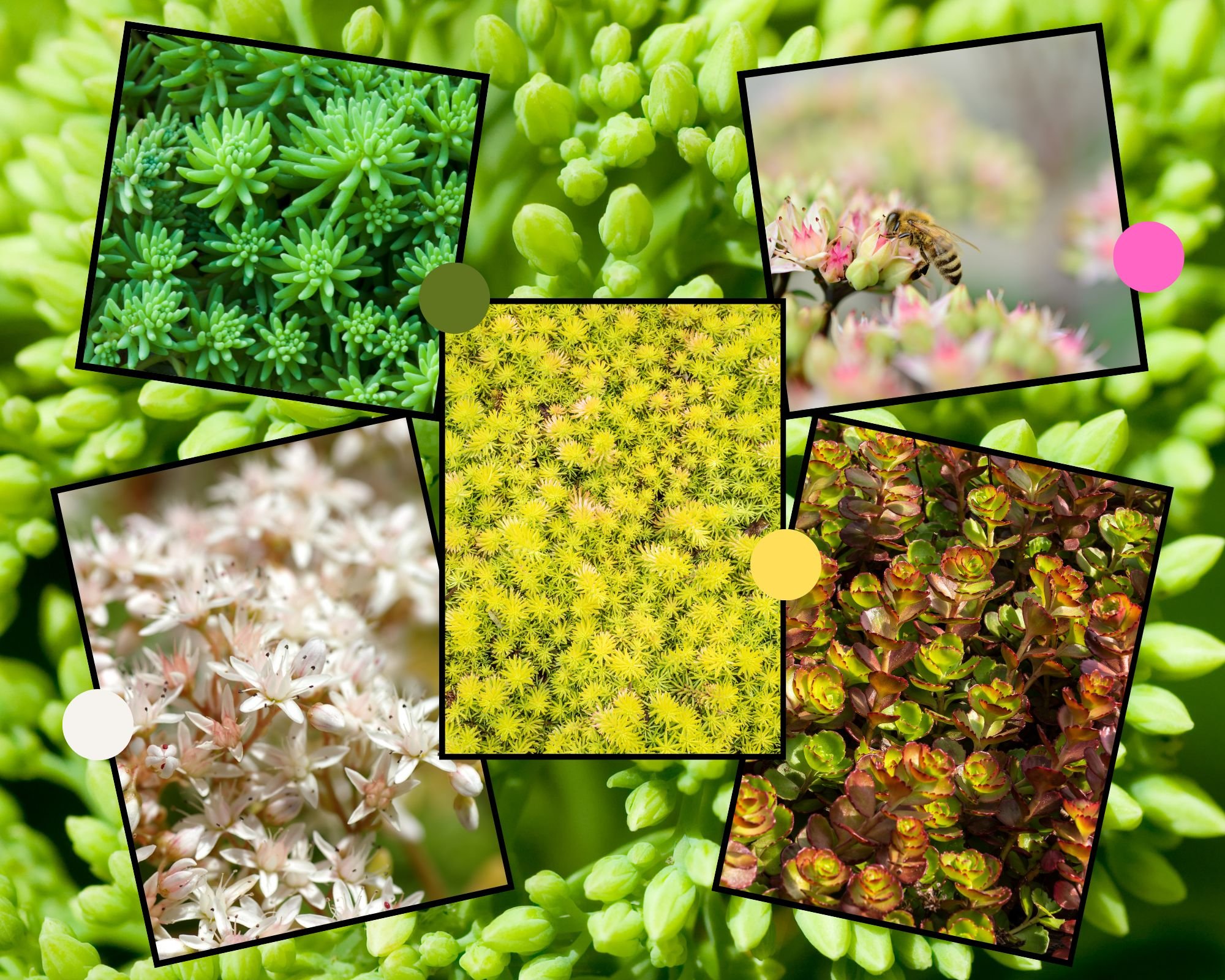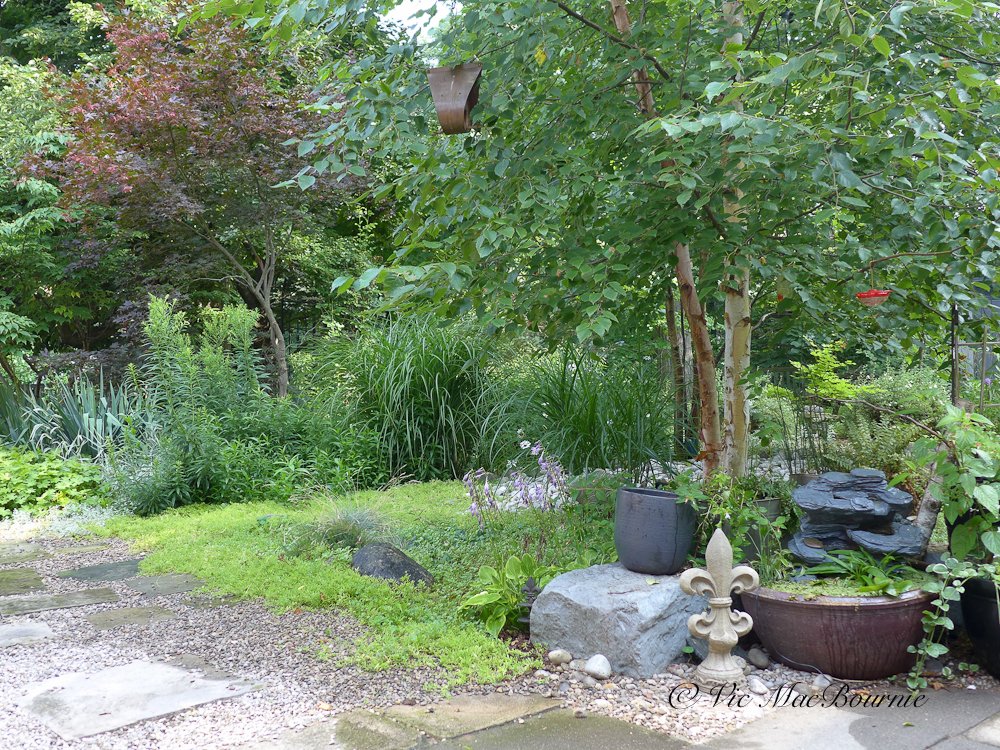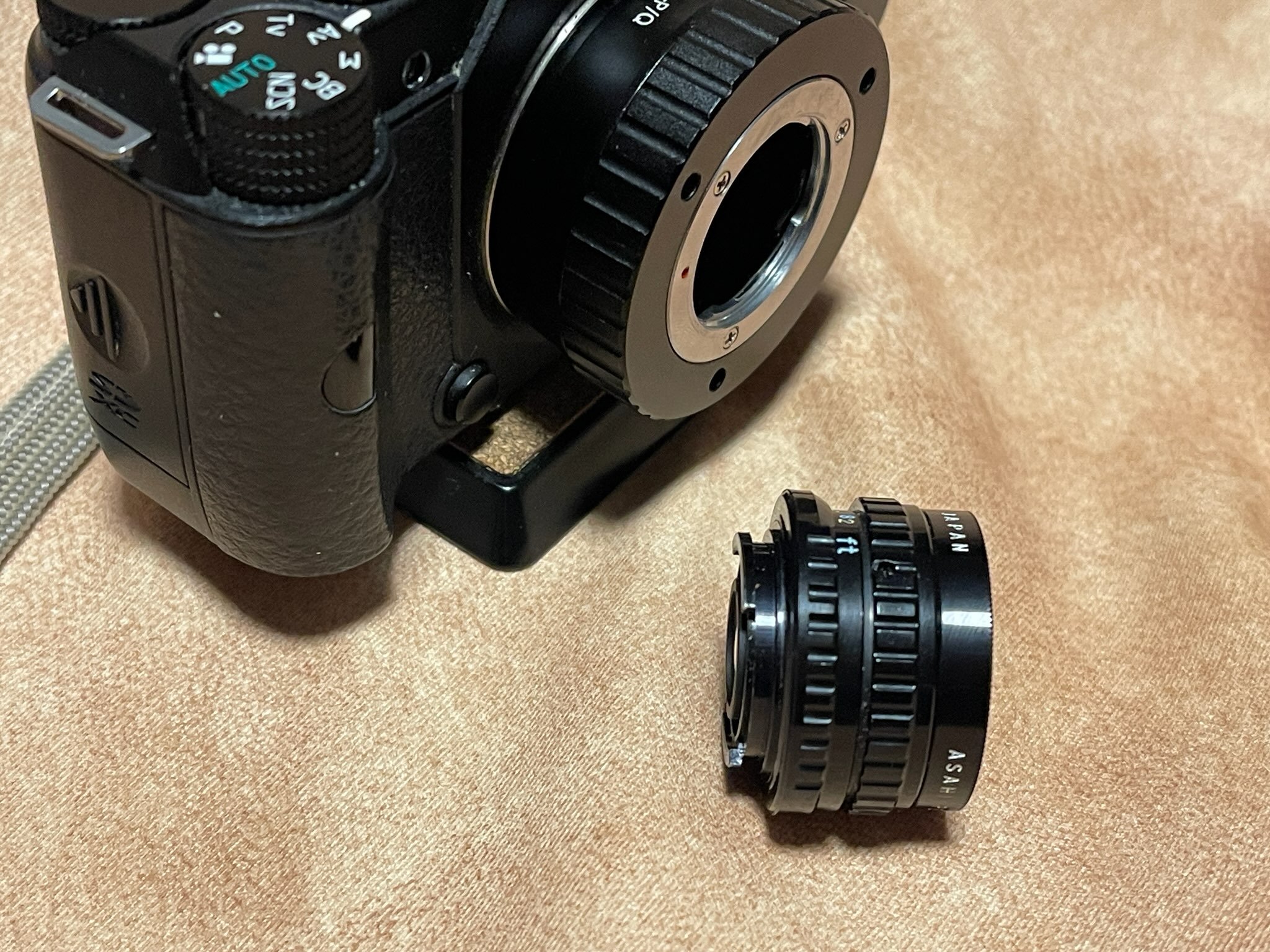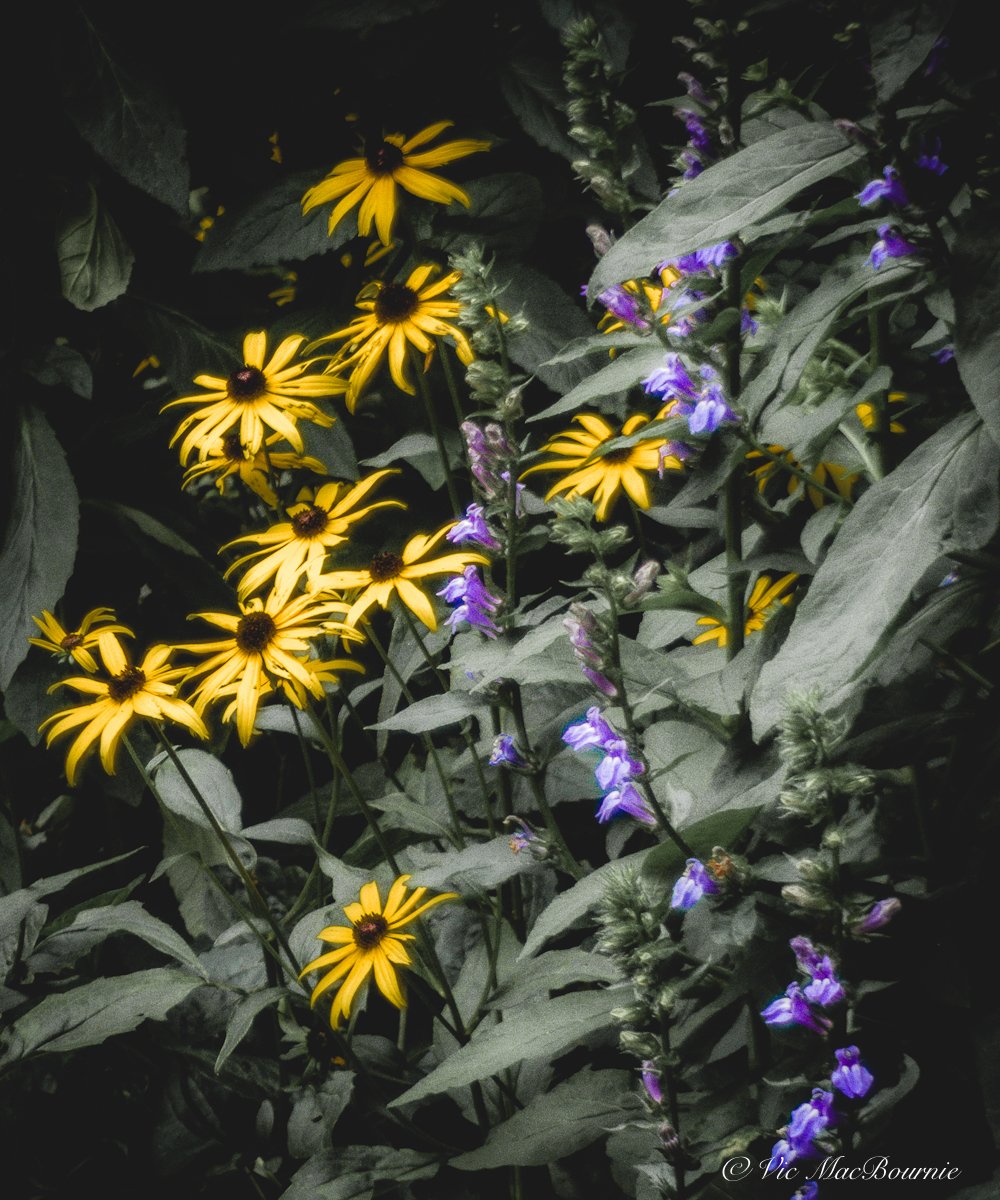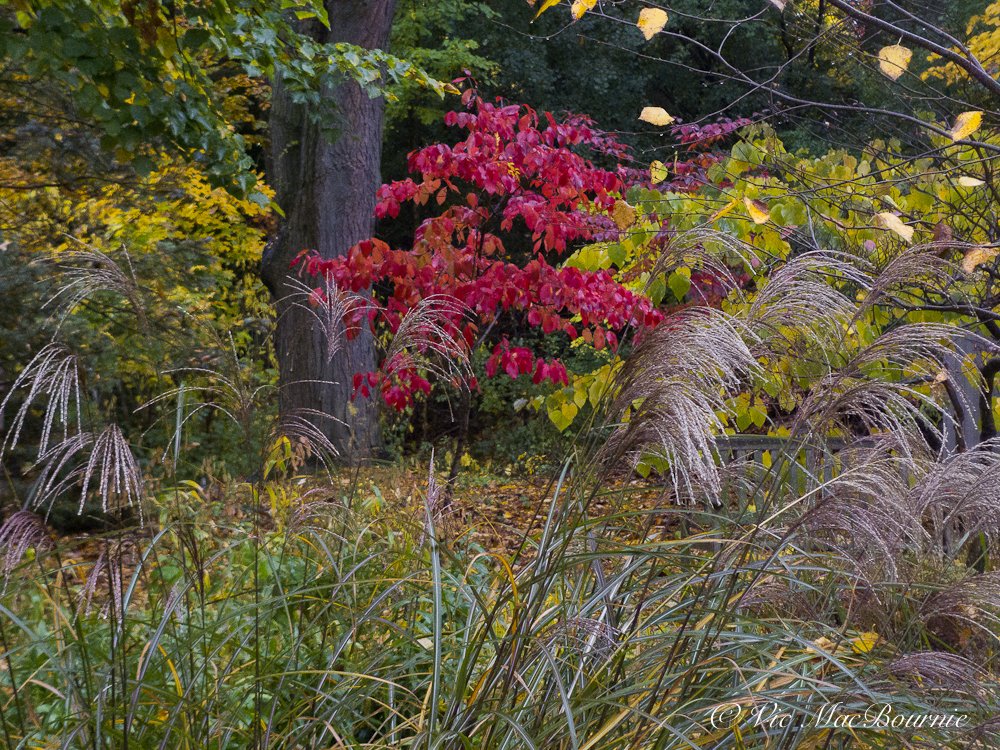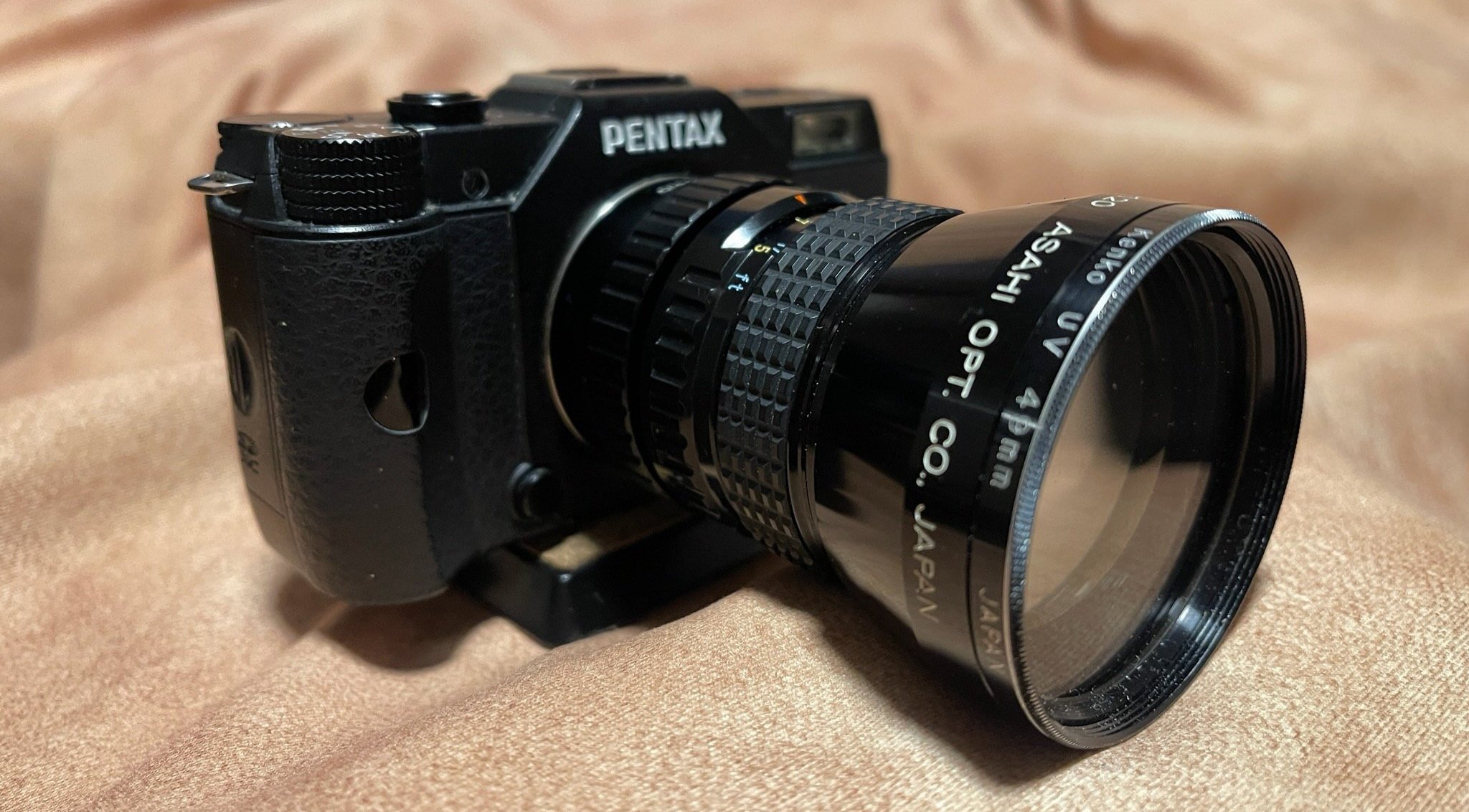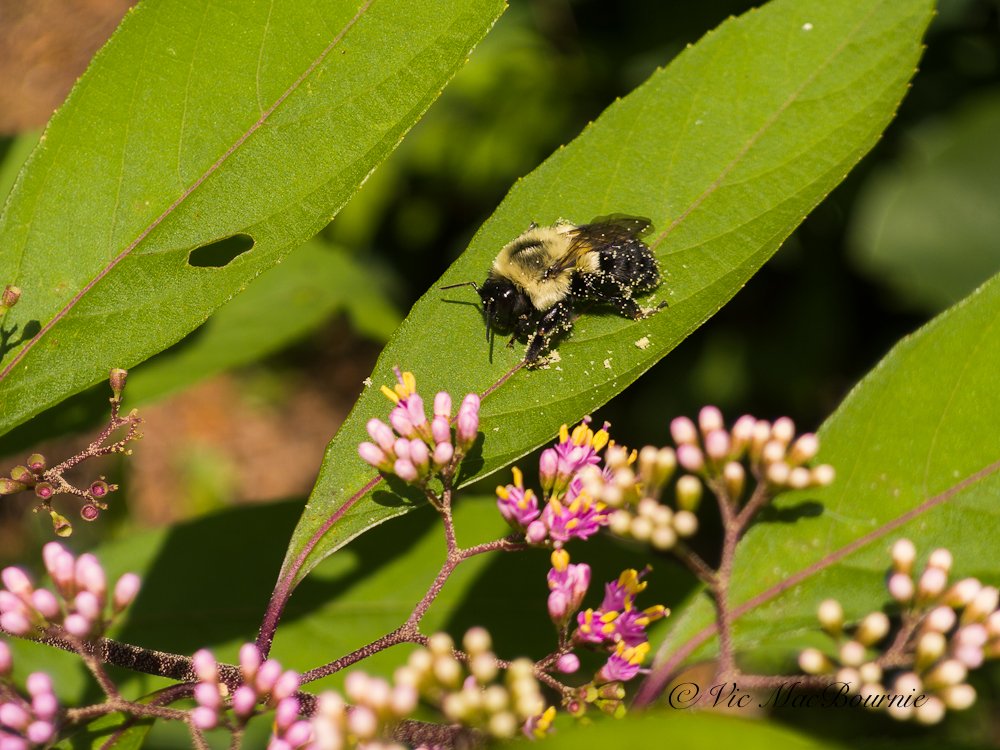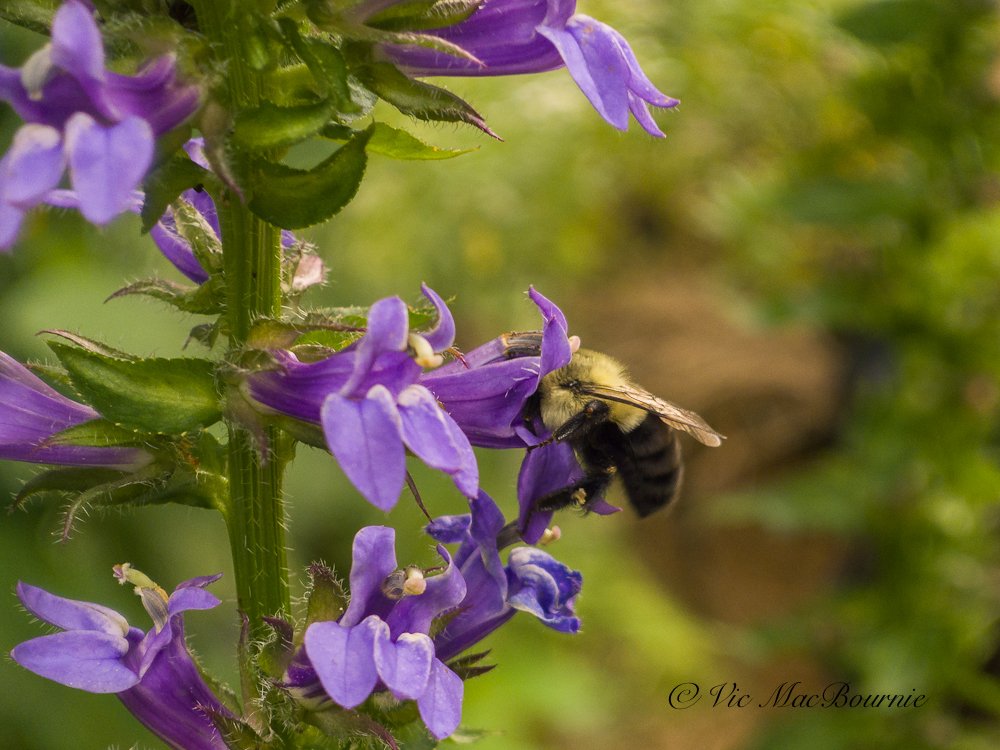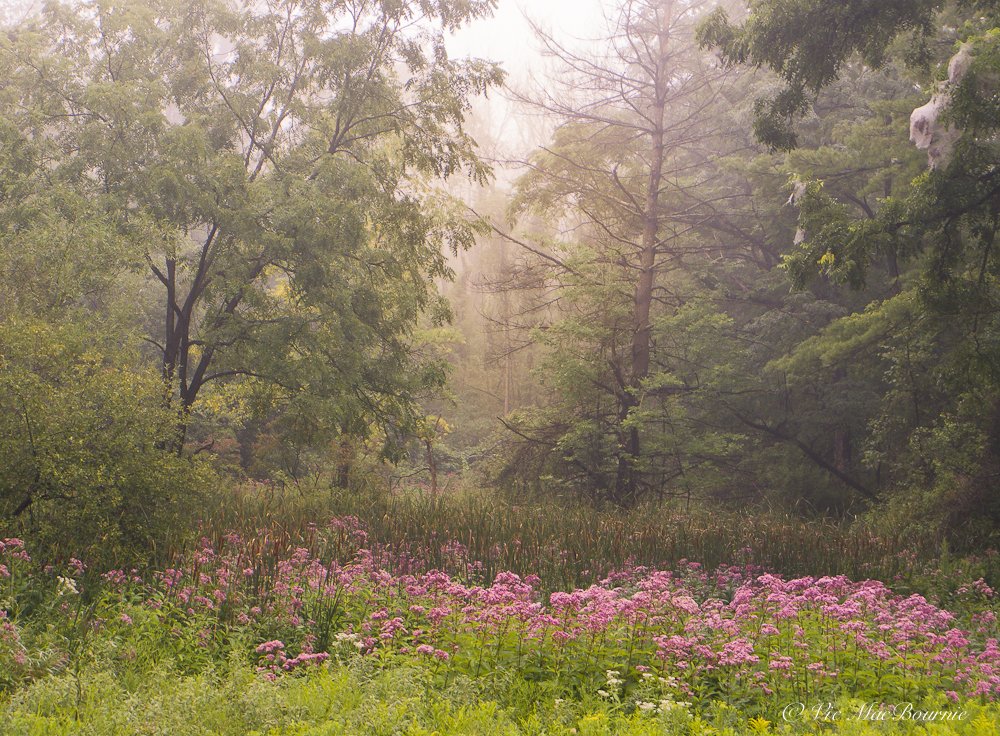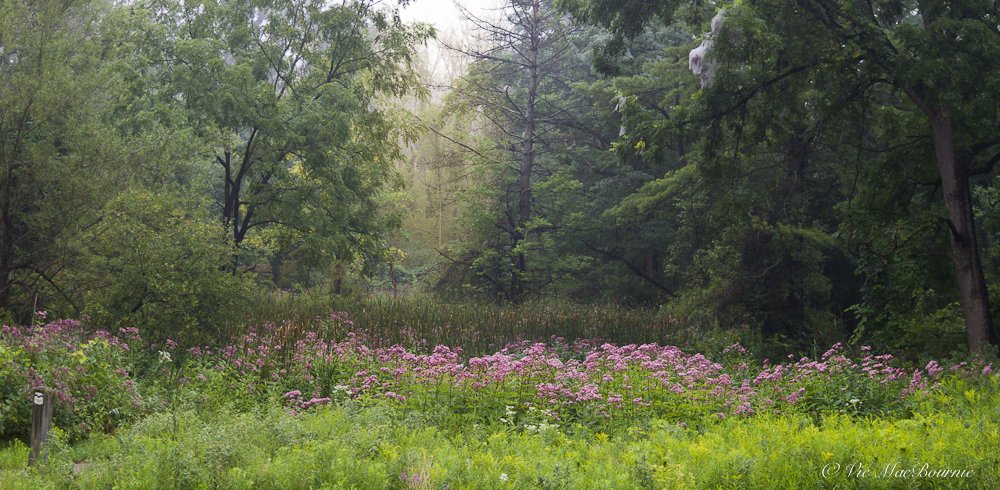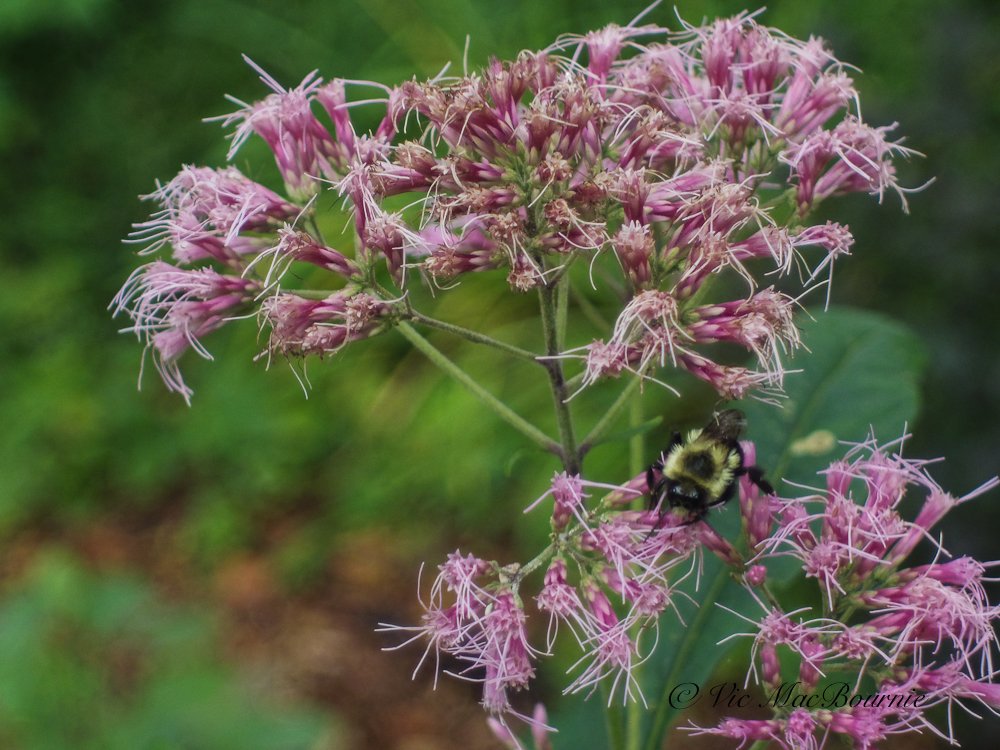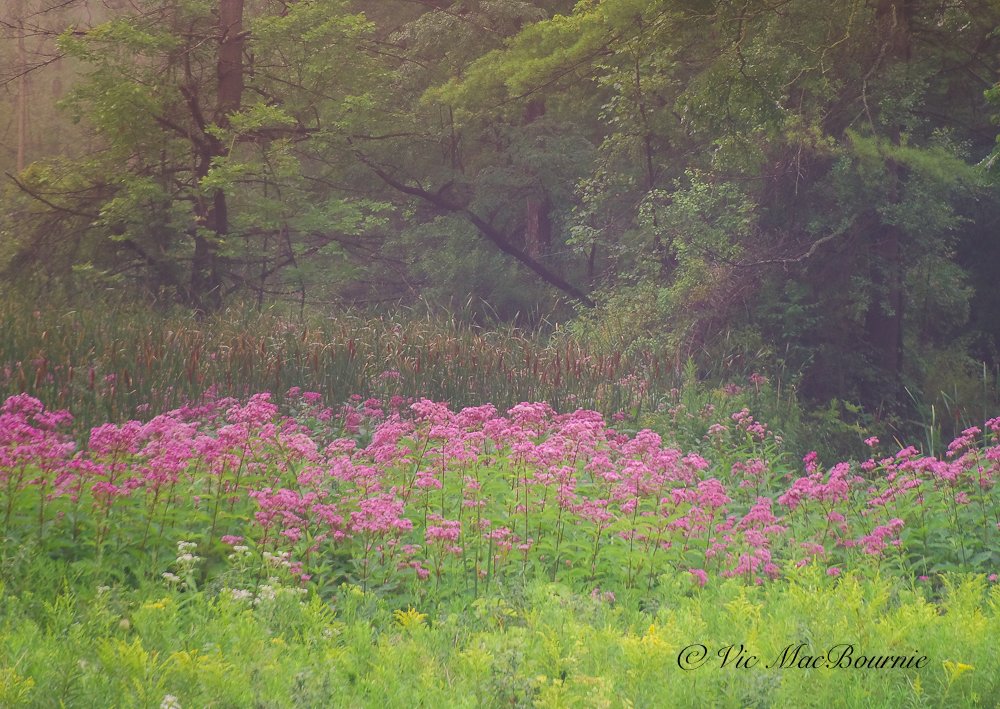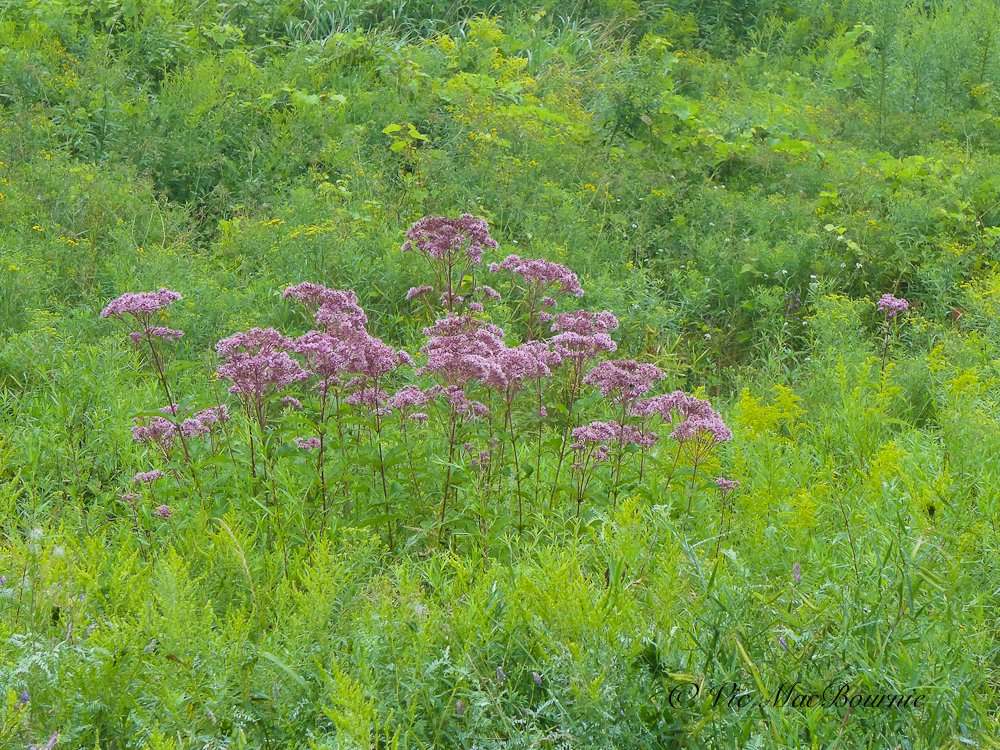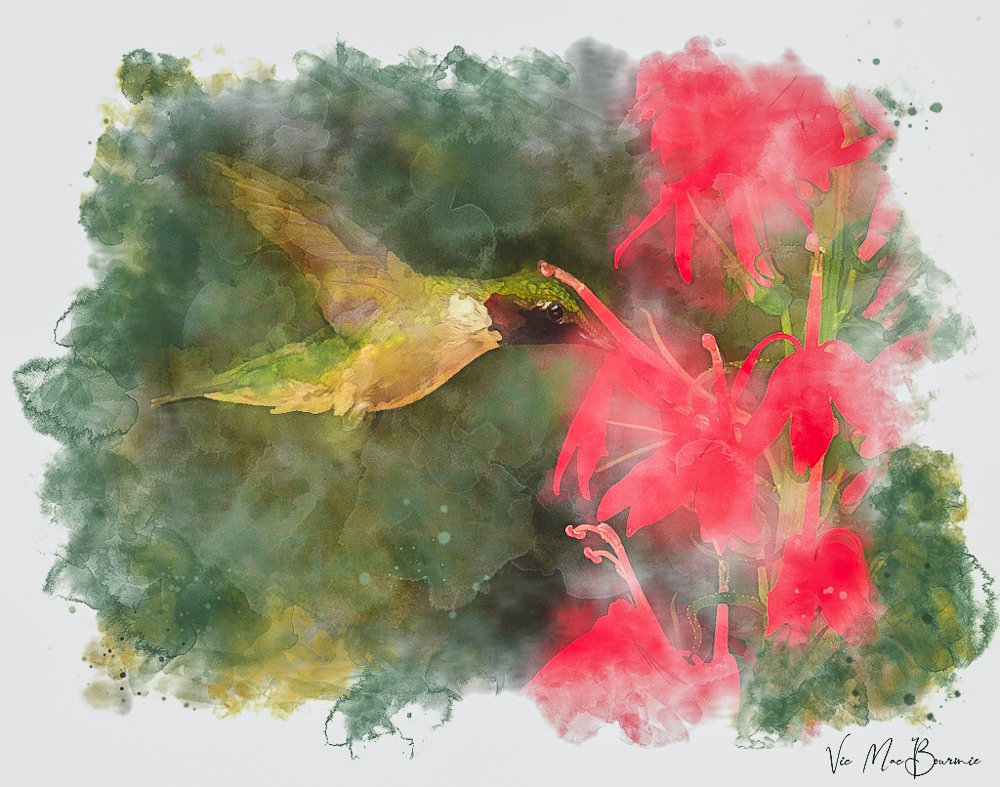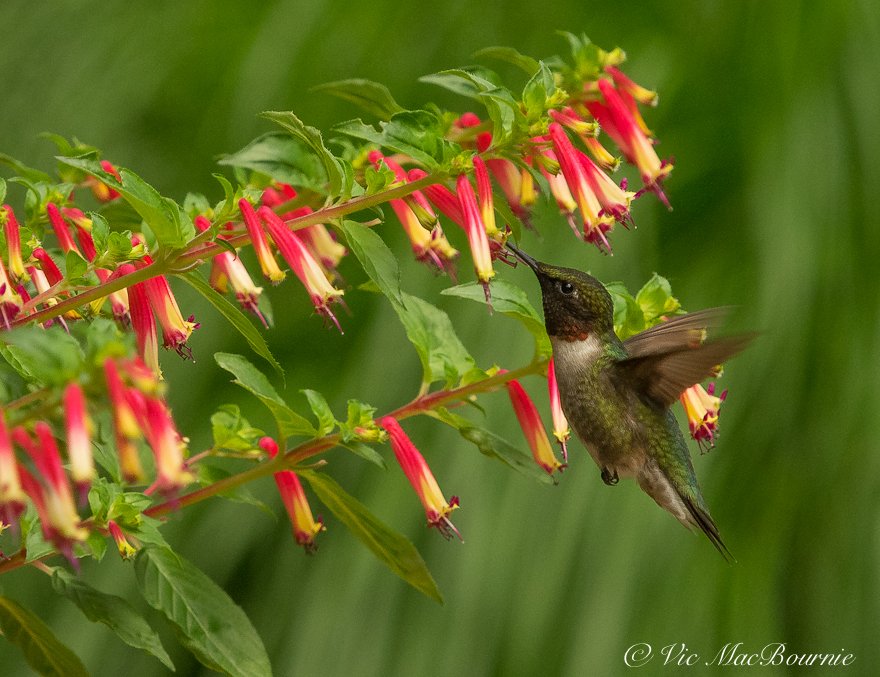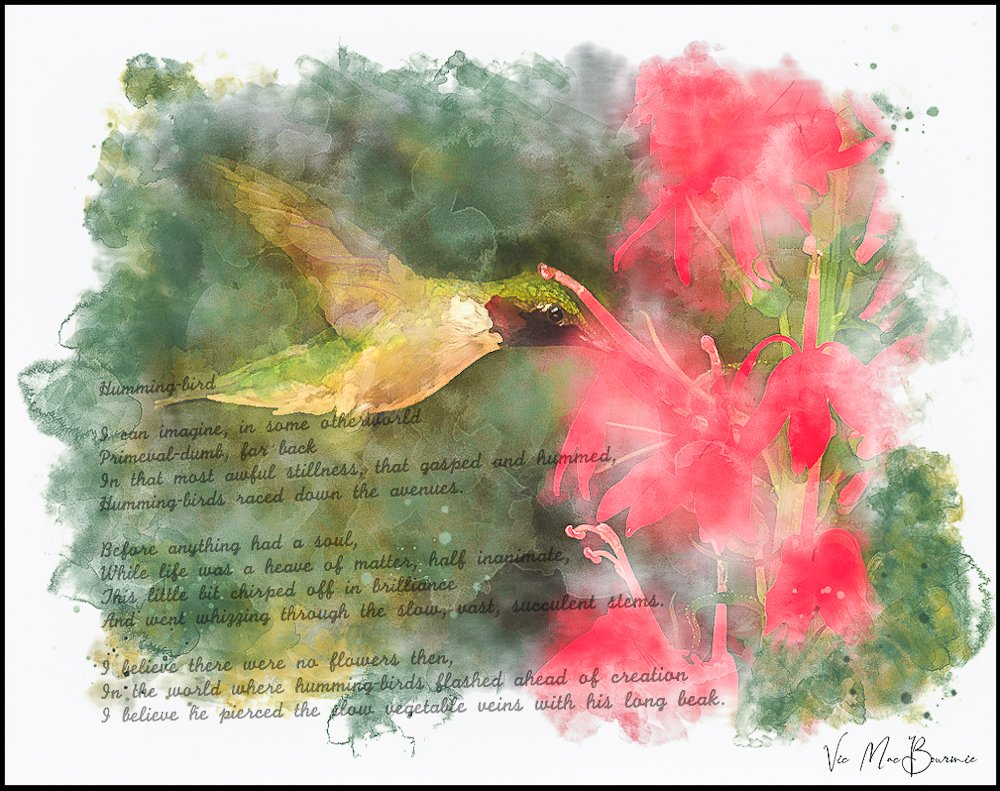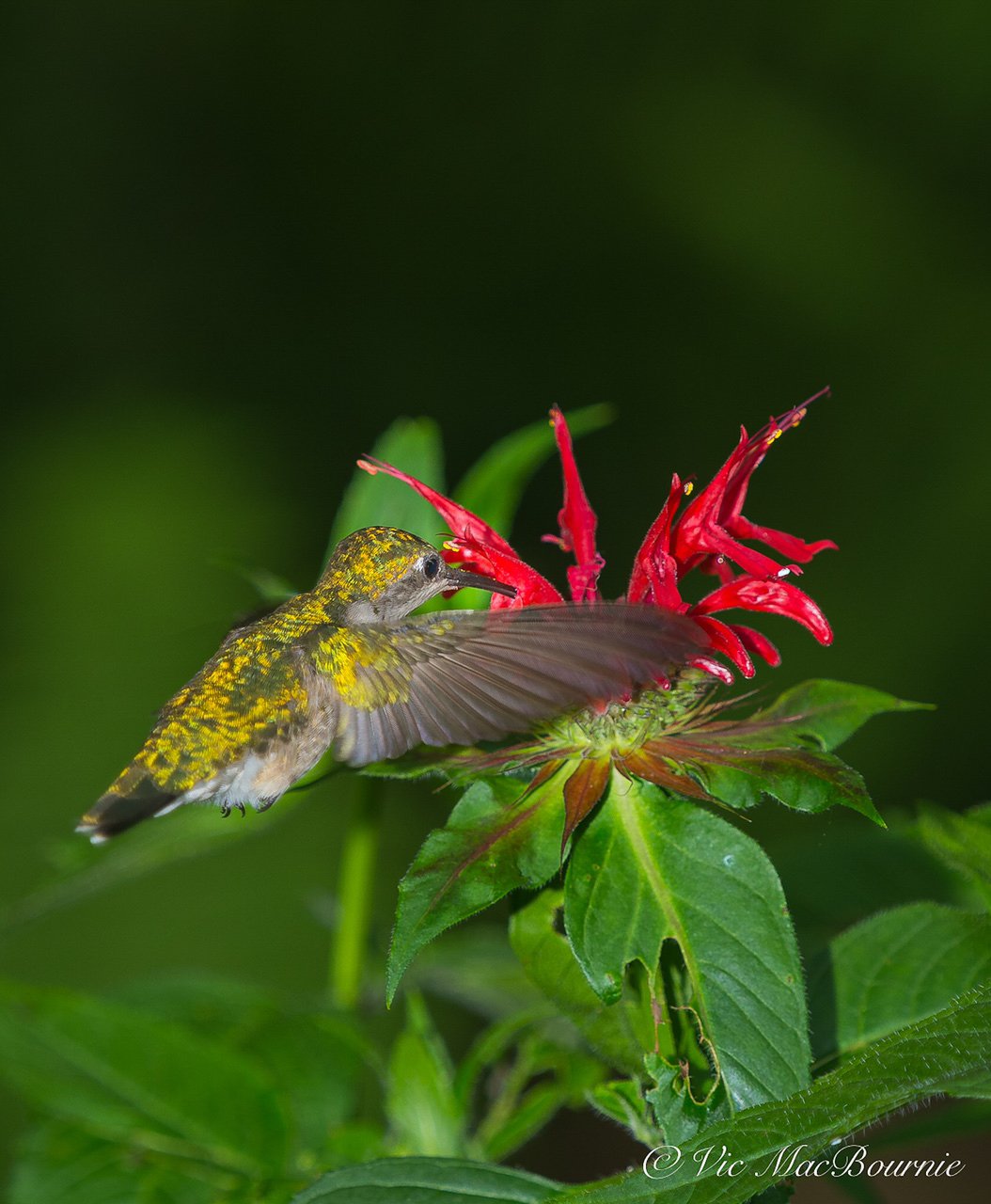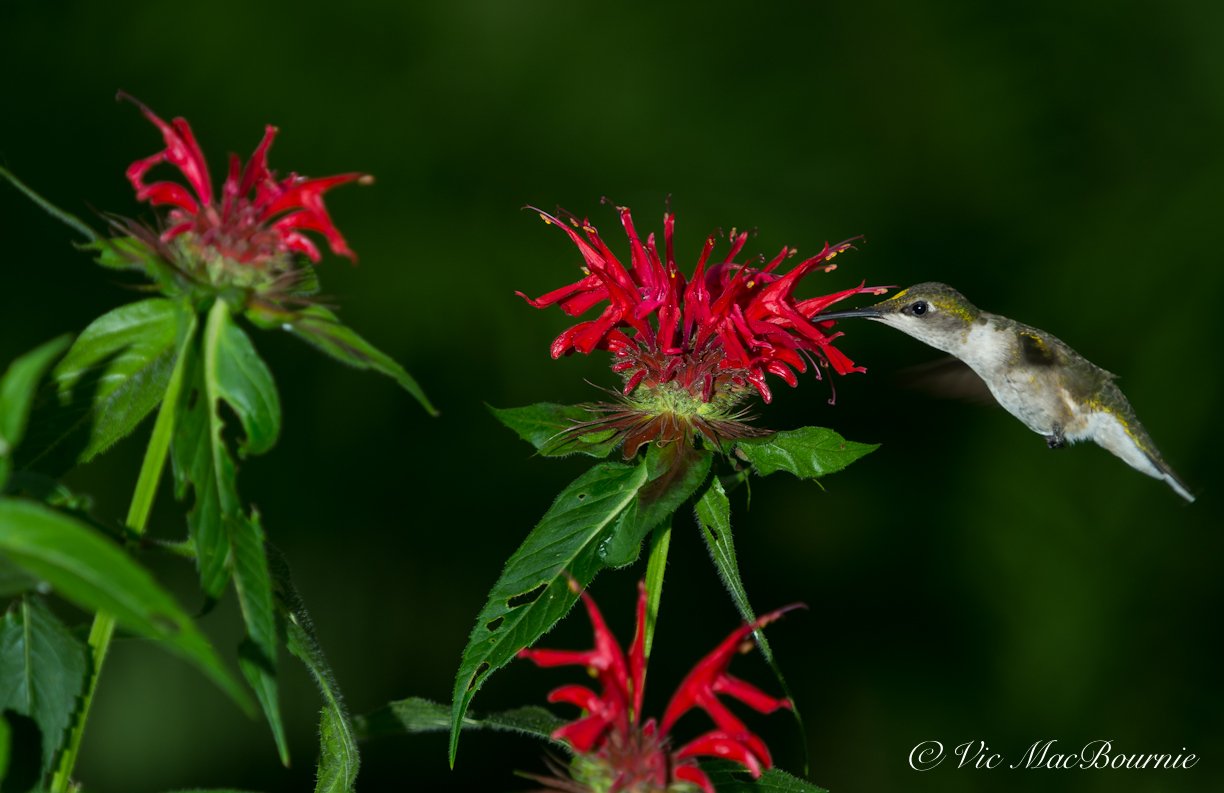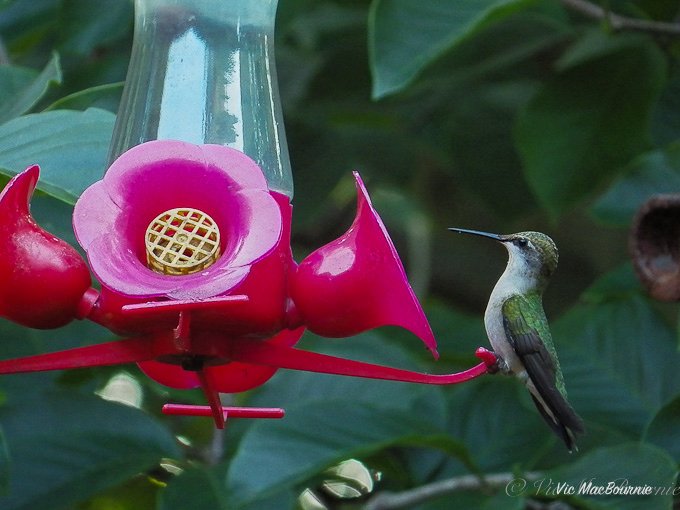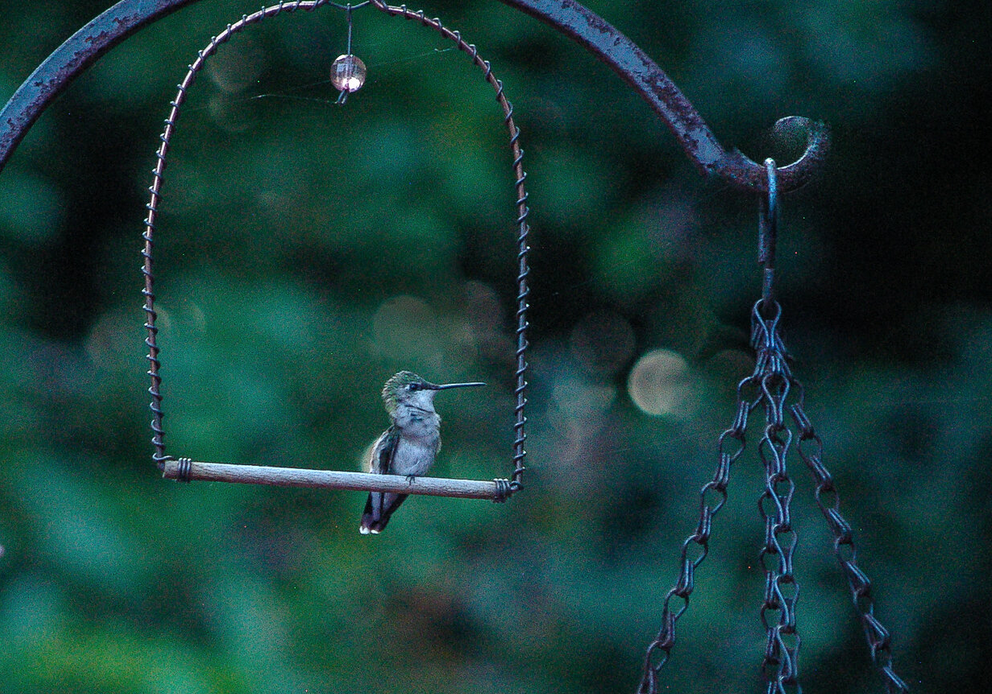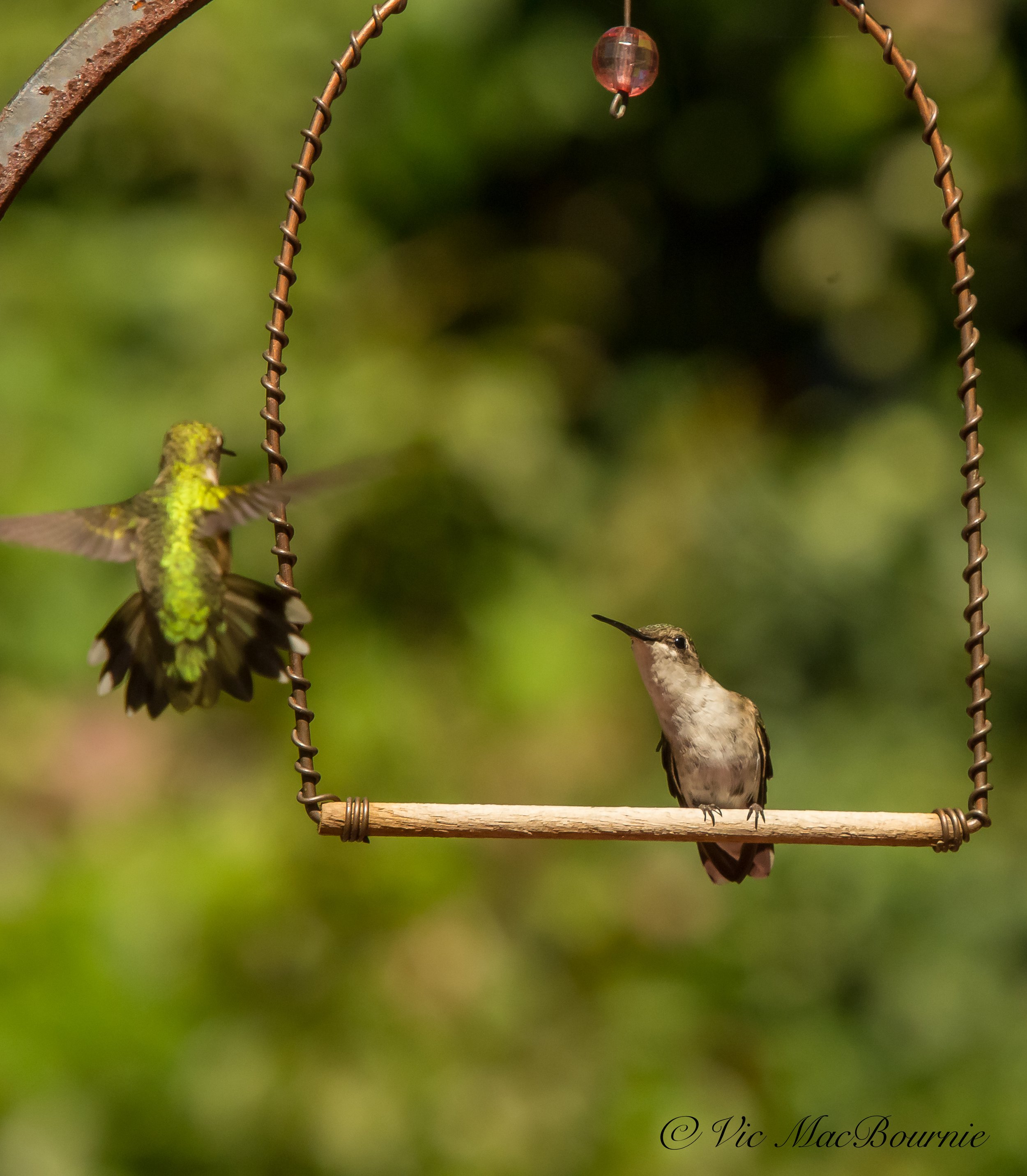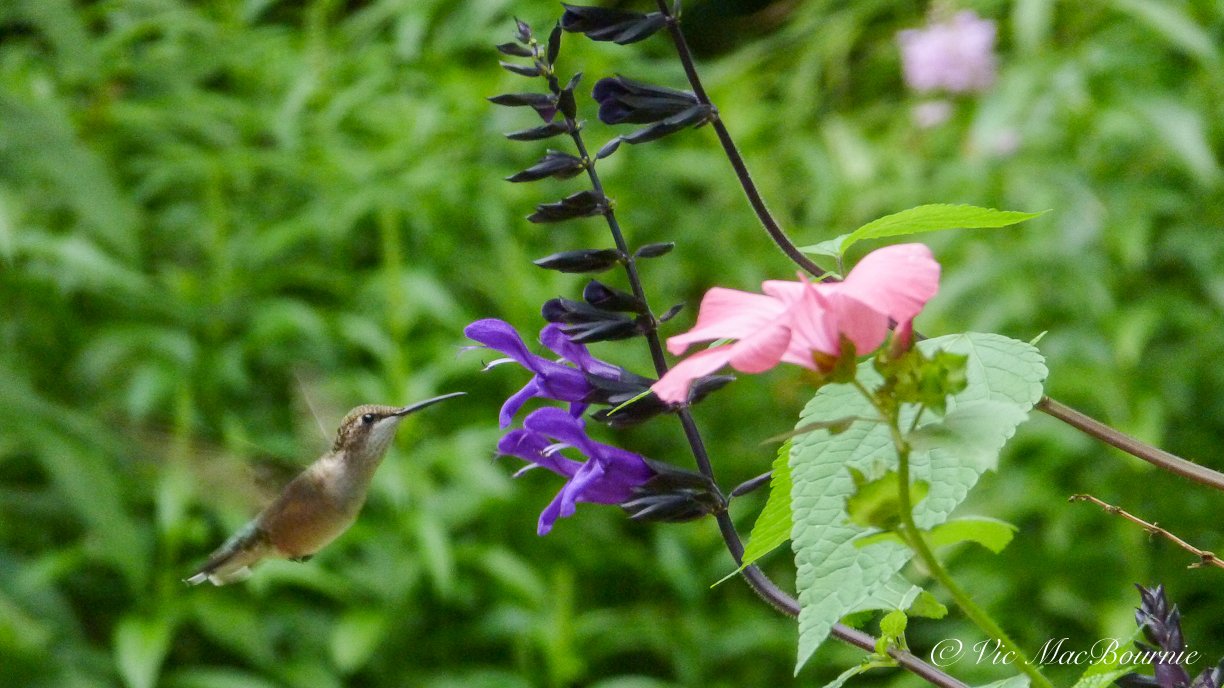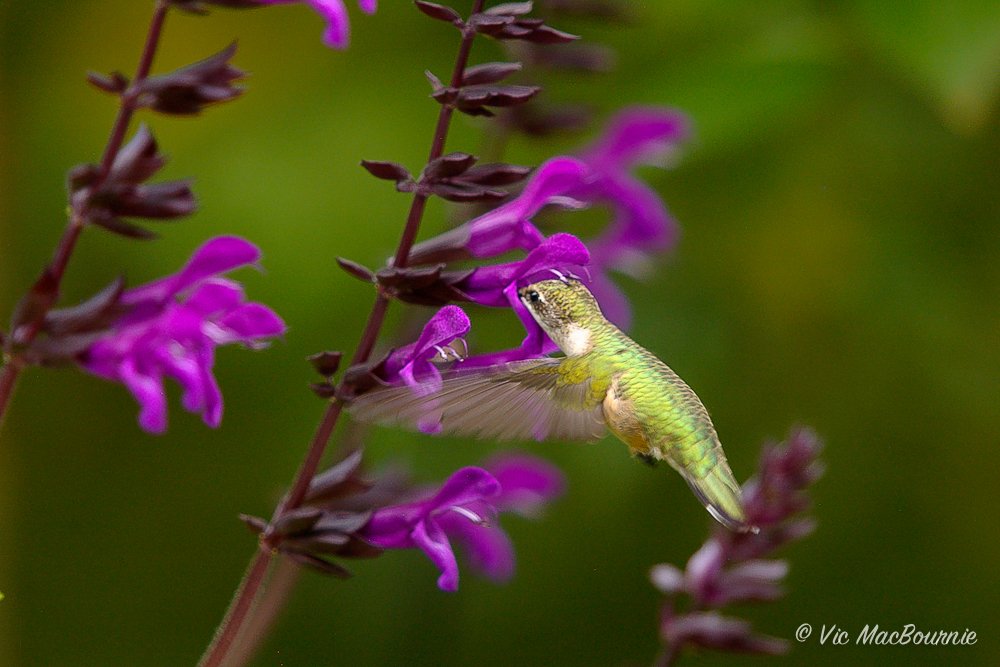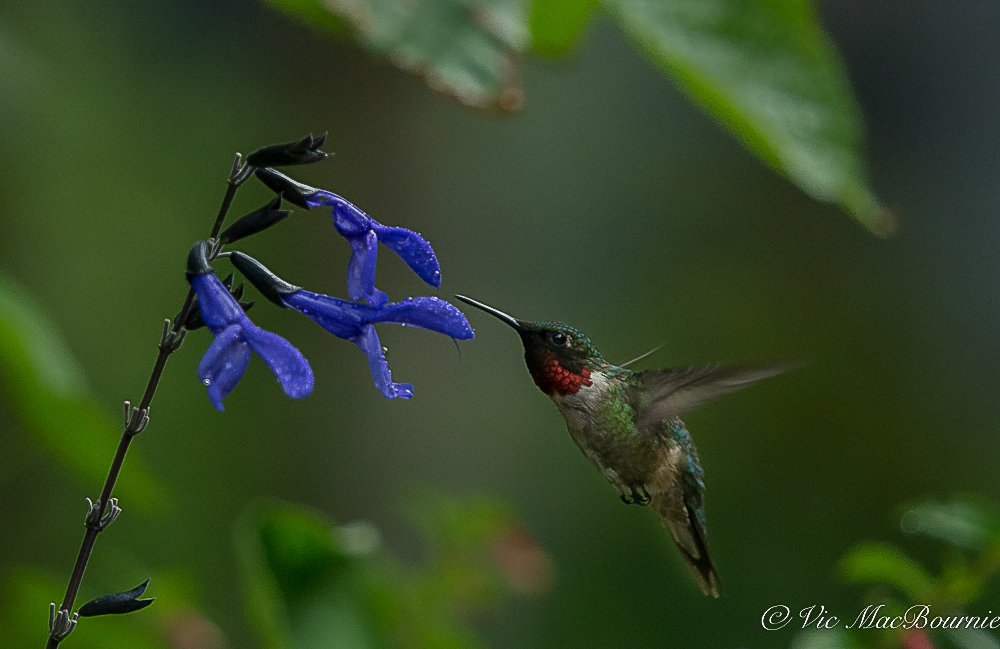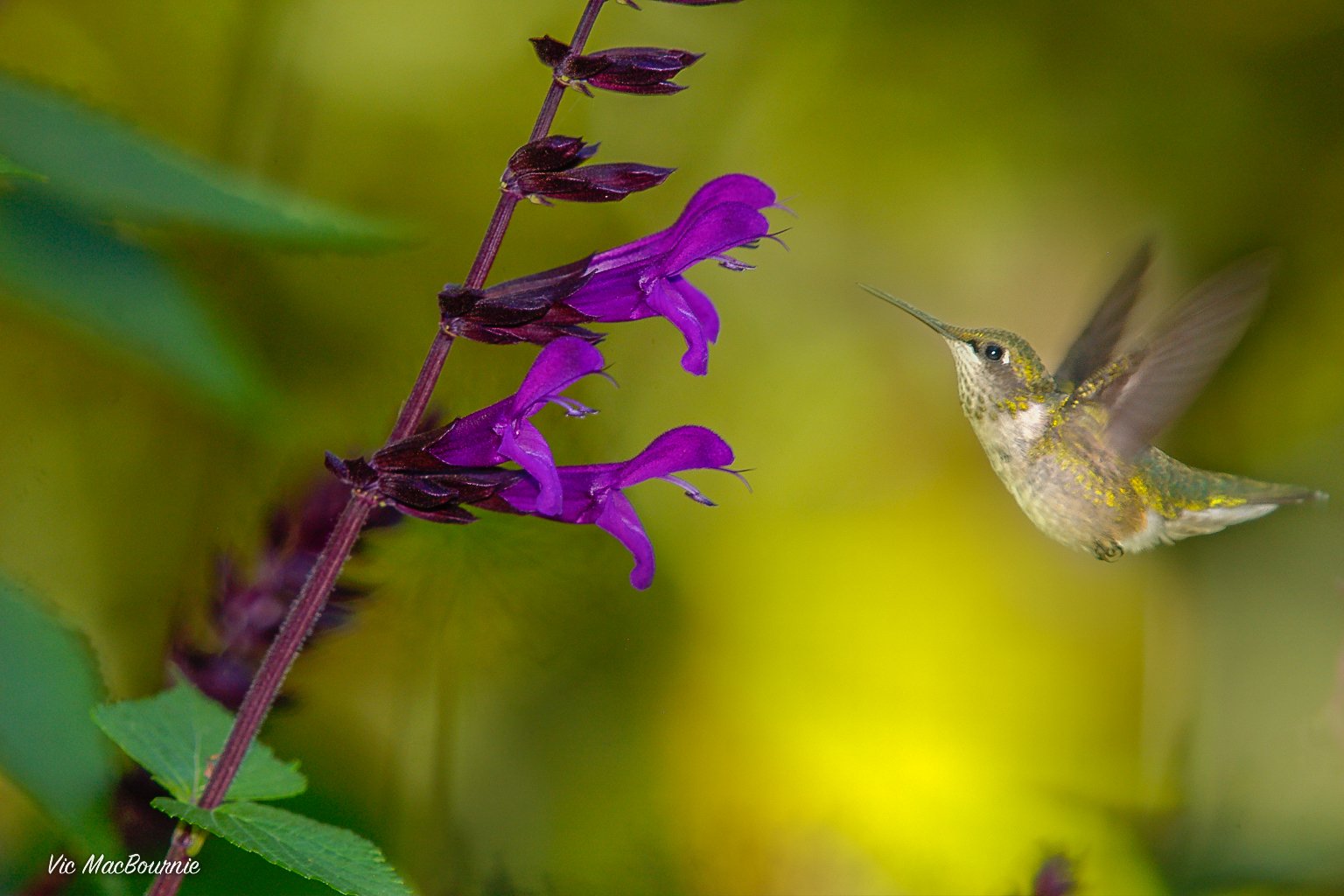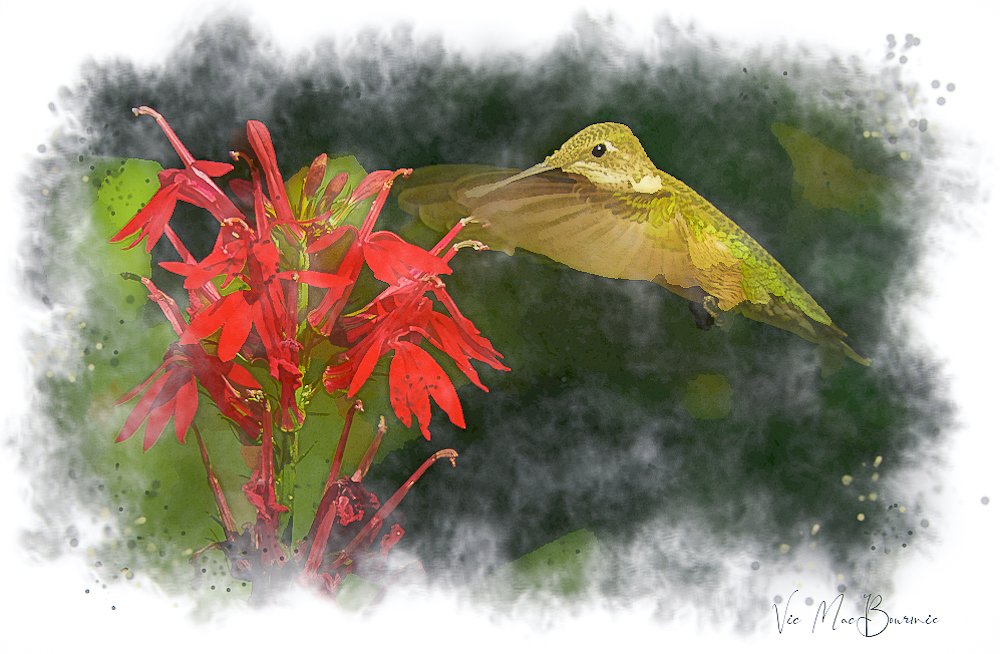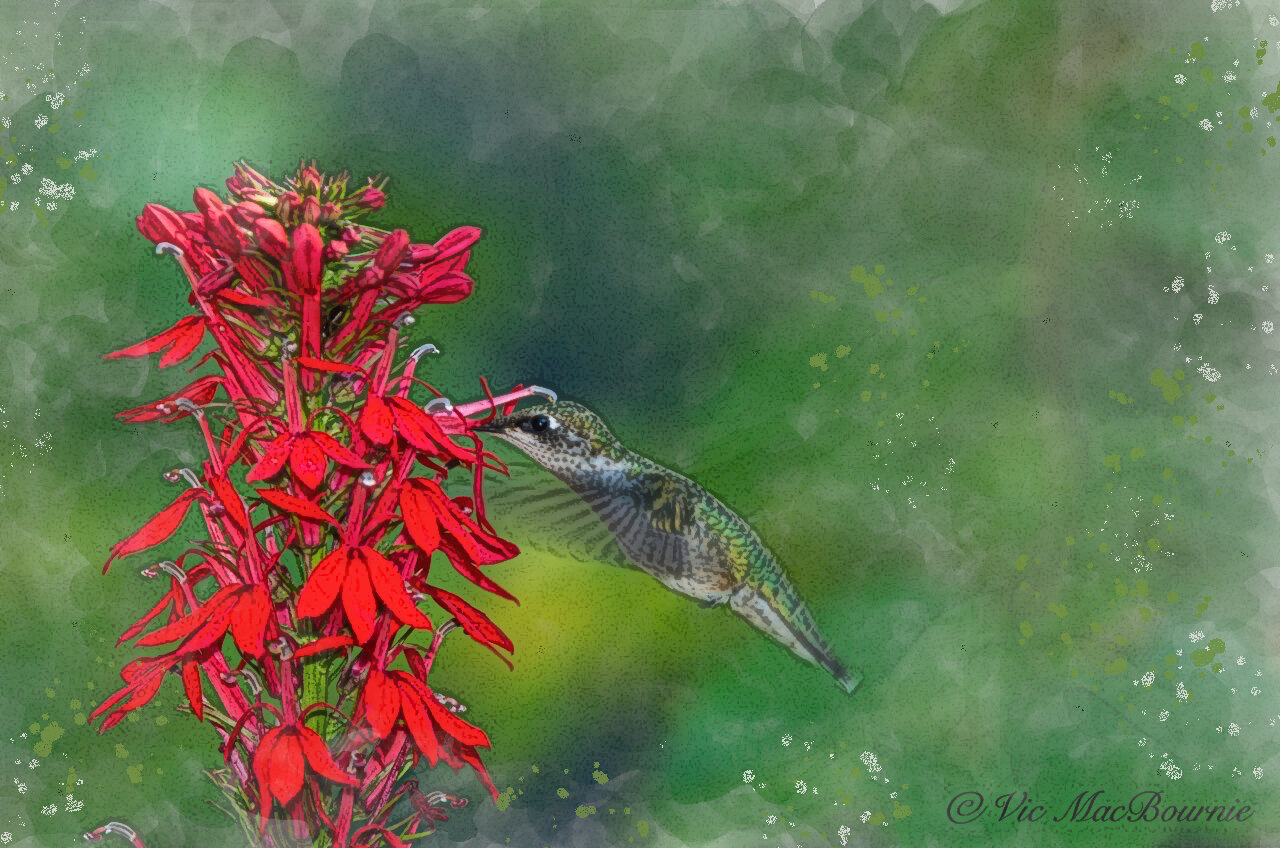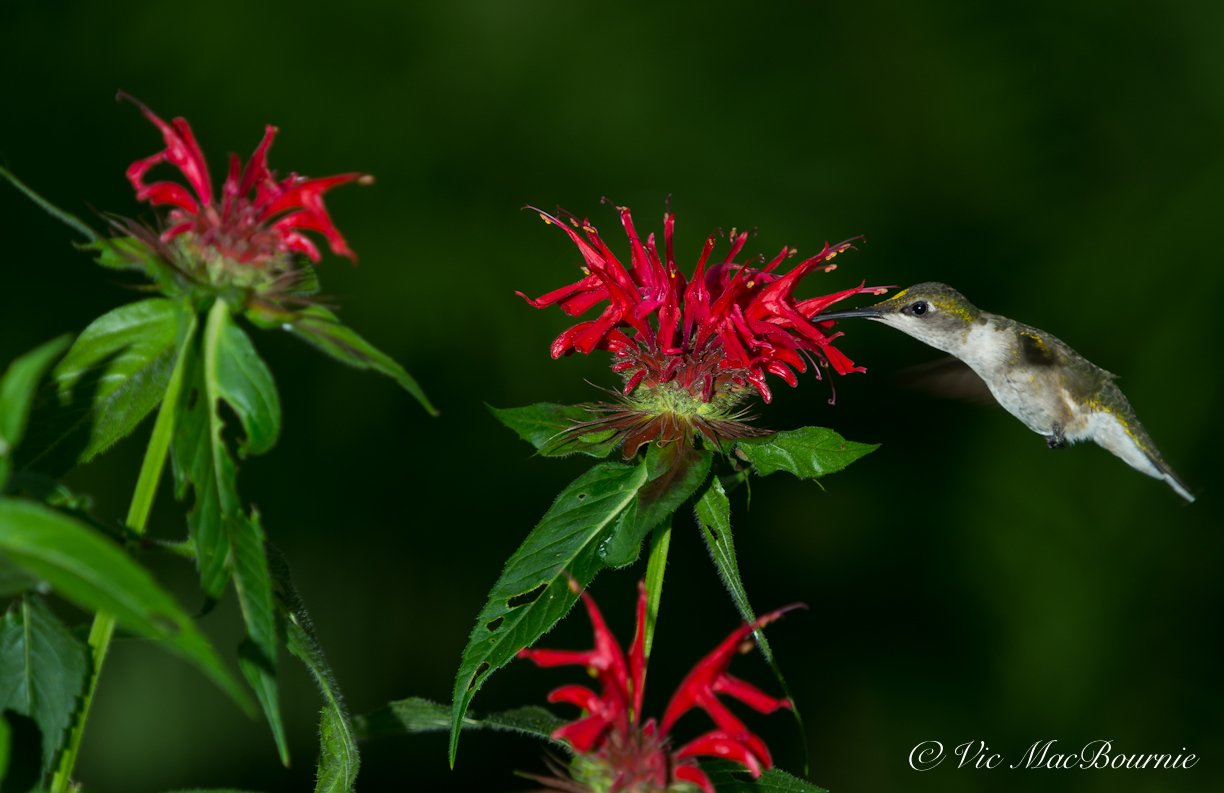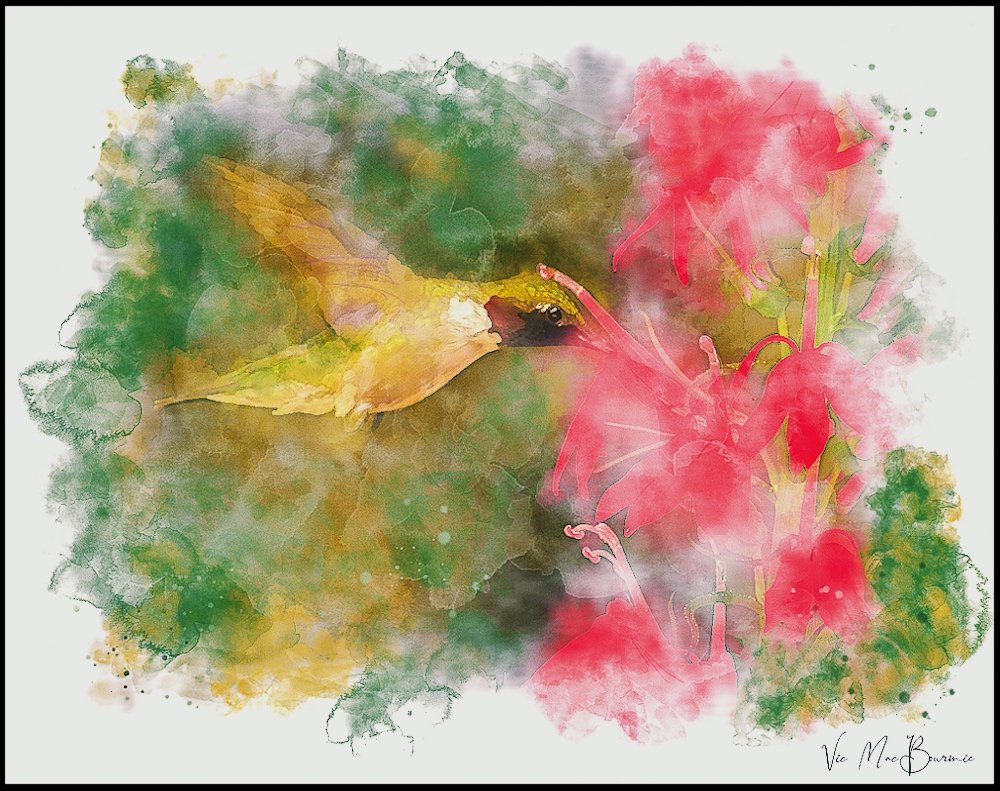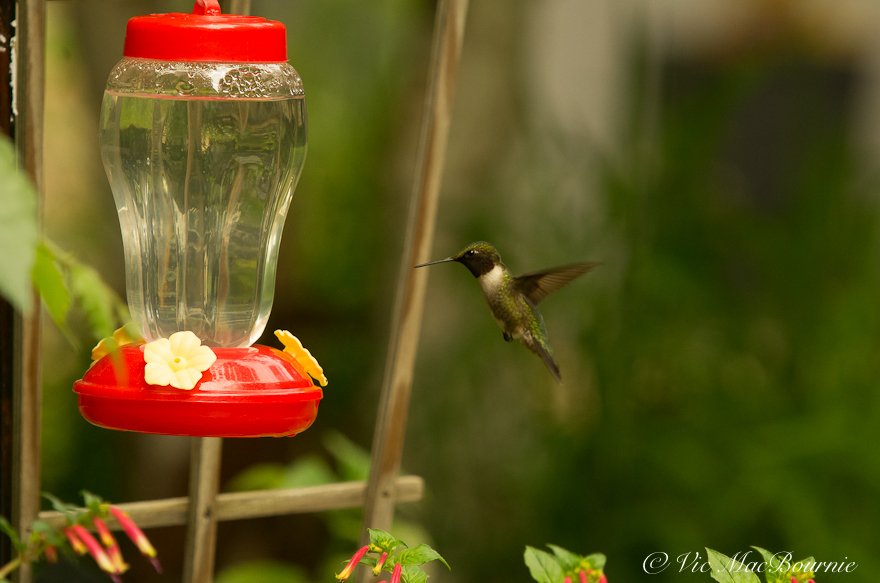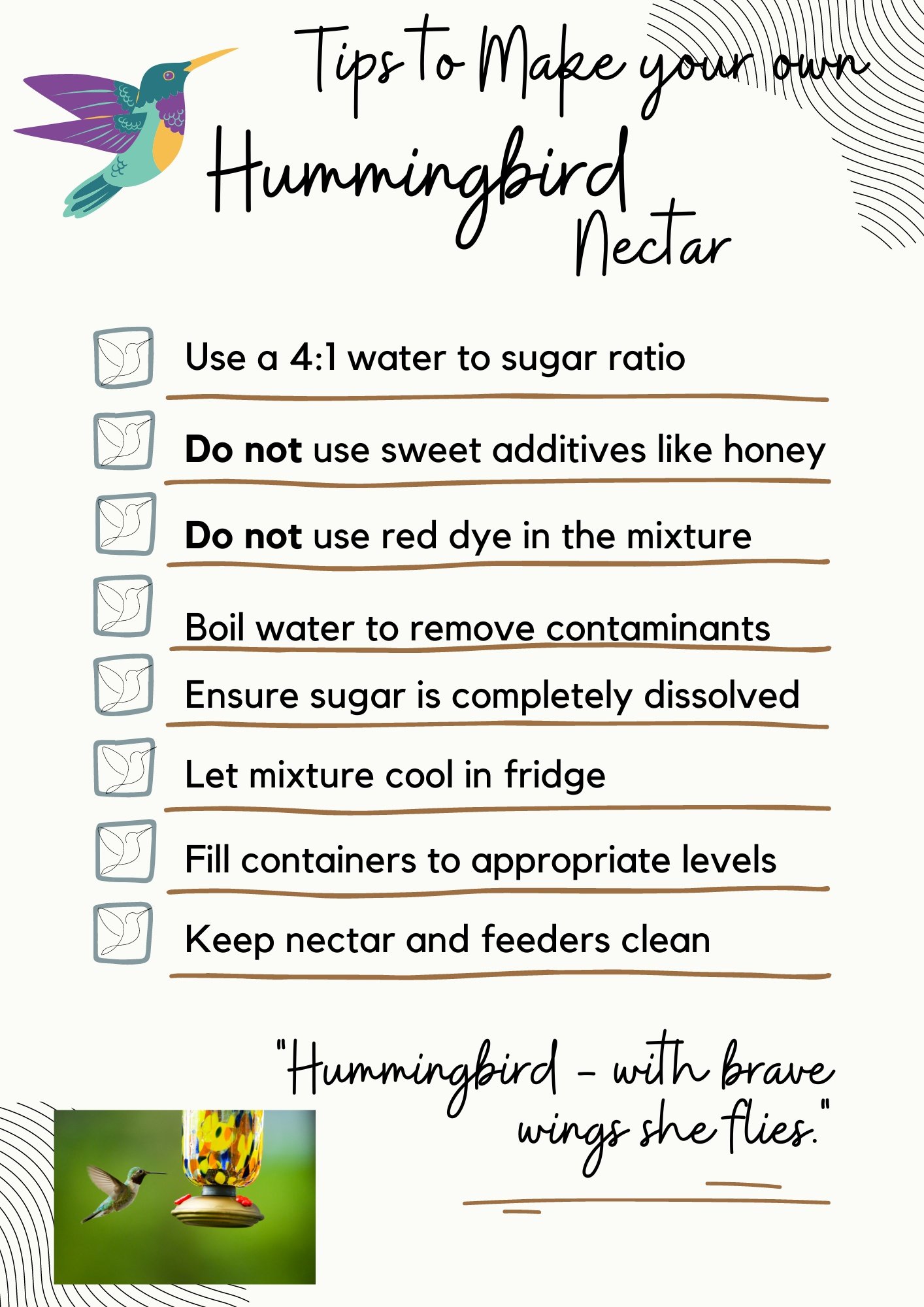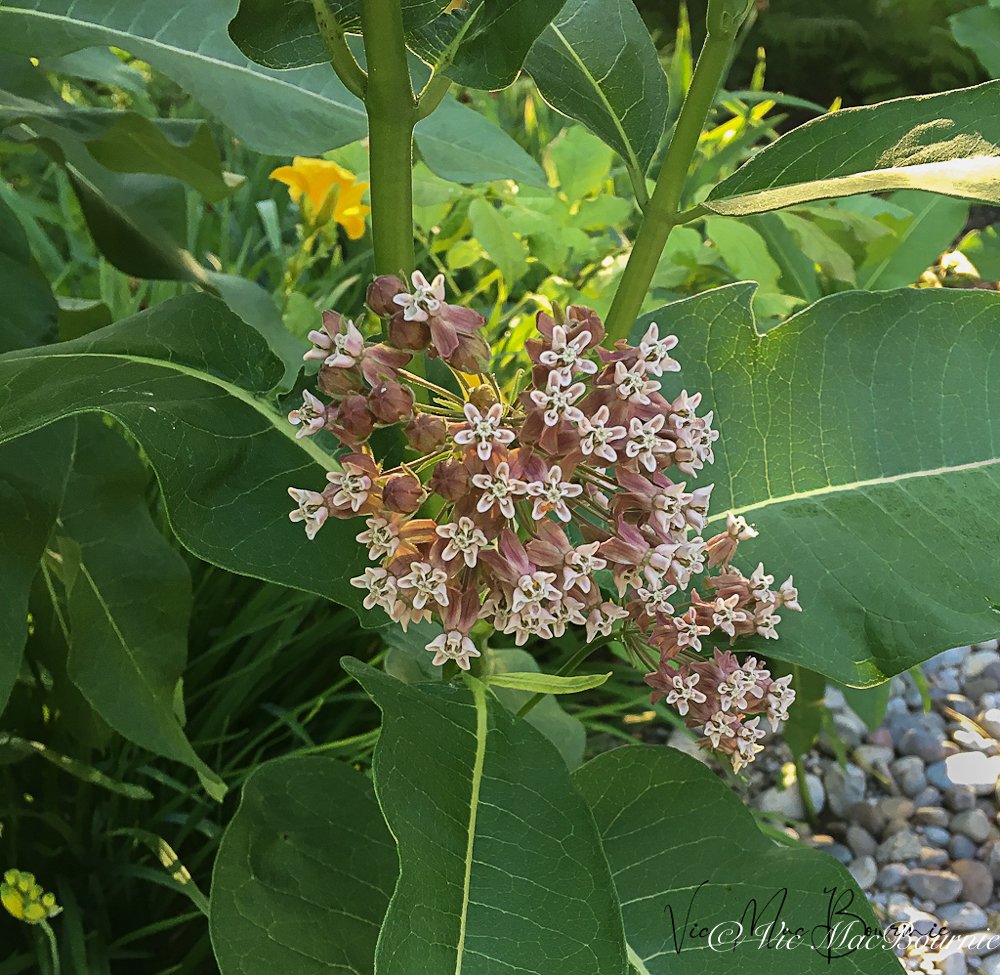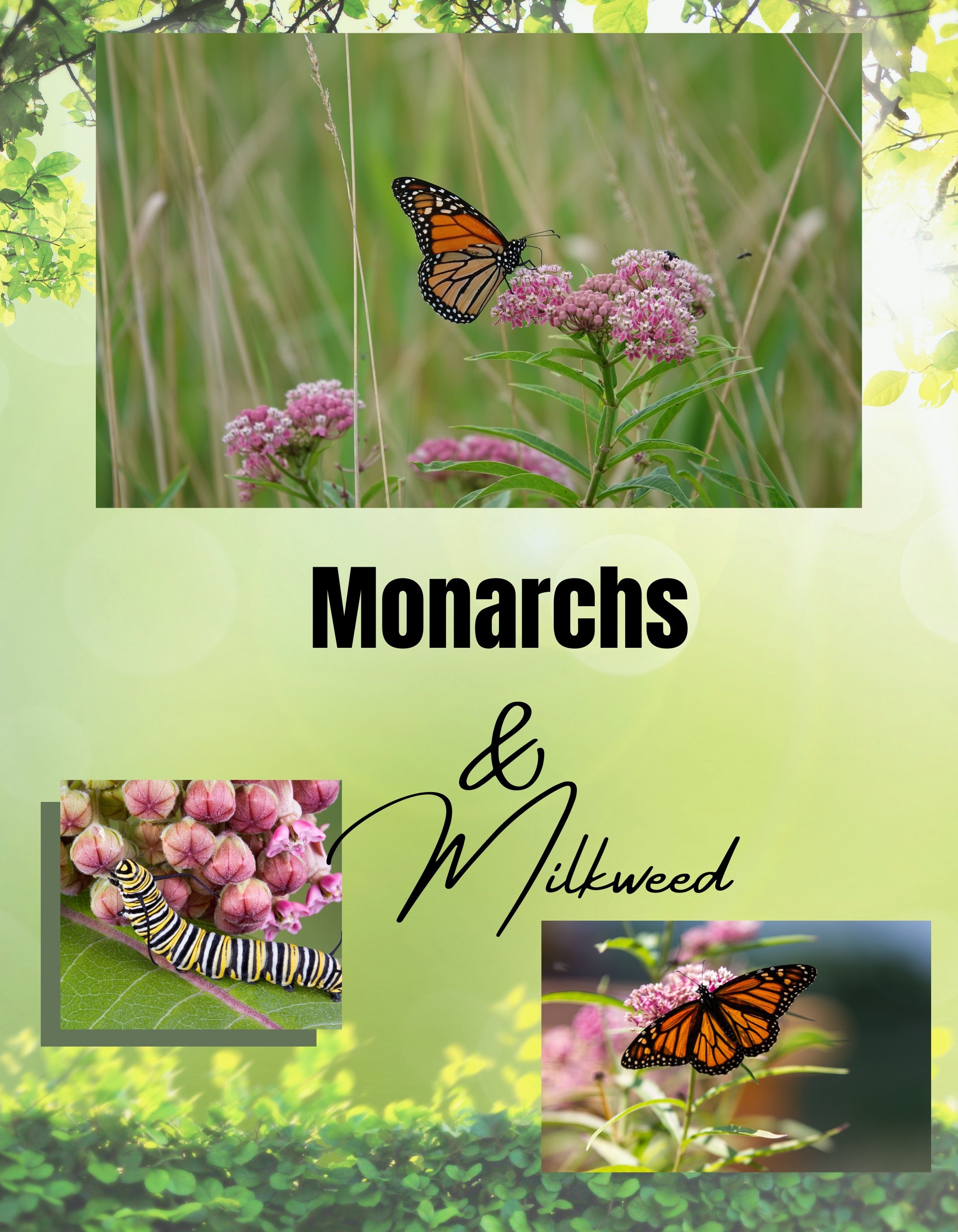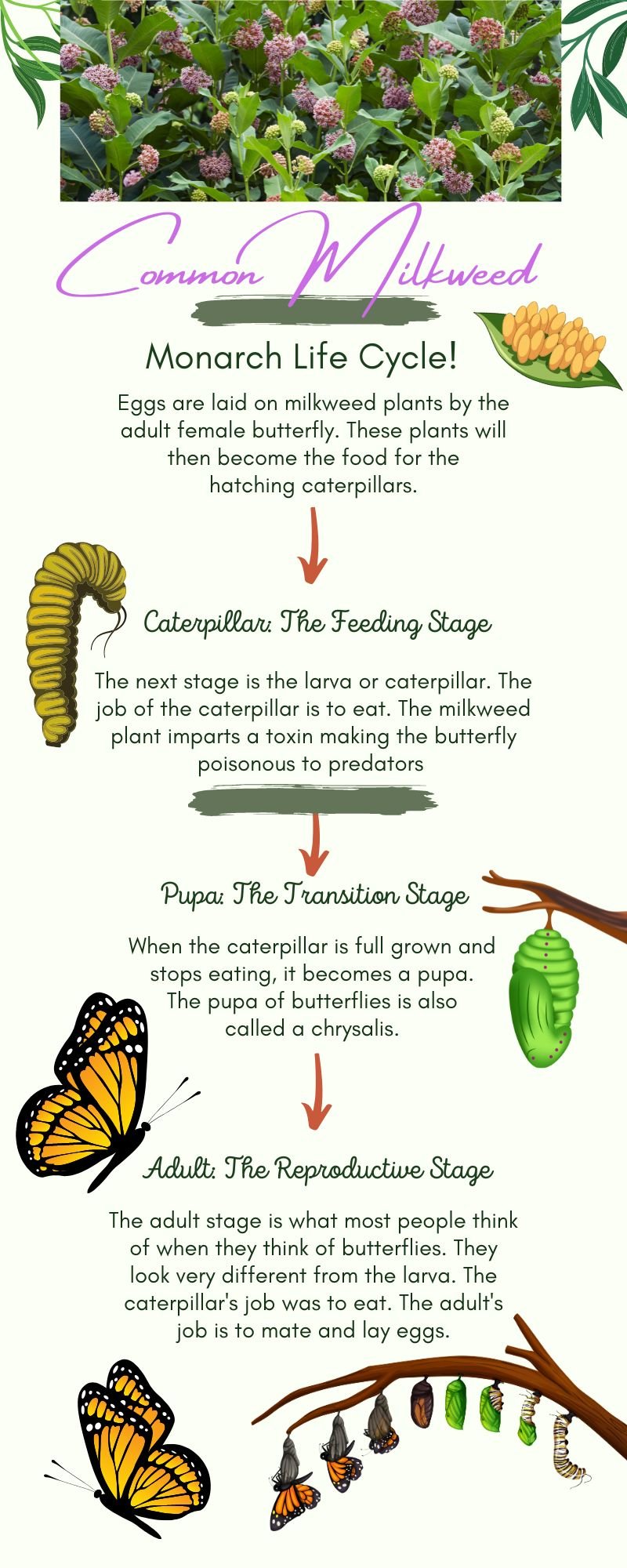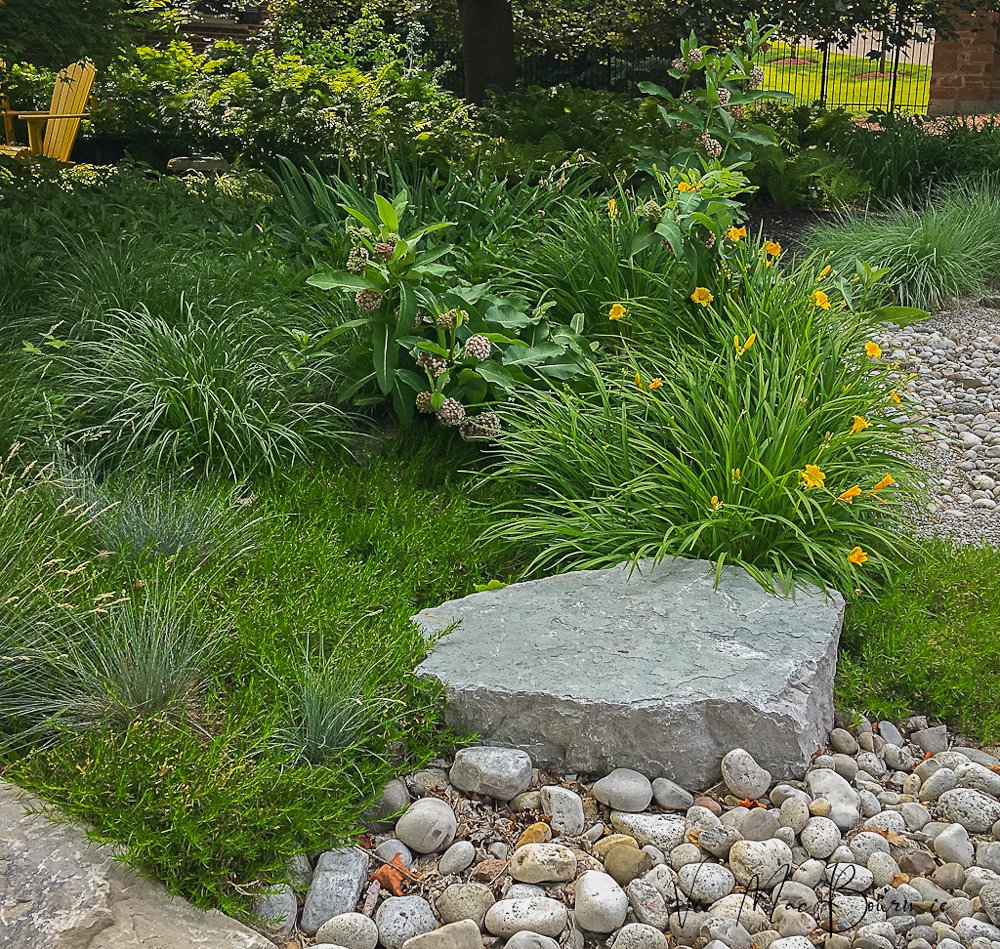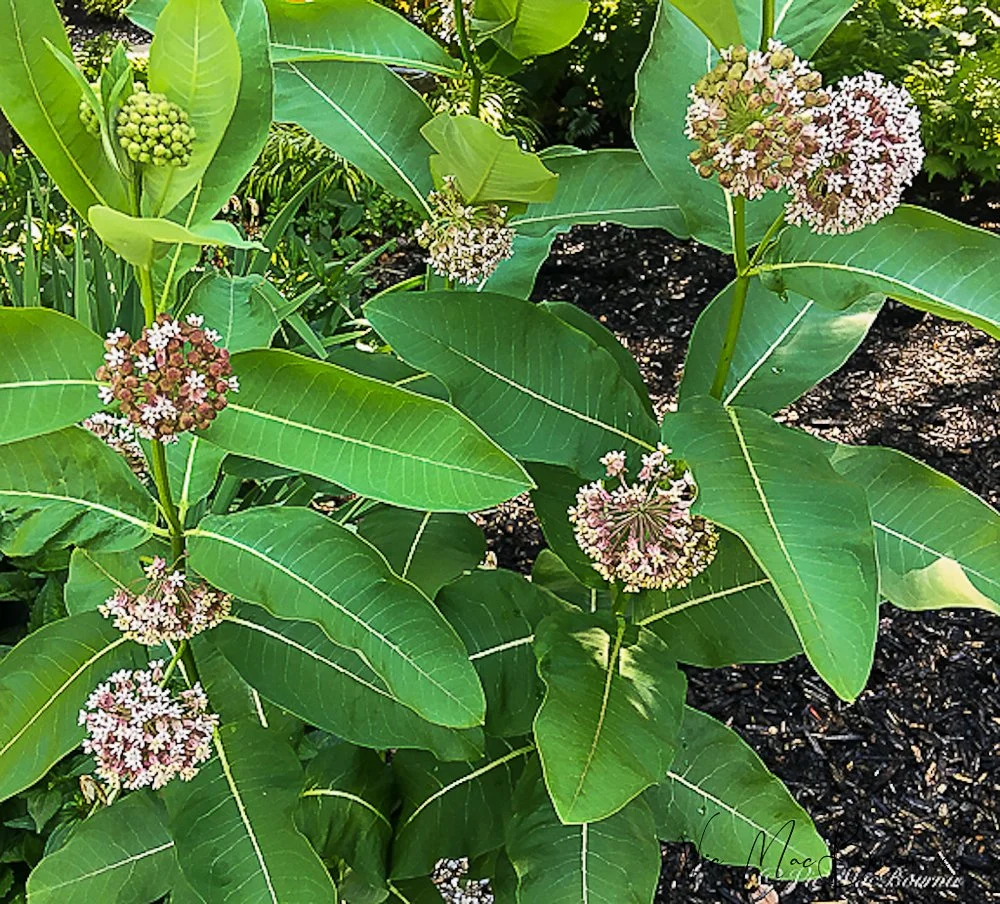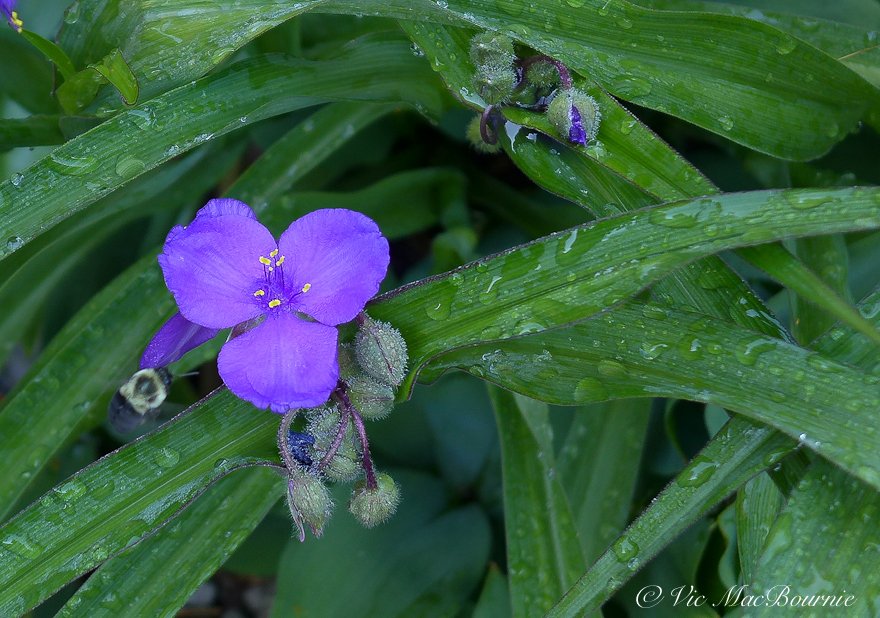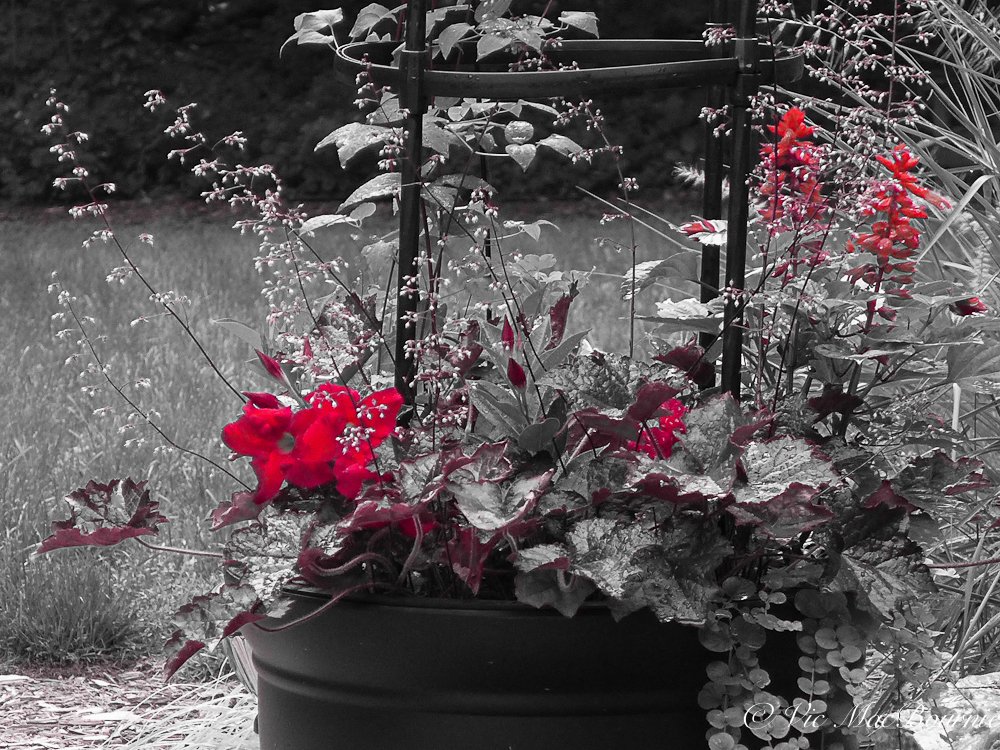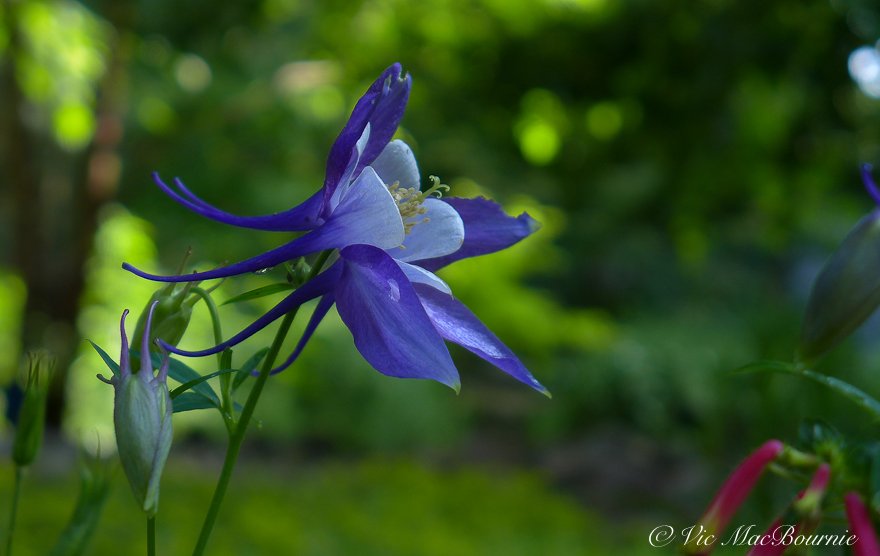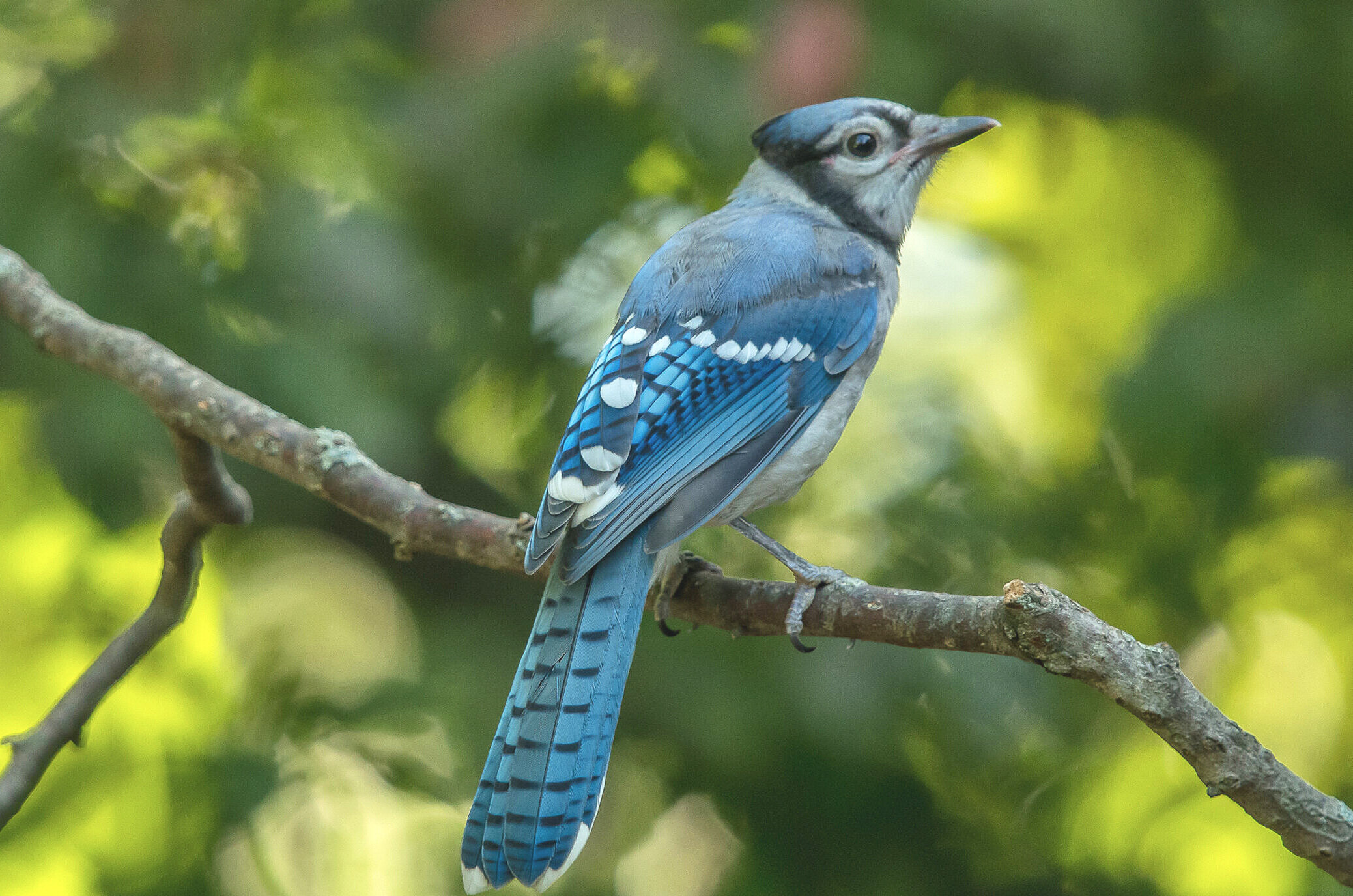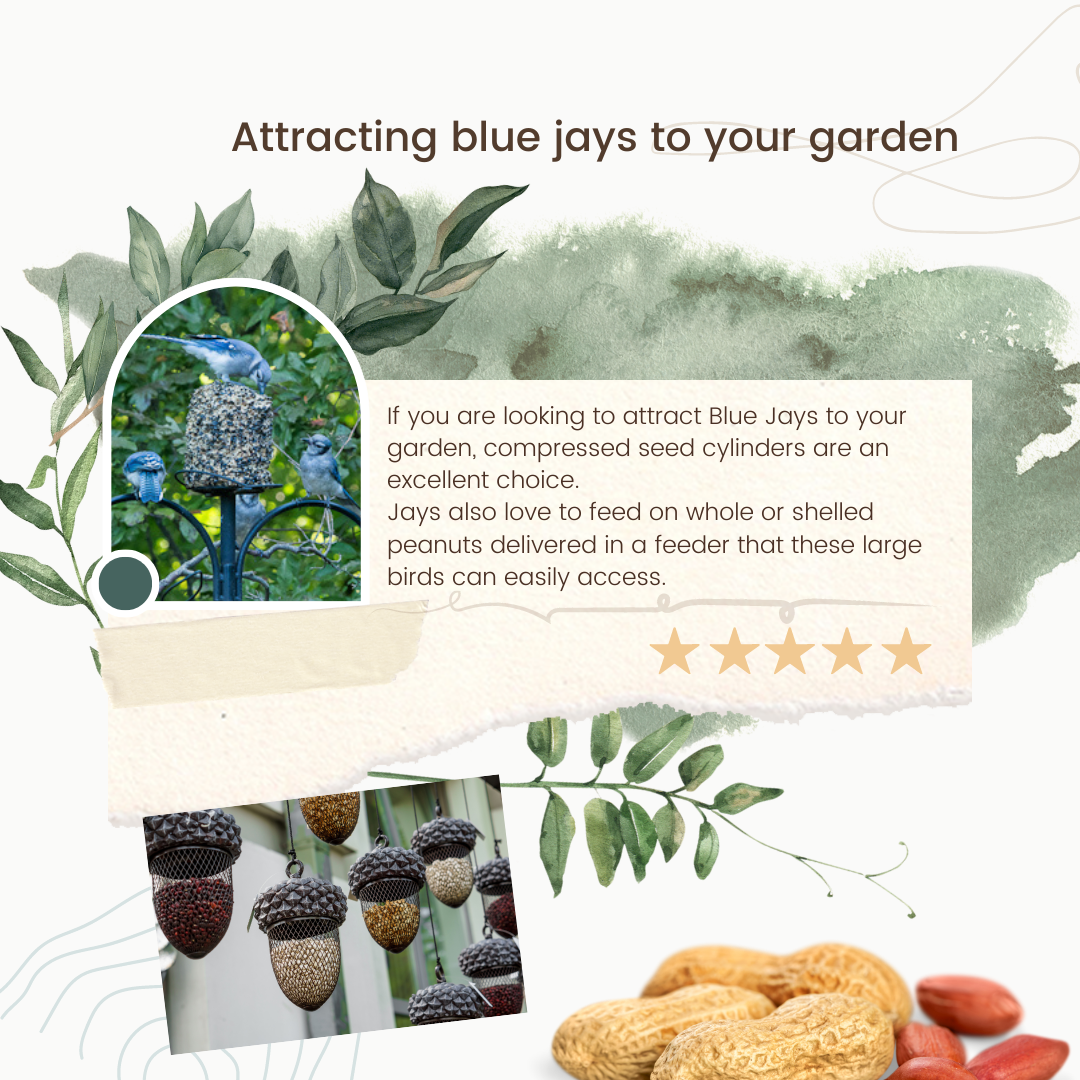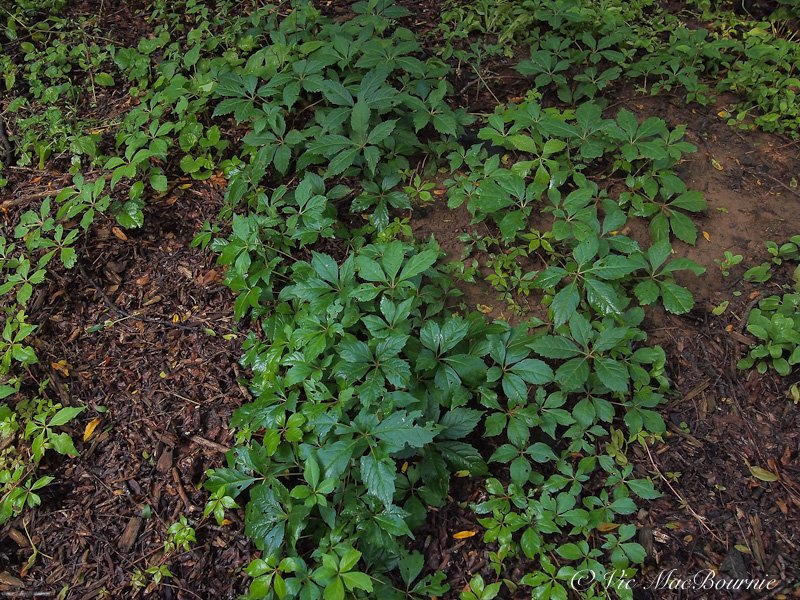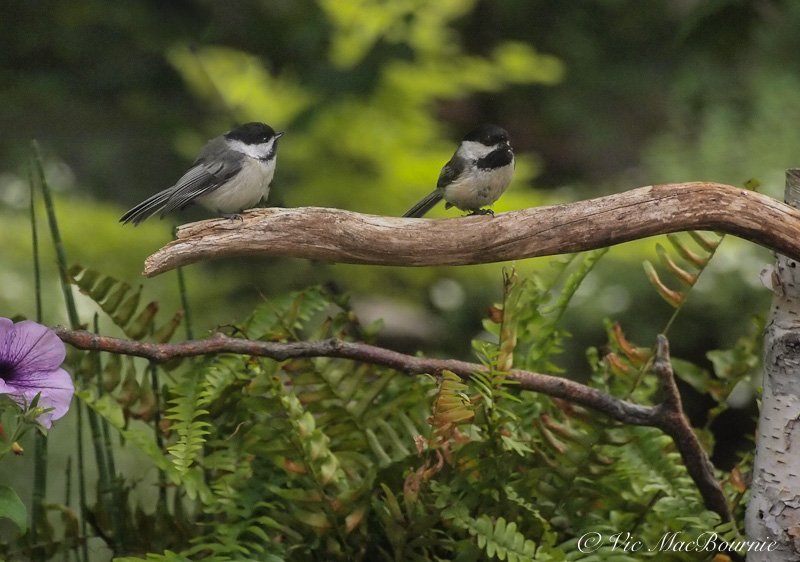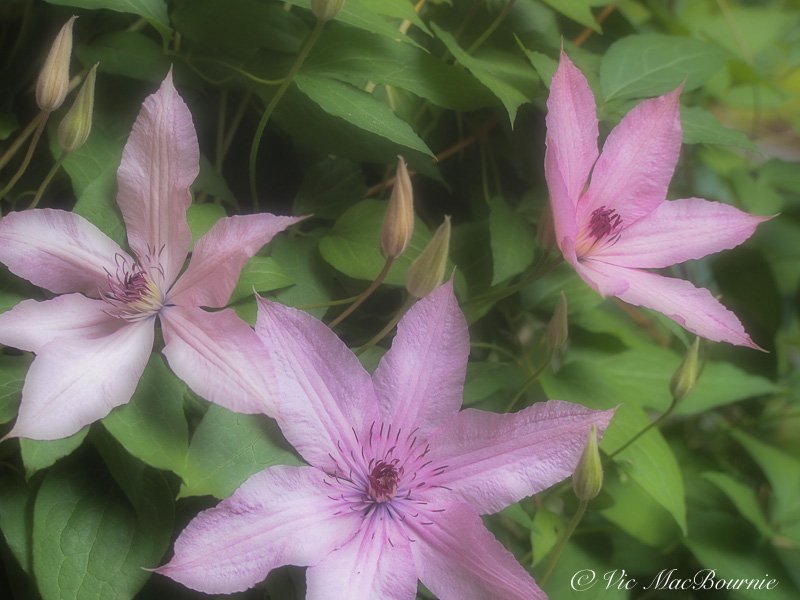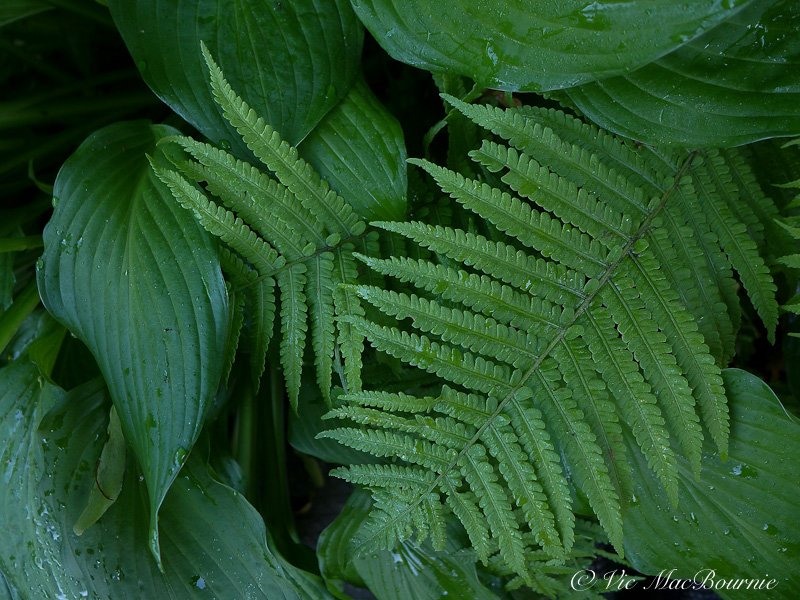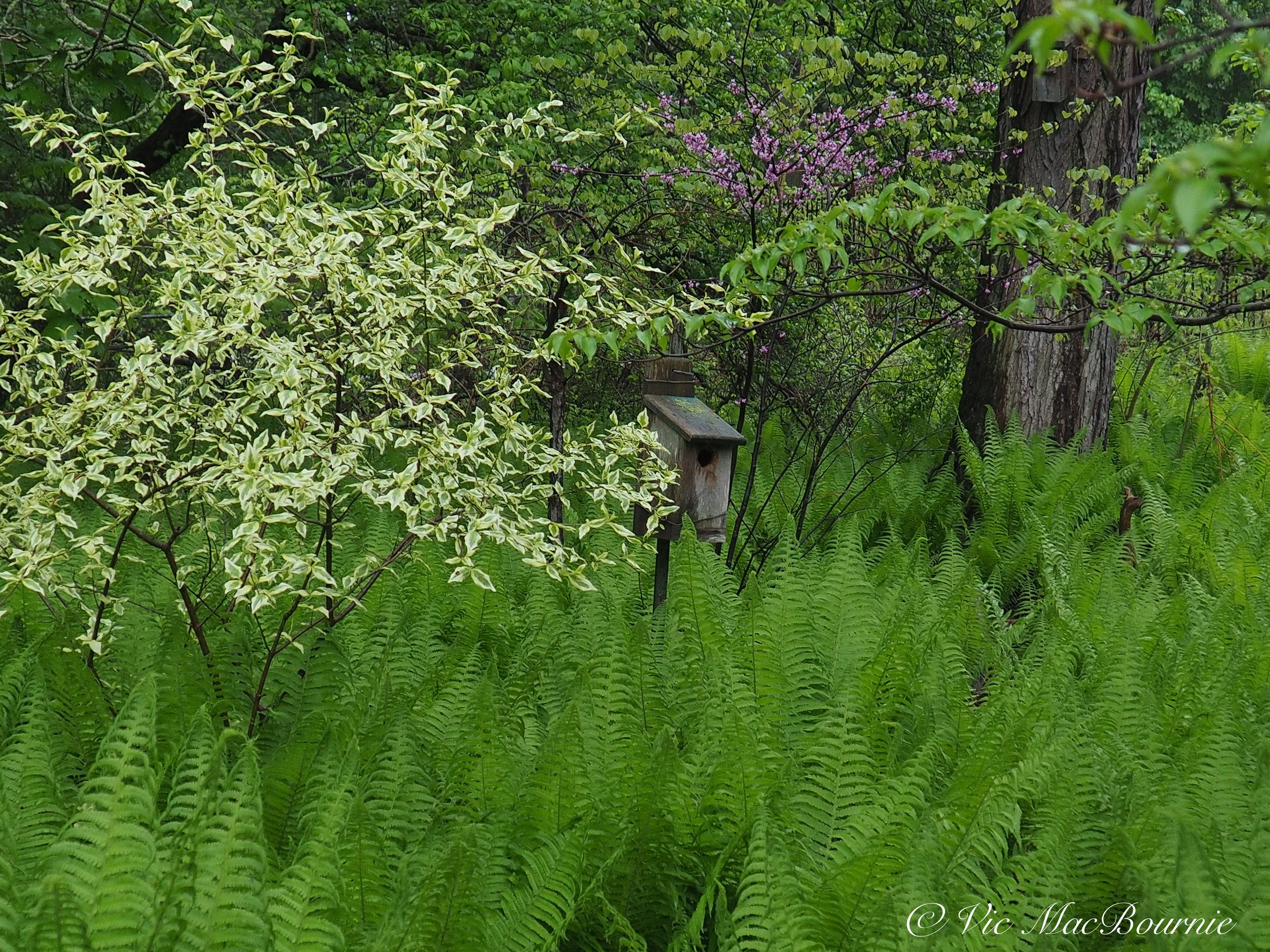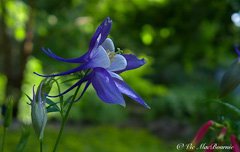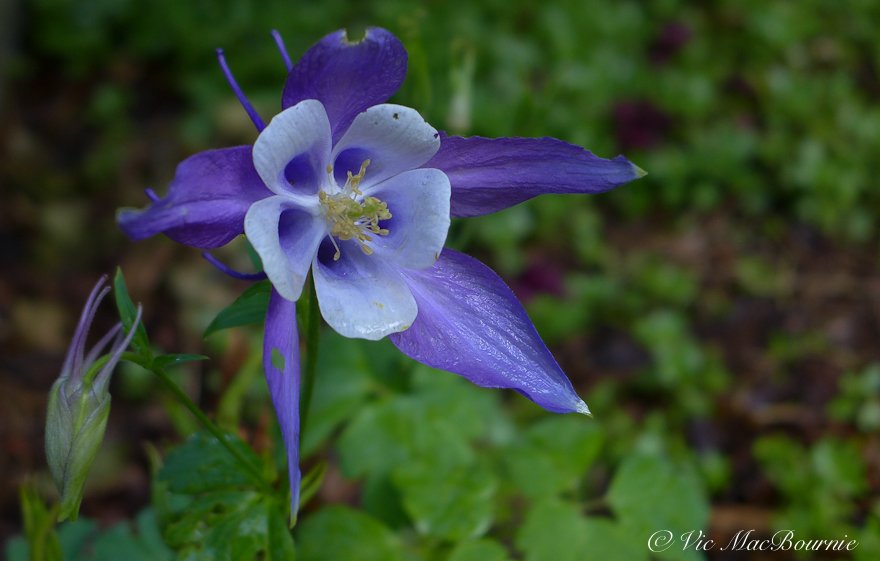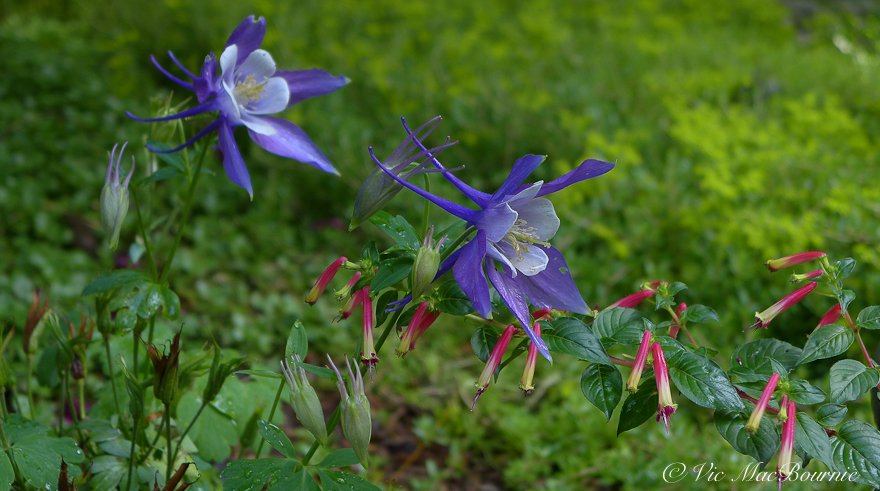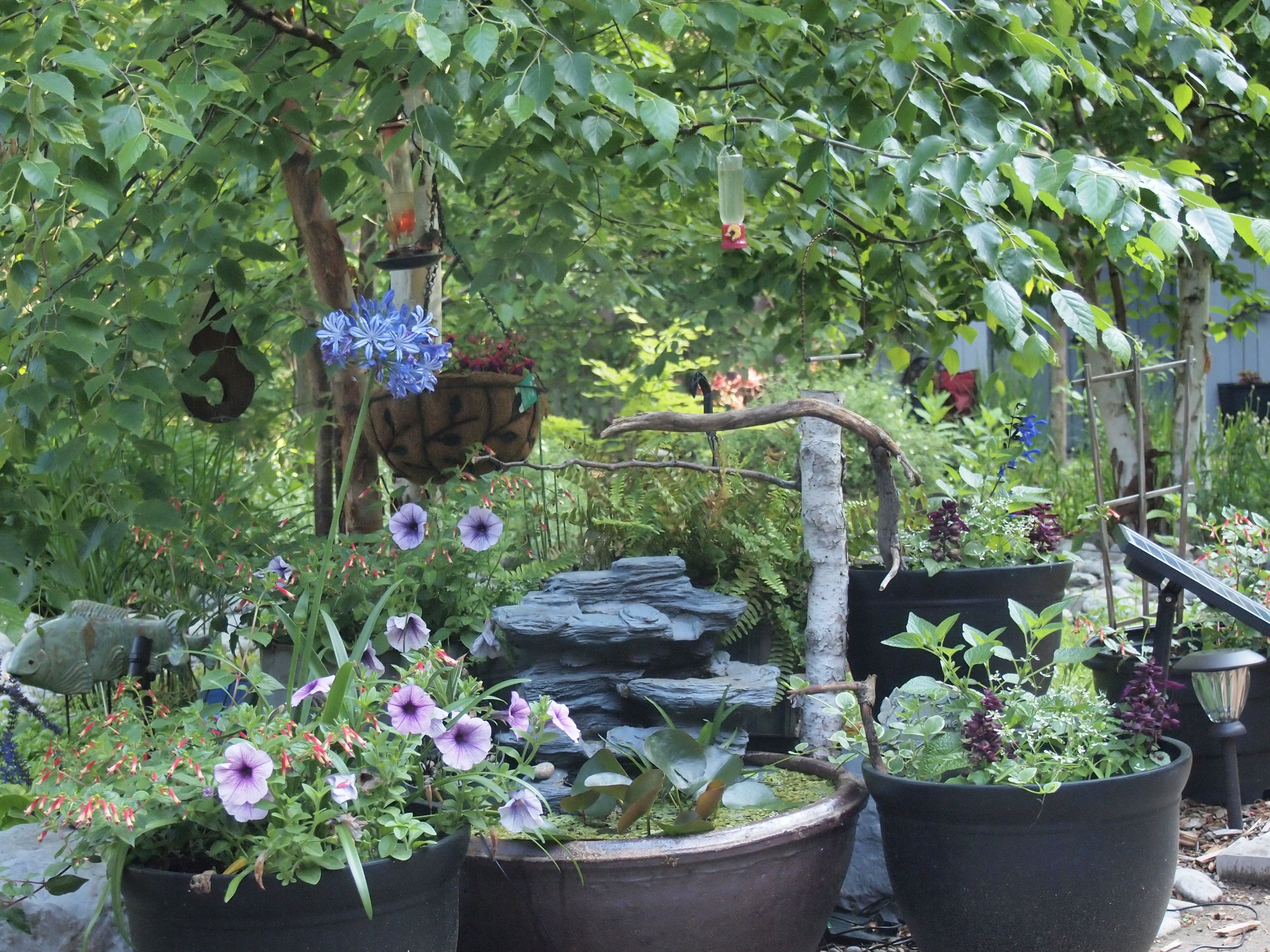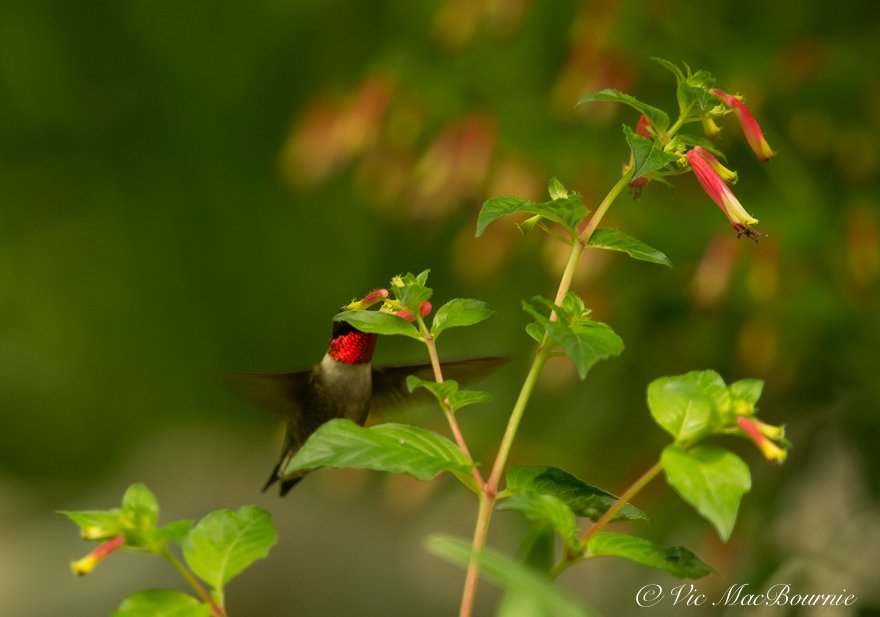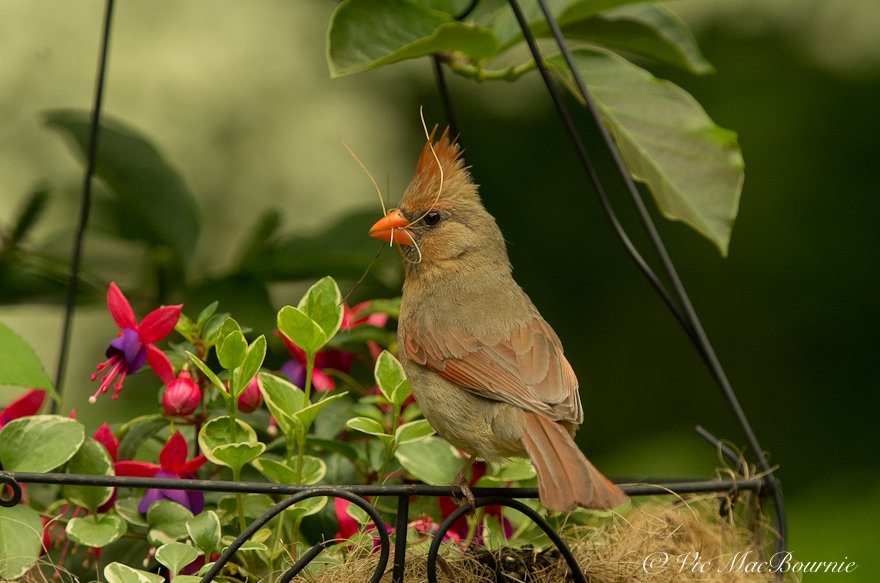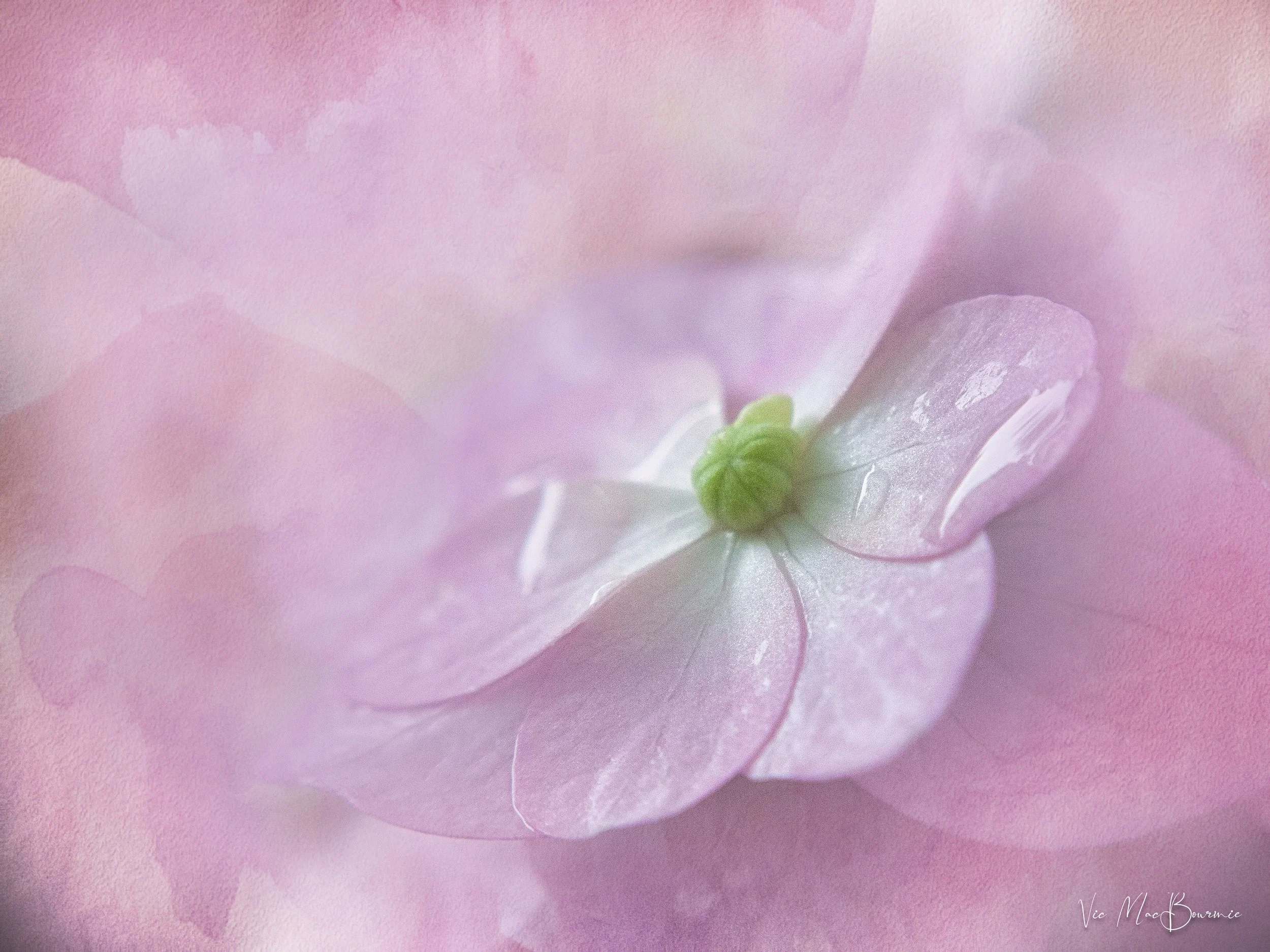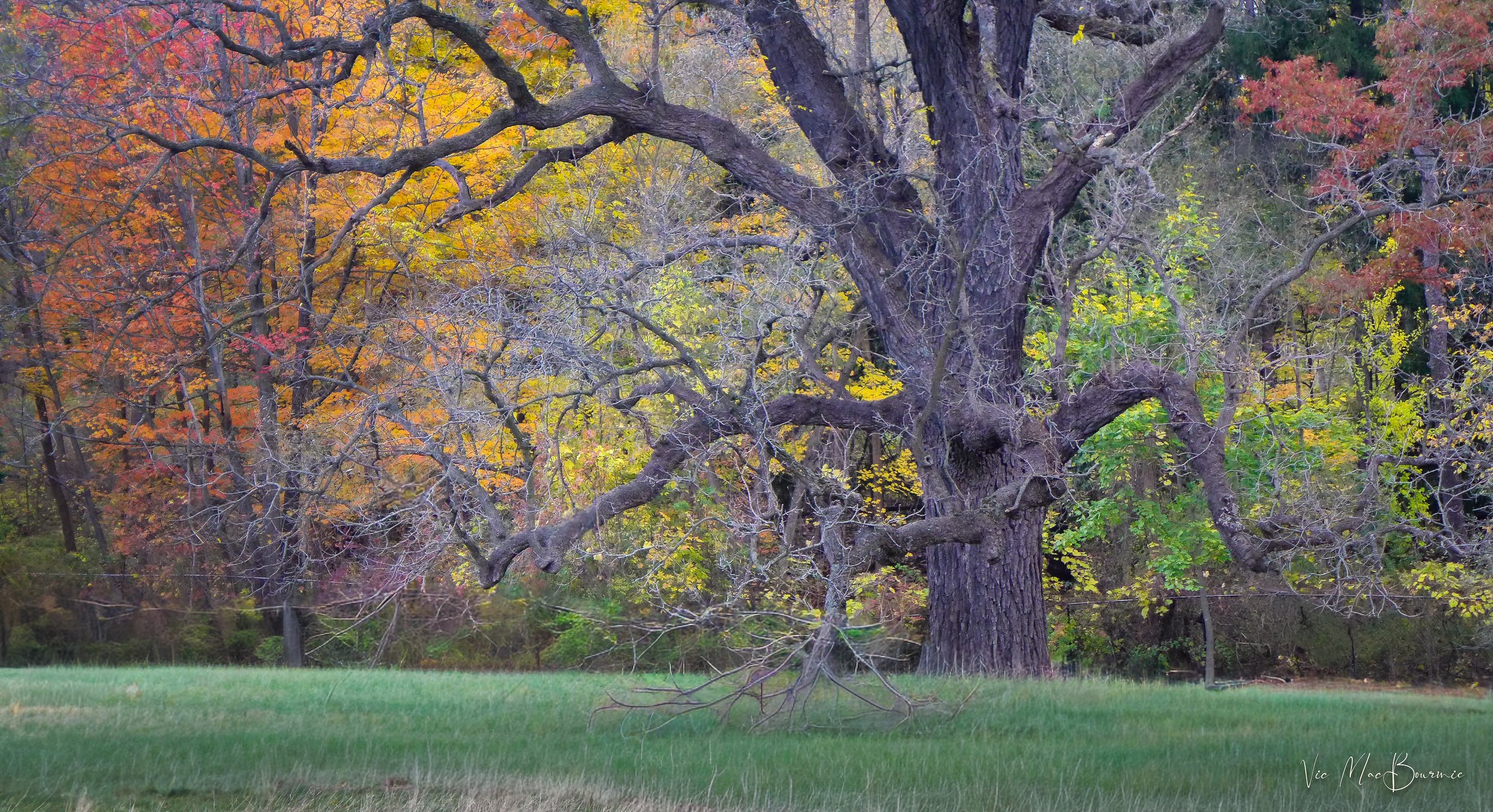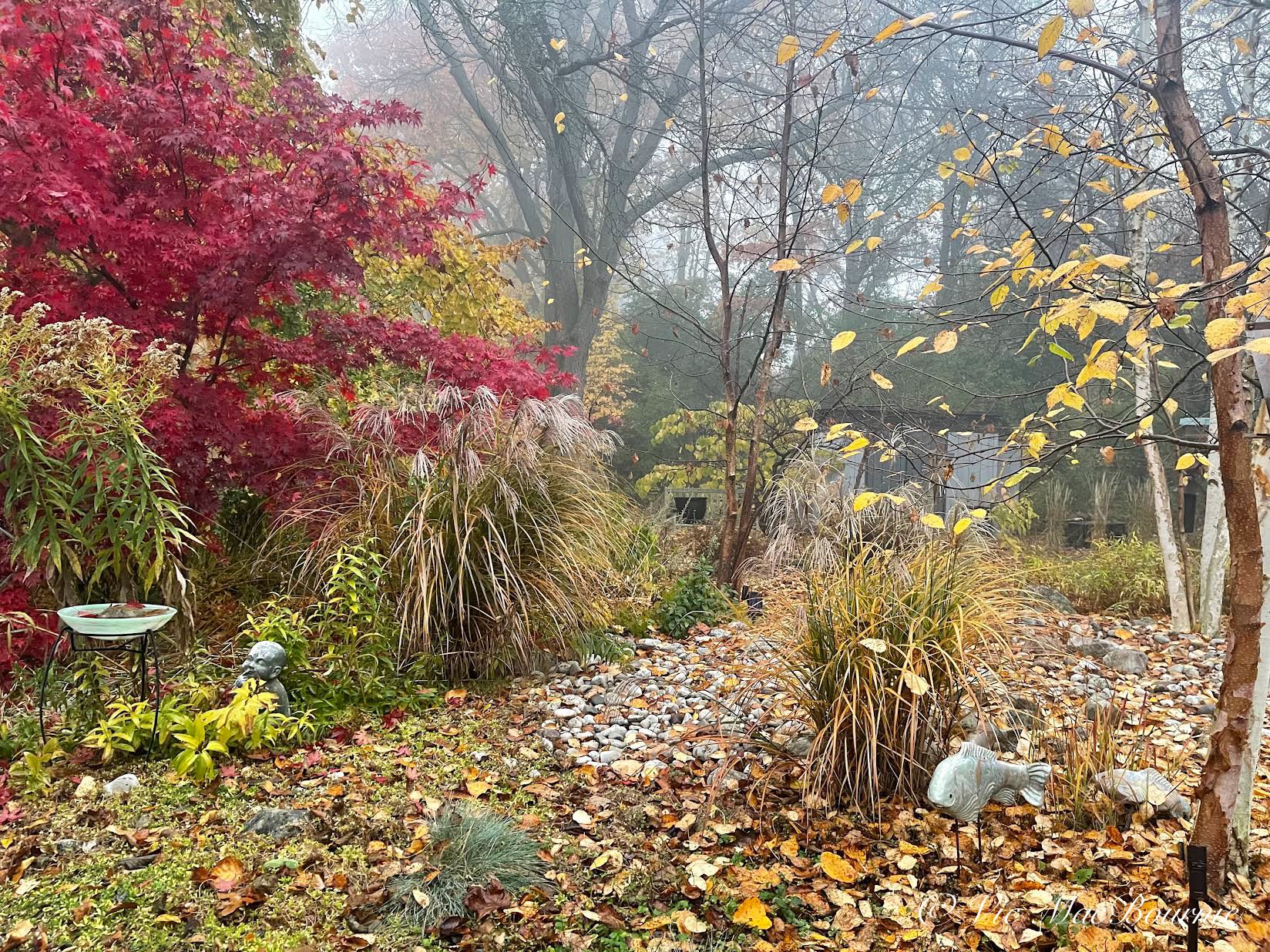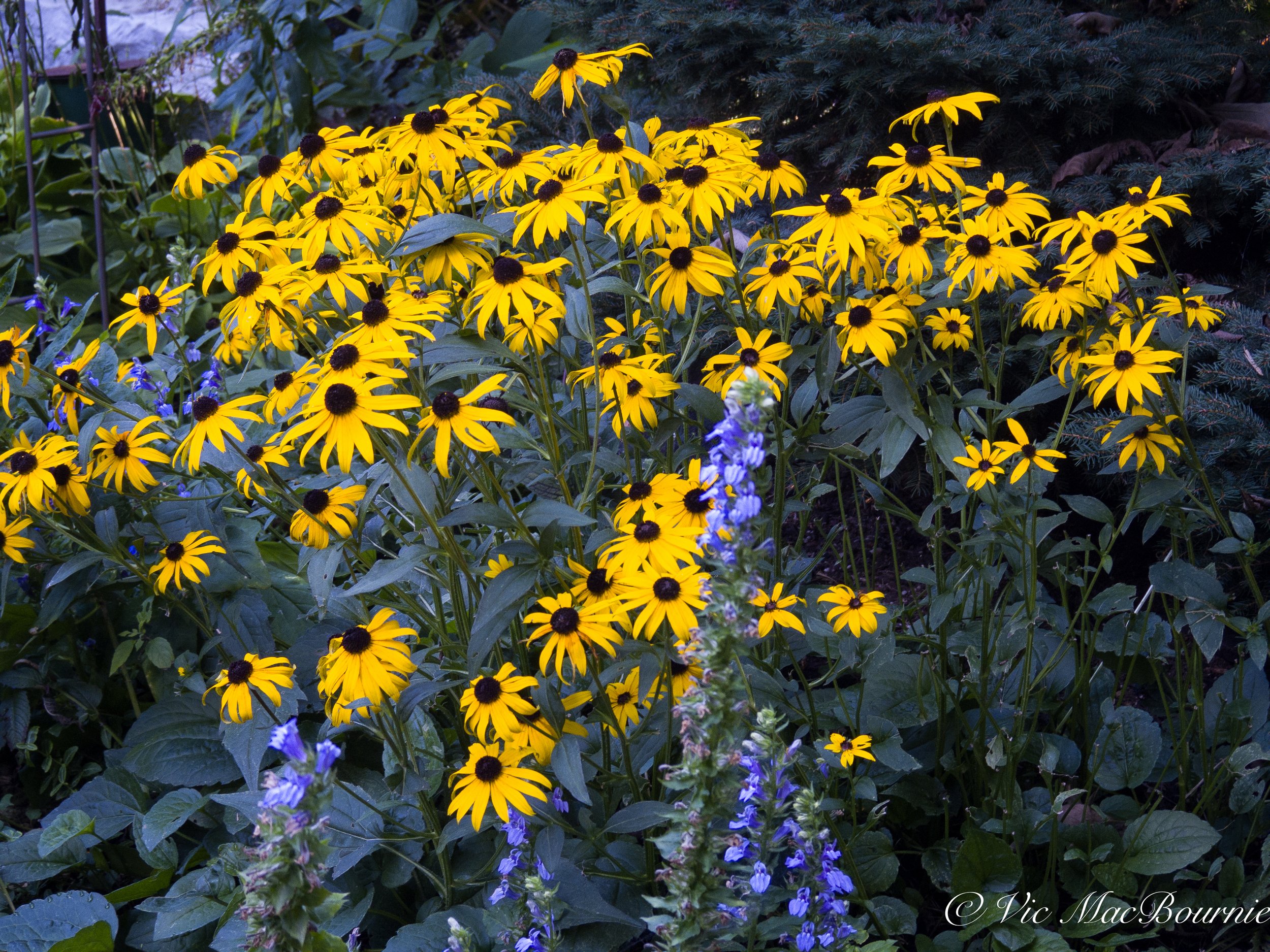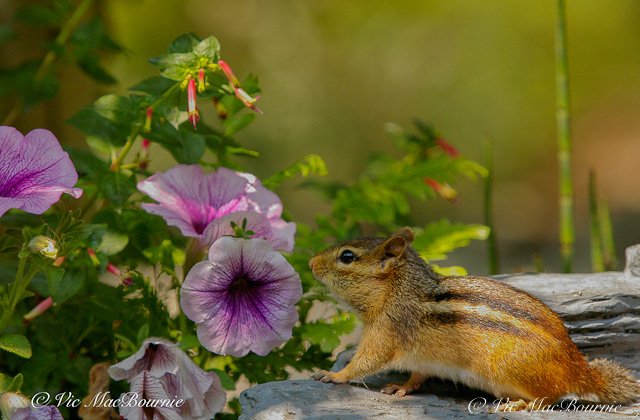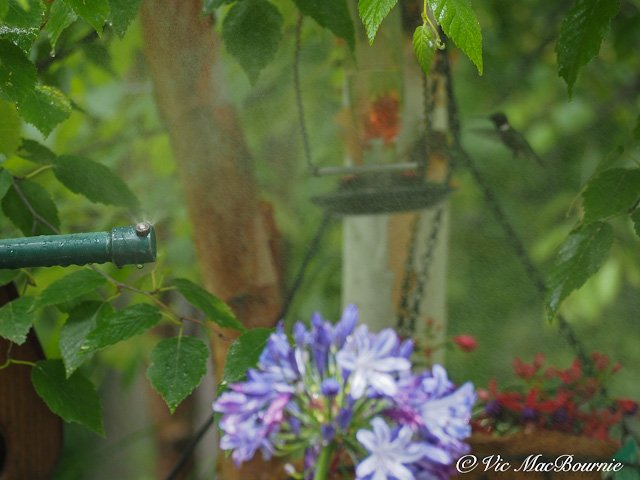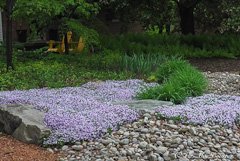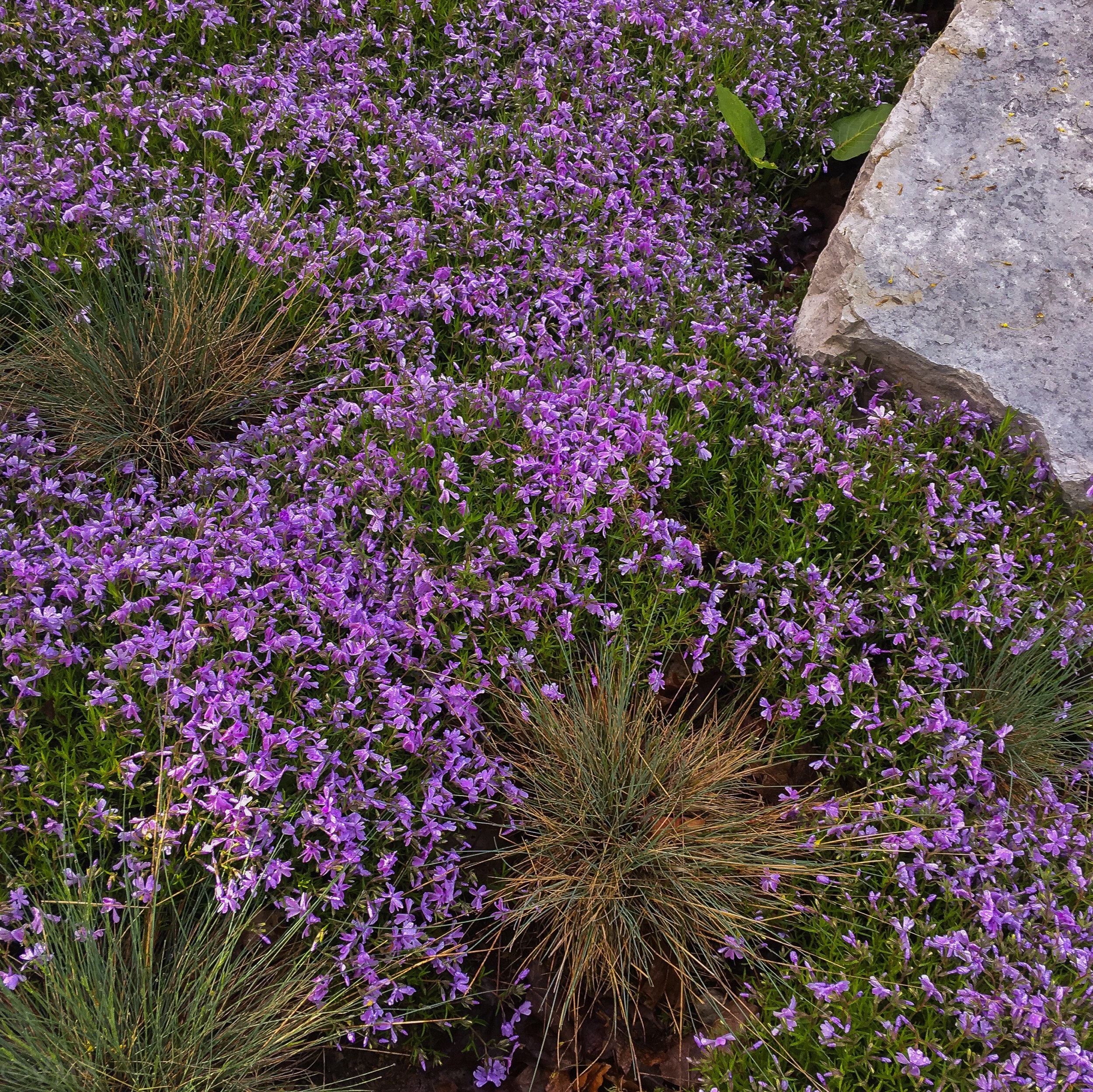Arbour creates vertical planting space, privacy and shade
Arbours can provide vertical garden space in gardens both big and small. You don’t have to grow roses, consider planting native vines or annual vines such as Morning Glories.
Consider planting native vines to provide nesting habitat and food for wildlife
A rose arbour has been at least ten years overdue in our backyard.
I’ve never really been a fan of roses, but after a neighbourhood cat started hanging around a birdhouse in our yard, I decided a rose would help provide a safe place for the birds to raise their young. Eventually, however, the birdhouse fell apart and I removed the cedar pole leaving the rose on its own.
Fast forward to this spring when my wife and I decided it was time to add an arbour to give our old white iceberg rose the support it’s been craving for years.
These arbours are examples of the different ones available with some ideas on how you can use them in your garden decor.
It came in a tidy box. I pulled out the sections of black iron and built it in the comfort of our family room before moving it out into the garden. Four spikes – included in the box – were easily hammered into the ground to provide support and, before I knew it. our black iron arbour was taking up a prominent spot in the woodland garden.
I tied the rose canes to the arbour, being careful to gently bend the rose over the arbour, and voila.
If I knew it was going to be that easy, I would have added an arbour years ago.
I was surprised how the allure and practicality of a rose arbour helped elevate our outdoor space, adding a little romance to our surroundings, as well as provide numerous benefits beyond its aesthetic appeal.
Birds now have a safe place to land, and the thorny rose on the arbour provides an ideal spot for birds to safely build their nests tucked between the canes.
A nearby garden bench provides a quiet spot just to sit, admire the roses and the birds that feel totally safe among the branches and thorns. More on the Garden Bench as art.
Arbour creates focal point and perfect gateway to the garden
A rose arbour also serves as a stunning focal point, adding elegance and charm to any garden or patio.
In our case, it works as a gateway to an area of our garden that was often ignored because it lacked a more formal entrance. In fact, I had even built a small pathway through the area that now leads directly to our rose arbour making it look like it’s been there forever.
Its simple design and graceful arches create a sense of grandeur, instantly transforming an ordinary outdoor area into a more picturesque retreat enticing visitors to stroll along the pathway leading to the arbour.
A quick look on the internet and it’s clear that there are a host of styles to choose from. Of particular note are the arbours that create a small room like the one below.
This Bird Cage arbour from Costway is the perfect way to create a small private retreat. Grow some roses or vines up and over the arches and it becomes the perfect place to relax with your morning coffee or an evening glass of wine with friends.
This birdcage arbour from Costway provides the perfect secluded spot especially if it is covered in vines and/or roses.
Amish-made bird feeder is built to last and perform in your woodland garden
The Amish crafted large gazebo vinyl birdfeeder is the perfect addition to any backyard. Include it as a finishing touch topping feeder for your bird feeding pole, or use it as a stand alone feeder on a separate pole. If you use it as a stand alone feeder, be sure to include a squirrel baffle to keep squirrels and racoons of the feeder. This handmade and handcrafted feeder includes a clear plastic, built-in seed storage container that can hold up to four pounds of bird seed.
This makes it an ideal feeder to fill-and-forget for a week or two while, at the same time, protecting the seed from the elements and providing our feathered friends with a comfortable and sheltered place to feed. The fact that the feeder is made from high quality vinyl, plastic and cedar ensures it is a long-lasting, easy-to-clean and maintain feeder.
An arbour is a perfect addition for a small yard
Whether you have a small yard or a sprawling woodland garden, an arbour can effortlessly elevate the aesthetics of your outdoor space.
There are so many different styles that can be used to fit any garden – from a romantic more formal design, to a rustic arbour design featuring metal branch-like supports that fit in beautifully in any woodland or natural garden.
Now that we’ve explored how a rose arbour can enhance an outdoor space, let’s explore the enchanting world of creating a romantic ambiance with blooming roses. Imagine strolling through your garden, surrounded by vibrant and fragrant roses in full bloom.
The sight and scent of these beautiful flowers can instantly transform any outdoor area into a captivating sanctuary.
Whether you’re planning a romantic dinner under the stars or simply seeking a serene spot to unwind, a rose arbour adorned with blooming roses sets the perfect stage for unforgettable moments with friends and loved ones.
Forget the roses, consider native vines for wildlife
Let’s not limit ourselves to roses, however.
An arbour can simply be a convenient way to add more vertical gardening space to what otherwise might be lacking in many of our garden spaces, especially in a smaller garden or a new one that lacks tall trees.
This Tree of Life Arbour is the perfect addition to a backyard woodland garden with it’s intricate details adding an artistic touch to the backyard landscape decor.
A perfect addition to a woodland or naturalized garden is this “Tree of Life” arbour that is, in itself, a beautiful work of garden art. Add a native vine growing up and over the arbour and you have the ideal entry into a back woodland garden.
Consider growing native vines on the arbour and even up through the rose to provide both a food source as well as more nesting space for birds.
Virginia creeper or wild grape are great choices, but so too are annual vines like Morning Glory to attract hummingbirds. Clematis and honeysuckle are also favourites because they tend to be less aggressive and their flowers can attract pollinators and hummingbirds. The possibilities are endless.
Sweet Autumn Clematis (C. terniflora) is a great fall performer in our area where it can be a little aggressive, but puts out a mass of beautiful tiny white flowers for the bees and other pollinators at a time when many flowering vines and shrubs have finished blooming.
There is a huge variety of garden arbours available to suit everyone’s needs. Here are just a few examples of garden arbours from Amazon to consider.
This twig-style garden arbour is ideal as garden decor in a woodland garden. For more check out this link.
The simplicity of the garden arbour with its metal branch-like look, (above) works perfectly in a woodland-style garden.
Arbour is ideal way to create privacy and shade
Now that we’ve explored how an arbour can enhance your outdoor space and create a certain romanticism in the garden, let’s delve into the practical benefits it offers beyond aesthetics.
One of the key advantages of a rose arbour is the shade it can provide especially in a yard that lacks large trees.
As the sun shines down on your garden, the arbour’s structure casts a cool and refreshing shadow, allowing you to enjoy the outdoors even on hot summer days.
Additionally, the dense foliage on the arbour can be used to create a natural privacy screen, shielding you from prying eyes and creating a secluded area in your own backyard.
Moreover, the sturdy framework of an arbour serves as excellent support for climbing plants, such as vines and ivy, giving them the opportunity to flourish and provide not only a dense shade but plenty of privacy.
So, not only does an arbour add charm and allure to a garden, it also offers practical benefits that make it a valuable addition to any outdoor setting.
Can sedum be used as a ground cover?
Sedum is an ideal ground cover especially in hot sunny areas where other ground covers may struggle.
A young Oriole takes a bath among the sedum stonecrop ground cover in the backyard.
Stonecrop sedums are perfect for hot dry areas of the garden
Did you know that sedum, a remarkable plant known for its versatility, can also be used as a ground cover?
With its ability to thrive in various climates and soil conditions, sedum has become a go-to choice for many gardeners and landscape designers.
Many homeowners are familiar with sedum Autumn Joy combined with Black Eyed Susans and various ornamental grasses in the New American Garden landscape. Most, however, are unaware that sedum also excels as a ground cover.
The low-growing sedums are quick to spread but their shallow root systems mean they are not invasive and easily kept in check in the garden.
The sedum or stonecrop genus, part of the Crassulaceae family, comprises between 400–500 species, some of which are hardy down to zone 3. All sedums are fleshy succulents that store moisture in their leaves making them ideal for dry soils and arid regions.
Let’s explore the power of sedum as a ground cover and discover how it can enhance the beauty and functionality of your outdoor space.
Looking for more information on ground covers? Be sure to check out these posts for more ideas. Three Great Ground covers for the woodland garden, What is the easiest ground cover to grow, best native ground covers for shade
In our garden, two types of sedum stonecrop form dense mats along and into our pea gravel pathways. Both are low-growing sedum that perform well in hot, arid areas where other plants may struggle to survive.
An abundance of small yellow and pink flowers in late spring or early summer provides pollinators with an early food source, while creating a lovely changing tapestry of colour from spring into summer.
There are several different Sedum stonecrop that will work as a groundcover They include:
• Angelina stonecrop – (Sedum rupestre ‘Angelina’) a lovely gold-leaved sedum with tiny yellow flowers throughout the summer that grows to between 4-6 inches and is hardy from zones 3-9.
• Russian stonecrop – (Sedum kamtschaticum) unlike Angelina, this sedum has dark green leaves and golden yellow flowers that bloom later in the summer. It grows 3-6 inches in zones 3-8 with foliage that turns bronze in fall.
• White Sedum – (Sedum album) a standout ground cover that turns reddish in fall and is at home in rocky or poor soils. It grows to between 3-5 inches in zones 3-9 and sports white flowers.
• Murale – (Sedum album ‘Murale’) has pink flowers in spring that are particularly attractive to bees and butterflies. The bronze foliage of this low growing ground cover stays to a tidy 2-3 inches high and is hardy in zones 3-9.
• Purple Emperor – (Hylotelephium telephium) stands out because of its plum foliage and pink flowers that is ideal for rock gardens and sunny borders. It is a more upright growing sedum with a mature size of between 12 and 15 inches and is hardy through zones 4-9.
Other sedums to consider include Blue Spruce sedum (sedum reflexum ‘Blue Spruce’) hardy in zones 4-9 with needle-like foliage and yellow flowers in mid to late summer. Japanese stonecrop (Hylotelephium sieboldii) is hardy from zones 3-9 with its bright pink flowers and a mature height of between 3-4 inches.
Using sedum as a ground cover offers numerous benefits that can enhance the beauty and functionality of your outdoor space. One of the key advantages is its ability to suppress weed growth, saving you time and effort in maintaining your landscape.
Sedum also acts as a natural mulch, helping to retain moisture in the soil and reduce water evaporation. This makes it an excellent choice for areas with limited rainfall or where water conservation is important.
Additionally, sedum ground covers provide insulation, keeping the soil cooler in hot weather and warmer in cold weather. They also help prevent erosion by stabilizing the soil and reducing runoff.
With their low-growing and spreading nature, sedum ground covers create a lush carpet-like effect, adding texture and visual interest to your landscape.
And let’s not forget about the pollinators, Sedum flowers attract bees, butterflies, and other beneficial insects, making your garden a haven for biodiversity.
So, whether you want to create a low-maintenance garden, conserve water, prevent erosion, or simply add beauty to your landscape, using sedum as a ground cover is a smart choice.
How to grow sedum in your garden
Now that you know the benefits of using sedum as a ground cover, let's explore how to successfully incorporate it into your landscape.
First and foremost, it’s important to choose the right sedum variety for your specific needs. There are many different types of sedum, each with its own growth habit, color, and texture. (see above for descriptions of sedum varieties.)
Some varieties are more suitable for sunny areas, while others thrive in shade or partial shade.
Sedum are extremely easy to grow from cuttings.
Once you have chosen the right sedum, prepare the soil and plant the sedum plugs or cuttings at the recommended spacing, usually around 6 to 12 inches apart. Water the newly planted sedum thoroughly and keep the soil moist until the plants are established. After that, sedum is relatively low-maintenance and requires little watering.
However, it's important to monitor the soil moisture levels during dry periods and provide supplemental water if needed. To maintain the appearance and health of your sedum ground cover, trim back any overgrown or damaged foliage in early spring.
Whether you're using it to fill in gaps between pavers, cover slopes, or create a vibrant border, sedum will transform your landscape with its versatility and charm.
How to use sedum in your landscape
Let’s take a look at some inspiring examples of how it can transform your landscape.
One popular way to use sedum is as a vibrant border along pathways or garden beds.
The low-growing, colourful foliage creates a beautiful contrast and adds visual interest to any outdoor space.
Another creative use of sedum is to cover slopes or hillsides. The dense growth habit of certain sedum varieties helps prevent erosion and adds stability to the soil. Plus, the cascading effect of sedum spilling over the edges creates a stunning natural look.
Sedum also works wonders in rock gardens. Its ability to thrive in dry, rocky conditions makes it a perfect choice for adding texture and colour to these unique landscapes.
I like to mix different sedum varieties to create a tapestry of hues and shapes in the landscape.
Lastly, sedum can be used to fill in gaps between pavers or stepping stones. This not only adds a touch of greenery but also helps prevent weed growth and keeps the area looking neat and tidy.
Whether you’re looking to enhance your pathways, cover slopes, create a rock garden, or fill in gaps, sedum offers endless possibilities.
Focus on vintage Pentax 110 lenses on the Pentax Q
The Pentax Auto 110 lenses are capable of some impressive results, especially if you use one of the hacks that help sharpen the lenses and create a greater depth of field.
The 110 lenses also fit micro four thirds and fujifilm cameras
No one could blame you if you thought the vintage Pentax Auto 110 lenses were made for the more modern Pentax Q line of cameras.
It’s just that 46 years ago, no-one would have dreamed that a miniature digital camera would even exist let alone continue to be so popular today.
These exquisite, tiny, almost miniature 110 lenses could not be more perfect for the Pentax Q line of cameras unless, of course, they offered full auto focus capabilities. However, even the Pentax “Toy” lenses, – the wide angle, telephoto and fisheye lenses – made especially for the Q series – do not offer auto focus capabilities.
For more on using the Auto 110 lenses on both the original film camera and the Pentax Q series of cameras, be sure to check out my post on shooting B&W film and digital using the Original Auto 110 and the Pentax Q.
So, the 18mm, 24mm, 50mm and the outstanding 70mm Pentax 110 lenses are almost too good to be true for Pentax Q users. All that is needed is a simple, inexpensive adapter to convert the lens. These adapters to convert the 110 lenses are also available for Fuji FX X-Mount camera X-PRO2 X-E1 X-E2 X-A2 X-M1 X-T3 X-S10 etc.
The build quality of these vintage lenses is also outstanding. Although the first three are made of plastic, it’s not your everyday plastic found in many of today’s inexpensive lenses.
These are extremely solid lenses that feature weighted almost perfectly silky focus.
• Be sure to check out my full post on using the 07 Pentax Mount Shield Lens on the Pentax Q.
Can Pentax 110 lenses be used on other camera systems?
Just by adding another simple and inexpensive adapter, these vintage lenses can even be used with Micro 4/3rd cameras like those available from Olympus and Panasonic brands.
In fact, the sensors in the Micro 4\3rd cameras fit the rear element of these lenses almost perfectly, meaning there is no lens vignetting.
When used with these camera systems, the crop factor is only 2X meaning the 18mm becomes the equivalent of a 36mm f2.8 lens, the 24mm becomes a 48mm, the 50mm becomes a 100mm and the 70mm becomes a 140mm.
What are the crop factors of 110 lenses on the Pentax Q cameras?
If you are wondering how these lenses translate in the world of traditional 35mm on the Pentax Q series, consider the 5.35 times crop factor of the original Pentax Q and you are left with the following: 18mm = 96mm, 24mm = 128mm, 50mm = 267mm and finally the 70mm = 374mm. The same lenses on the Q7 or Q-S1 – with a larger sensor and a crop factor of 4.65 – results in the following: 18mm = 83mm, 24mm = 111mm, 50mm = 232mm, and finally 70mm = 325mm. These numbers are rounded off, but you get the idea.
All of these lenses are manual focus, fixed f2.8 lenses that do not transmit any information to or from the camera. Just set your Pentax Q on Program, Aperture or shutter priority and let it choose the proper exposure. The over and under compensation button will correct for any unusual lighting conditions.
In addition, with the proper firmware, the camera’s in-body stabilization will work on these lenses after you program the lens’s focal length into camera.
Pentax 110 70mm is a real gem
The one lens in the group that really stands out to me is the 70mm.
I am drawn to telephoto lenses anyway, so the all-metal 70mm F2.8 Pentax 110 lens that is a made-in-Japan masterpiece is by far my favourite if I need the reach. The 70mm actually translates into almost a 400mm lens (374 mm in 35mm equivalent) on the original Pentax Q.
Pentax’s exquisite, all-metal 70mm f2.8 lens from the former 110 Auto system mounted on the original Pentax Q.
The slightly swirly bokeh on the lens can be beautiful and the silky smooth focus reminds me of the old Takumars.
All this in a package that could easily slip into your coat pocket and weighs in at a mere 240 grams (Pentax Q is 80 grams, plus the 70mm 160 grams = 240 grams). This lens has 6 elements in 5 groups and even uses the traditional Pentax 49 mm filters – perfect for standard circular polarizers and even high-quality close-up lenses.
Speaking of filters. I was lucky enough to get filters mounted on the entire set I purchased on-line, but if you are looking for your own, here is a list of the filters you will require for these lenses: 18mm takes a 30.5mm filter, 24mm takes a 25.5mm filter, 50mm takes a 37.5mm and the 70mm takes a 49mm filter. Of course with step up rings you can use larger filters such as standard polarizers.
How about image quality?
The build quality, aesthetics and fun factor means little if the image quality falls short.
Some users would argue that the image quality of these lenses does fall far too short to take them serious, but others would say that, with a brilliant little hack, the image quality on these lenses can be very good to excellent.
This image of Joe Pye Weed in a natural woodland was photographed with the 24mm with the rubber washer used to create the effect of an approximately F8 lens.
Simple hack helps sharpen focus
What’s the hack that turns these soft, fixed f2.8 lenses into sharp, high-quality glass?
It involves a $1.00 rubber washer and about one minute of your time. That’s it.
If that’s too much trouble, you can always pick up a box of ring binder reinforcements, use a black sharpie to darken them, and simply stick them on the back of the lens’s plastic surround. That will turn the lenses into about an F8 lens with the accompanying greater depth of field and a significant increase in sharpness.
These images show the rubber washer inside the Q’s adapter: first image is from the back of the adapter closest to the sensor. Second image shows the rubber washer just behind where the lens connects to the adapter.
Although the ring binder reinforcements get a lot of praise on-line, the rubber washer works very well and you could create two or three with different hole sizes to give you more access to different f-stops.
Ring binder reinforcement on the back of one of the 110 lenses.
The rubber washer is simply pushed inside the adapter and sits in a concave position from the camera mount and sensor. From the back of the lens, the rubber washer sits comfortably in a convex position. (see images above).
If you want to shoot the lenses wide open, the rubber washer is extremely easy to remove from the adapter and then replaced in just a few seconds.
Anyone who thinks these lenses are not capable of achieving sharp focus might be surprised with this shot from the 18mm Auto 110 lens that clearly shows the pollen on and around the Bumble bee.
Using these lenses successfully requires the photographer to slow down.
On the above image and the one below of the bees, I hand held the camera and shot several images to get a sharp one.
However, if you are shooting landscapes, woodlands or your garden flowers, put the camera on a tripod, turn off the anti shake option, use the 2 or 4 times built-in magnifier and focus peaking on the Q to focus precisely on the LCD and use the 2 second delay timer to get the most sharpness out of these lenses.
You will be rewarded for your efforts.
Bumble bee on Blue Lobelia hand held and taken with 18mm lens with rubber washer hack.
Is lens sharpness over rated?
When it comes to lenses, there are those who consider only pin-sharp lenses as acceptable. Others, however, look for qualities in the lenses that give them a look and feel that works with their style of photography whether the lenses are tack sharp or not.
Let’s face it, most images are only ever seen these days on social media where sharpness is already compromised through the social media platform.
I consider these 110 lenses as somewhere in the middle. They are capable of creating very sharp images but the combination of having to manually focus them on the back of the LCD panel and being more than 40 years of age, makes getting tack sharp images difficult sometimes. This difficulty is only increased if you are shooting the lenses wide open at f2.8.
Even with a tripod, sharp images are not the easiest to obtain, especially since so many of us have been spoiled with autofocus lenses.
But, if you use the rubber washer or ring binder reinforcements these lenses really can shine.
The 110 lenses are fun, they fit the Q cameras aesthetic and are usually inexpensive if you can purchase them as a package.
With a little work you can create more than acceptable results, and with a little creativity, you can create masterpieces.
Joe Pye Weed: Pollinator magnet that’s perfect for wet areas
Sweet Joe Pye Weed is an impressive native wildflower that attracts a range of pollinators from bees to butterflies.
How to grow and care for Sweet Joe Pye Weed
Sweet Joe Pye Weed (Eutrochium Purpureum) is a stunning perennial plant that not only adds beauty to your garden but also draws in a host of pollinators and butterflies including swallowtails and monarchs.
In our backyard, I have it growing toward the back of the property at the foot of a small hill and mini meadow where its impressive size and pink blooms combine nicely with the other late-blooming native plants like asters, goldenrod and wild sunflowers. It is native to eastern United States and Canada and is hardy in zones 4-8.
Joe Pye Weed (Eutrochium Purpureum) is shown here growing in a drift in a natural woodland area.
Joe Pye Weed is both deer and rabbit resistant. The plants also tolerates both clay soil and road salt spray, making them ideal plants to use as a screen if you need privacy near a roadway.
Consider growing Joe Pye Weed as a native alternative to the non-native and invasive butterfly bush. Joe Pye Weed is host to a number of butterflies and moths including the Ruby Tiger moth.
Can I grow different Joe Pye Weed plants?
There are actually several different Joe Pye Weeds you could grow in your garden including the tallest plant Hollow Joe Pye Weed (Eutrochium Fistulosum) known for growing large flower heads on 5-7 foot tall plants. Under optimum conditions, it is said that this plant can grow up to 12 feet in height with blooms from July through September. It does best in full sun and spreads by rhizomes. The stem, which is hollow as its name suggests, has a whitish surface.
•Spotted Joe Pye Weed (Eutrochium maculatum) blooms a little later than other Joe Pye Weeds lasting from August through October. It grows best in damp soil and spreads by underground rhizomes.
A large bumble bee works the nectar of our Joe Pye Weed in the woodland garden.
• Coastal Joe Pye Weed (Eutrochium dubium) is the smallest of the Joe Pye Weeds and is known for producing its beautiful display of purple to pink flowers on three- to five-foot stems. The bloom period lasts from July through to October and grows best in wet sandy soils. It is found growing along the atlantic coastal states. The leaves are rough and the stems are purple spotted.
There are also many cultivars available, with the cultivar “Little Joe” being the most common at nurseries. It grows to a maximum height of 3-4 feet, has stiffer stems and is more drought resistant than the native species. Other cultivars include Gateway, and more short varieties including Baby Joe and Little dwarf.
It’s always better to grow the native plants whenever possible to ensure the best ecological results.
Joe Pye Weed prefers moist ground, including wooded slopes, wet meadows, and along the banks of streams.
Why plant native varieties rather than cultivars?
Like most native plants, Sweet Joe Pye Weed plays a crucial role in supporting and sustaining pollinators, such as bees, butterflies, and hummingbirds. Native plants have co-evolved with local pollinators over thousands of years, developing a mutually beneficial relationship. Unlike non-native plants, native plants provide the essential food sources and habitats that pollinators need to survive and thrive.
Sweet Joe Pye Weed’s vibrant pink flowers are a magnet for bees, butterflies, and other important pollinating insects, providing a rich source of nectar, fuelling the energy needs of these creatures as they go about their essential work in our gardens.
One of the key advantages of Sweet Joe Pye Weed is its long blooming period, which extends from mid-summer to early fall. This extended flowering time ensures a consistent supply of nectar for pollinators throughout the season when other food sources may begin to become scarce.
By planting Sweet Joe Pye Weed in your garden, you’re providing a reliable food source for pollinators during critical times as well as providing an important nectar source for hummingbirds as they begin their migration south.
Another benefit of Sweet Joe Pye Weed is its impressive height, reaching up to six feet or more. This tall stature makes it highly visible and easily accessible to pollinators, attracting them from a distance.
The towering flower clusters of Sweet Joe Pye Weed also create a stunning visual display in the garden. If you have the room, plant drifts of Joe Pye Weed to take advantage of the late summer bloom period. The first image on this post, for example, shows how effective a large drift can be in a garden, especially in a wet area where other traditional plants often struggle.
Furthermore, Sweet Joe Pye Weed is a versatile plant that can thrive in various soil types, including moist or wet areas.
This adaptability makes it an excellent choice for rain gardens, stream banks, or any location with consistently damp conditions. By incorporating Sweet Joe Pye Weed into these environments, you’re not only enhancing the beauty of the landscape but also providing valuable resources for pollinators that rely on such habitats.
In our garden, two plants tell a very different tale. The plant at the bottom of the hill is growing with great vigour, while a second Joe Pye Weed planted nearby is struggling because it is growing in a much dryer environment. While it will survive in a dry area, Joe Pye Weed really does well in damp or even wet conditions. Regular watering and the fact it is growing at the bottom of a hill, where water is more likely to trickle down to the roots and keep the surrounding area damp, has played a role in the plant’s success.
One of the main reasons why native plants are important for pollinators is their ability to provide a diverse and reliable source of nectar and pollen. Native plants have evolved to produce flowers that are perfectly suited for the specific needs of local pollinators, including their tongue length, body size, and feeding behaviours.
By planting native plants like Sweet Joe Pye Weed in your garden, you can create a haven for pollinators and help maintain the delicate balance of our ecosystems. They also contribute to the overall biodiversity of the area around your garden, creating a healthier and more resilient environment.
In addition to providing food, native plants often provide shelter and nesting sites for pollinators.
A native plant you need in your garden
In summary, Sweet Joe Pye Weed offers a multitude of benefits for pollinators. Its abundant nectar, long blooming period, towering height, and adaptability to different soil conditions make it an ideal choice for attracting and supporting a diverse range of pollinating insects.
By including Sweet Joe Pye Weed in your garden, you’re creating a paradise for pollinators and contributing to the overall health and vitality of our ecosystems.
How to grow Joe Pye Weed
Now that you’re familiar with the benefits of Sweet Joe Pye Weed for pollinators, let's explore how to successfully grow this native plant in your garden.
First and foremost, it's important to choose the right location for planting Sweet Joe Pye Weed. This perennial thrives in full sun to partial shade, so select a spot that receives at least six hours of direct sunlight each day. Additionally, ensure the soil is well-draining to prevent waterlogged conditions that can harm the plant.
Before planting, ensure your Sweet Joe Pye Weed is planted in a fertile soil by adding organic matter like compost or well-rotted manure to improve its nutrient content.
When it comes to planting, space the Sweet Joe Pye Weed plants about two to three feet apart to allow for proper air circulation and growth.
Once planted, it’s crucial to provide adequate moisture to help establish the Sweet Joe Pye Weed. Water the plants deeply after planting and continue to water regularly, especially during dry spells.
To promote healthy growth and abundant blooms, you may want to apply a balanced fertilizer in early spring, but heavy fertilizing is not necessary with native plants.
While Sweet Joe Pye Weed is generally resistant to most pests, occasional issues with aphids or powdery mildew may arise. I wouldn’t worry much about these problems and, instead, let nature take care of any pests that may occur.
Finally, to maintain the vigour and longevity of your Sweet Joe Pye Weed plants, it’s beneficial to divide them every three to four years. Dividing helps prevent overcrowding and promotes better airflow, resulting in healthier plants.
By following these simple guidelines, you can successfully grow Sweet Joe Pye Weed in your garden and create a thriving habitat for pollinators.
So get ready to enjoy the beauty of this native plant while supporting the essential work of bees, butterflies, and other pollinating insects.
Hummingbird images and digital creations
Capturing and creating memorable images of hummingbirds can be an extremely rewarding experience.
How to create memorable images of hummingbirds
Hummingbirds are the perfect models for backyard photographers.
Not only are they regular visitors to our gardens, their destinations are often very predictable, including the flowers they are most likely to go to and even where they enjoy perching for periods of time.
Despite all of this, their quick movements can make getting good images difficult.
For more on hummingbirds in the garden, check out the following posts:
• How to help Hummingbirds during migration
• Five tips to attract hummingbirds
• Create a hummingbird hangout in your yard
• Where do hummingbirds go in winter
The following are a combination of photographs and digital paintings created from photographs that I have taken or created over the past few years in our garden.
Trying to capture images of hummingbirds requires patience.
Setting the shutter speed fast enough to stop any movement is an important first step.
A good starting point is a shutter speed of at least 500th of a second, but that will not stop the movement of the wings. You will need a much faster shutter speed to stop the wing movement – something in the range of 1200 or higher. Unfortunately, increasing the shutter speed usually means your ISO needs to be up extremely high. This, of course, can lead to grainy or noisy images.
Using flash is an excellent way not only to help add some pop to the image, but also stop any motion. The flash also adds a highlight in the bird’s eye, which helps to give the bird some life.
Planting flowers – both annual and perennial – that hummingbirds are particularly attracted to provides excellent opportunities to capture these tiny birds.
Although the above image looks like it may have been photographed using a flash, it was actually taken later in the morning in direct sunlight when the plant was in full sunshine but the background was still in shade.
A long telephoto lens was in most of these images including the above image where I used a 300mm F4.5 lens (420mm equivalent). This is an ideal lens to photograph these tiny birds from a respectable distance.
Although photographers strive to capture hummingbirds in their natural environments, including a feeder can result in some interesting images. In the hummingbird image below, I tried to capture both the feeder and the hummingbird swing in the same image.
Capturing hummingbirds with smaller point-and-shoot cameras, such as those made by Canon, Panasonic’s Lumix LX line of cameras, or their ZS line of high-end point and shoot cameras and Fuji can be challenging, but with a little extra effort and patience, it’s possible to get some nice environmental images such as the ones below. With a little patience and practise you can learn to get the most out of your compact camera.
This hummingbird posed on this perch for a period of time allowing me to capture it with a simple point-and-shoot camera.
Hummingbirds will often show aggressive territorial displays especially later in the season.
Hummingbird working the salvia. The 300mm f4.5 lens provides a beautifully soft background to the image.
This image shows how hummingbirds and orioles both often share nectar at feeders.
A hummingbird eyes a cardinal flower on approach.
One of my favourite pastimes, especially in winter, is to take some of my favourite photographs and use them to create artistic impressions of the images. Below are just a few of my digital paintings which are created using a number of different computer programs as well as a tablet that allows you to paint with a pencil tool similar to a hand held paintbrush. Click on the link to learn more about turning photographs into digital works of art.
Another digital painting of a hummingbird from one of my original photographs.
Creating digital paintings from original photographs can be an extremely rewarding experience, especially over the winter months, when snow makes photographing birds more difficult.
How to make nectar (sugar water) for hummingbirds
Creating your own hummingbird nectar is easy, but there are steps you can take to make it a healthy alternative to natural nectar sources.
Aim for a combination of natural and commercial hummingbird feeders
Hummingbirds are truly remarkable creatures and providing them with homemade nectar (sugar water) in our feeders is a great way to watch them up close. By making homemade nectar, we can attract hummingbirds to our yards in early spring on their migration routes and then use native flowers to keep them in our backyards all summer, where they will raise their young.
Once we have encouraged them to stay and raise their families, there is a good chance they will return year after year.
Their vibrant colours, tiny size, and incredible flying abilities, have captured the fascination of gardeners and nature enthusiasts all over the world.
Attracting them to our backyards by providing feeding stations is very different from feeding other birds in our backyard.
• Check out this post for more hummingbird images and digital creations.
It’s always best to provide natural nectar by growing many of the native and non-native plants that hummingbirds feed on. Cardinal flowers, columbine, cuphea, fuschia, trumpet vine, bee balm and salvia are just a few of the flowers hummingbirds are attracted to in our gardens. These vibrant blooms will not only provide a natural food source for hummingbirds but also add beauty to your garden.
For more on attracting hummingbirds to your garden, check out my earlier posts: Cardinal flower, Best plants to attract hummingbirds, How to photograph hummingbirds.
For more on hummingbirds in the garden, check out the following posts:
• How to help Hummingbirds during migration
• Five tips to attract hummingbirds
In our backyard, I have even created a “hummingbird haven” that is aimed at focusing our hummers on a corner of the yard where there are several feeders – both natural and commercial feeders – as well as a water feature and perches where the birds can rest. For more, go to my recent post on the hummingbird haven.
How to make nectar for hummingbirds
Making nectar to feed hummingbirds is not difficult, but there are steps you can take to ensure it is a healthy choice for these little birds.
First, let’s dive deeper into understanding their favourite food – nectar, and how we can make it at home.
Hummingbird nectar is a simple mixture of sugar and water that closely mimics the natural nectar found in flowers. The key ingredient is white granulated sugar, as it provides the necessary energy for hummingbirds.
Avoid using honey, brown sugar, or artificial sweeteners, because they can be harmful to these tiny birds.
What is the ratio of sugar to water
The ratio for making hummingbird nectar is important to ensure the right balance of sweetness.
The recommended ratio is four parts water to one part sugar.
For example, you can use one cup of sugar with four cups of water. This ratio closely matches the sugar concentration found in many flower nectars and provides the optimal nutrition for hummingbirds.
It’s crucial to dissolve the sugar completely in hot water before cooling the mixture. This helps prevent fermentation and ensures the nectar stays fresh for longer. Remember to always use plain, unchlorinated water, as chlorine can be harmful to hummingbirds. Boiling the water helps to remove any chlorine that might be present in the tap water.
By understanding the ingredients and ratios for hummingbird nectar, you'll be able to create a delicious and nutritious treat that will attract these beautiful birds to your garden.
Now that we know the ingredients and ratios for hummingbird nectar, let’s dive into a step-by-step guide on how to make it at home.
First, gather your supplies: a clean container, white granulated sugar, and plain, unchlorinated water.
Start by boiling four cups of water. Once the water reaches a rolling boil, carefully measure out one cup of sugar. Slowly add the sugar to the boiling water, stirring continuously until it completely dissolves.
This hot mixture helps prevent fermentation and ensures the nectar stays fresh for longer.
Next, allow the nectar to cool completely before pouring it into your hummingbird feeder.
It’s important to never use hot nectar in your feeder, as it can harm the delicate beaks of hummingbirds. Once the nectar has cooled, carefully fill your feeder with the homemade nectar.
Our hummingbird corner has been set up to encourage hummingbirds into a corner of the yard where we can better watch and photograph them.
Make extra nectar to always have a supply ready
I like to double up on the recipe and store it in the fridge to either top up my feeders or refill them BEFORE the nectar begins to ferment. In addition, it is not uncommon for insects to squeeze into the feeders and quickly contaminate the nectar. By having a ready supply in the refrigerator, keeping the nectar fresh is much easier.
Remember to clean your feeder thoroughly before refilling to prevent the growth of harmful bacteria. Place the feeder in a shaded area, away from direct sunlight, and enjoy watching the hummingbirds flock to your garden.
By following this simple step-by-step guide, you’ll be able to create a delicious and nutritious treat for these enchanting creatures.
Now that you know how to make homemade hummingbird nectar, let’s explore some tips for attracting and caring for these delightful creatures.
Looking to add a hummingbird feeder to your garden? Here are some of the best feeders available at Amazon.
Hummingbirds have a high metabolism and need to consume large amounts of nectar daily.
Regularly cleaning your feeders prevents the growth of harmful bacteria and ensures the health of the hummingbirds.
It’s also important to place your feeders in a shaded area, away from direct sunlight. This helps to keep the nectar cool and prevents it from spoiling too quickly.
Lastly, consider providing perches or small branches near your feeders. Hummingbirds often rest between feeding flights and having perches nearby allows them to conserve energy.
By implementing these tips, you'll create an inviting environment that will attract and care for hummingbirds, bringing joy and wonder to your backyard.
A little background on hummingbirds
If you are just embarking on feeding hummingbirds, or want more information about these tiny birds, here is some background that might help you on your journey.
Did you know that hummingbirds are the smallest birds in the world? They weigh less than a nickel and can beat their wings up to 80 times per second.
These tiny powerhouses can fly in any direction, even upside down, and reach speeds of up to 60 miles per hour. Their unique ability to hover in mid-air and move with such agility is simply awe-inspiring.
Hummingbirds are also known for their iridescent feathers, which can shimmer and change colour depending on the angle of light. This makes them appear like living jewels, adding to their allure.
Additionally, hummingbirds have an incredibly high metabolism and need to consume large amounts of nectar to fuel their energy. They play a crucial role in pollination, as they transfer pollen from flower to flower while feeding.
So, not only are they beautiful to observe, but they also contribute to the health and diversity of our ecosystems. Now that we have a glimpse into the fascinating world of hummingbirds, let's dive deeper into understanding their favorite food - nectar, and how we can make it at home to attract these delightful creatures.
How to grow common milkweed and why it should be in every garden
Common milkweed is not just for butterflies. Every garden needs a patch of these beautiful flowers in their front or back gardens.
It’s not just for Monarch butterflies
Common milkweed is an outstanding native plant that needs to find a place in every garden. Even if it’s nothing more than a small patch in a corner of the yard, we need common milkweed in our gardens.
Yes, it is a great pollinator plant. And yes, it’s the host plant for our beautiful Monarch butterflies that are completely dependent on the plant for their future.
That should be enough to convince any wildlife gardener to have a patch of common milkweed in a prominent spot in the garden.
But too few people talk about the incredible beauty of this plant in full bloom. Massive balls of pinkish-mauve blooms that can take centre stage in any garden for their outstanding beauty.
Add butterflies flitting about it and how can you go wrong?
Common milkweed, scientifically known as Asclepias syriaca, is a native perennial that can be found throughout North America.
As we said, its stunning flowers and unique characteristics make it a favourite among natural gardeners and nature enthusiasts alike.
How to grow common milkweed
To successfully grow common milkweed, you need to start with the right seeds or plants. You can find common milkweed seeds at local nurseries or online stores specializing in native plants.
Alternatively, you can also collect seeds from existing milkweed plants in your area in the fall when the large seed pods open up to reveal the unique seeds heads. The unique dispersal method of common milkweed seeds has long been a favourite of children (and adults alike) who who watch as the seeds attached to a silvery, feathered sail are lifted into the sky with the slightest of breezes.
Once you have the seeds, it’s time to prepare the soil. Common milkweed prefers well-drained soil, so make sure to choose a location with good drainage.
But don’t over improve the soil. Anyone who has seen Milkweed growing along roadsides knows that the plants can thrive in very average rocky soil. In fact, We had a large clump growing in one of our dry river beds in the front of the garden where they faced winter salt and hot sun most of the day.
I was able to move some of those plants to the backyard where they are forming a good sized clump that is welcome to grow as large as it wants.
Milkweed plants have long tap roots that can be very difficult to dig out if the plants are mature. Instead, look for young plants that can be moved much easier, but remember that tap root when you dig them out. It’s always a good idea to transplant any plant after a heavy rainfall.
Do not dig them from wild areas unless you know the plants are going to be bulldozed or threatened in another way. Check out my earlier post on Why we should not dig up plants from the wild.
If you are starting from seed, loosen the soil before planting and remove any weeds or grass. This will create an ideal environment for the milkweed seeds to germinate and establish themselves.
For more on attracting Monarch butterflies, check out my earlier post on Butterfly Weed.
When it comes to planting, sow the seeds directly into the soil in early spring or fall. Lightly cover the seeds with soil, ensuring they are not buried too deep. Water the area gently to keep the soil moist but not waterlogged.
As the seeds germinate and sprout, thin out the seedlings to provide enough space for each plant to grow.
Common milkweed can reach heights of up to six feet, so make sure to give them enough room to flourish.
Remember, patience is key when growing common milkweed. It may take a year or two for the plants to fully establish and bloom, but the wait will be worth it.
Importance of Common Milkweed
Now that you know how to plant and grow common milkweed, let’s explore its crucial role in supporting pollinators.
Common milkweed is a magnet for various pollinators, including bees, butterflies, and hummingbirds.
Its vibrant flowers produce nectar, which serves as a vital food source for these important creatures.
As pollinators visit the milkweed flowers to feed on nectar, they inadvertently transfer pollen from one flower to another, enabling the plants to reproduce. This process of pollination is essential for the survival and diversity of many plant species.
As we know, common milkweed is a host plant for the monarch butterfly.
Monarchs lay their tiny eggs exclusively on milkweed plants, and the caterpillars that hatch from these eggs rely solely on milkweed leaves as their food source. The leaves of the milkweed are important because they impart toxins that make the Monarch butterflies poisonous to birds and other predators.
By planting common milkweed in your garden, you are providing a critical habitat for monarch butterflies and contributing to their conservation.
Additionally, common milkweed also attracts a wide range of other beneficial insects, such as ladybugs and lacewings, which help control pests in your garden naturally. One of the more fascinating insects you will likely find on your milkweed plant is the milkweed beetle. The red and black beetle should not be considered a pest but, in fact, is part of the complicated ecosystem that exists on the milkweed plants.
Studies show that Milkweed plants that include a host of insects including aphids and milkweed beetles, prove to be more successful in bringing monarch larvae through to complete metamorphosis. So, leave your plants in a natural state, and when you notices the leaves are being eaten, it is most likely the monarch butterfly caterpillar munching on the leaves, and that, after all, is the reason we planted the milkweed.
Milkweed plants for every garden
So, by growing common milkweed, you not only enhance the beauty of your garden but also play a vital role in supporting pollinators and maintaining a healthy ecosystem.
Here are some tips to help you keep your common milkweed garden thriving.
First, make sure to water your milkweed plants regularly, especially during dry spells.
While common milkweed is relatively drought-tolerant, providing adequate moisture will promote healthy growth and blooming. However, be cautious not to overwater, as excessive moisture can lead to root rot.
Keep the area around the plants free from very competitive weeds or shrubs. Milkweed’s long tap root enables it to grow alongside other less competitive plants including grasses.
Lumix LX7: Perfection in a tiny, full-featured package
Panasonic’s Lumix LX7 is the ideal camera for the advanced photographer looking for a premium camera in a tiny package.
First impressions of this tiny Leica-equivalent workhorse
It’s difficult to imagine Panasonic jamming more features into its tiny LX line of enthusiast cameras without it looking more like a full-sized digital SLR. But they have, or should I say, they did way back in 2012 when they released the DMC-LX7 to succeed the highly acclaimed LX5.
The combination of having manual control f-stops at my fingertips (just like the old days) on the extremely fast and superb Leica lens, as well as image dimension control, put this camera at the top of my must-have list. The traditional style aperture ring covers F1.4 to F8, with detents at every third stop. These features built into the lens makes it much easier to set both the aperture and picture dimension without having to dig deep into the camera’s menus. There is a separate switch on the side of the lens that sets the focus from autofocus, manual and autofocus macro.
In addition, the LX7’s mostly metal construction gives the camera the proper heft reminding you that this is a serious camera. A redesigned grip makes the camera comfortable in my hand, leaving the most important controls within easy reach.
Click on the link to see a complete list of Panasonic’s Point and Shoot cameras.
For more information on the LX10, click on the link to go to the Panasonic Lumix site where you can purchase the camera directly from Panasonic on a monthly payment plan.
Add to that the camera’s close-up capabilities and it becomes an ideal camera to take out into the garden to capture flowers and insects. In fact, the DMC-LX7’s macro setting allows the photographer to focus on a subject that is only 1cm away from the camera when the lens is set to 24mm wide-angle.
That’s impressive.
The Panasonic Lumix LX7, shown here with a high quality TT Artisan optical viewfinder, is a nice combination for street photography, capturing quick snapshots of kids in action as well as garden images (see below.)
What about that impressive Leica lens?
It’s a 4.7-17.7mm, F1.4 - F2.3 lens, or the equivalent of a 24-90mm in the world of 35mm. Now, imagine what it would cost you to purchase an extremely fast Leica 24-90mm lens, and you’ll realize just how good of a deal this camera is if you are looking to create outstanding images with a pocket-sized camera.
The lens alone is worth the price of admission.
Why should we care that the lens is fast?
A fast lens allows us to do two things: first it helps to get images in low light situations, and second, it allows us to capture images with more pleasing out-of-focus background. A soft background is generally more pleasant, especially when you are taking portraits or focusing on a butterfly or flower in your garden.
Most point-and-shoot style cameras force you to either dig into the menus on the back of the camera to change the f-stop, or use a wheel on the back of the camera. The LX7’s placement of the aperture ring on the lens – where most of us old timers are used to it – makes it both convenient and nostalgic for anyone who used a 35mm film camera in the past.
I can honestly say I have not been disappointed in the least.
Why buy the Panasonic Lumix LX7 over the LX5?
The LX7’s sensor and image processor have both been improved over the LX5, resulting in less noise at high sensitivities.
Other new features on the Lumix LX7 include the aforementioned manual aperture ring, higher resolution LCD display, a built-in neutral density filter, 11 fps continuous shooting, HDR capabilities, and the ability to record movies at 1080/60p (with stereo sound).
Panasonic has also built 70MB of memory into the DMC-LX7. The LX5 offered only 40MB of built-in memory. The 70MB will hold five RAW or sixteen JPEGs at the highest quality setting – perfect for those times you either run out of room on your card or forget to insert it before going out for a day of photography. It will at least allow you to capture those special moments until you can get your card back into the camera.
The extremely fast lens together with the camera’s impressive optical image stabilization (OIS) helps you get images in even the lowest light conditions.
These additional features are added to an already impressive array of features that have made their way into the LX-series over the years, resulting in a very capable camera that can serve the photo enthusiast as well as the professional looking for a second camera to carry in their pockets.
So far, in my small sample-size usage of the DMC-LX6 camera, I have found little to dislike.
Lumix LX7 weaknesses worth considering
It would have been great if Panasonic had made it possible to be able to screw filters on to the front of the lens – especially a polarizing filter. However, there is an ingenious accessory available for the camera that makes it possible to add filters to the front of the camera.
I am also a big fan of having built-in viewfinders on my cameras. LX7 users have to rely on the large LCD screen on the back of the camera, unless they are willing to put out a few hundred dollars to purchase Panasonic’s impressive EVF accessory. The electronic viewfinder snaps into the camera’s hot shoe and offers full integration with the LX7’s electronics. It’s an excellent addition, if not a little pricey and only available on the used market.
The high-quality TTArtisan viewfinders work well on the LX7 but offer no communication with the camera’s electronics.
Alternatives are available including third-party accessory optical viewfinders such as the TTArtisan viewfinders. (see image above) The TT Artisan optical viewfinder works well on the LX7 as an alternative to the more expensive Electronic Viewfinder offered by Panasonic as an accessory. Click on the link for my earlier post on these inexpensive TT Artisan viewfinders.
Finally, the camera’s feature packed menus can be a little difficult to navigate at first. It would be wise to spend some time in the menu system navigating to your favourite features to be truly comfortable using the camera.
Why should you buy the LX7 now?
The fact that the Panasonic LX7 is now available on the used market for a fraction of its original cost ($499 U.S.), makes these cameras a steal for anyone looking for the highest quality enthusiast camera in a very small, but full-featured package.
Although the LX-series are holding their price better than some 10-year-old-plus digital cameras, it’s important to realize that these were never meant for the inexpensive digi-cam market.
Who should buy the Lumix LX7?
This is an ideal tool for any photo enthusiast looking to have a camera with them at all times – either in the garden, on vacation, or snapping shots of the kids (grandkids) going about their business.
Small enough to slip into a coat or even pants pocket, a small purse or camera bag, the LX7 is totally capable on its own out of the box. Add the external electronic viewfinder, filters etc and these little Leica equivalent cameras leave little to desire.
Maybe you’re thinking that the 90mm equivalent lens just won’t cut it at the long end when you’re trying to get shots of birds or pull in distant scenic shots.
Well, Panasonic solved this problem in the LX7 by including Ai intelligent zoom that doubles the 90mm equivalent to 180mm. Yes, there is some loss of quality at the longer end – which would be expected – but consider the tiny size of the camera and the fact you can get a fast 180mm equivalent Leica lens without having to lug around an oversized camera and lens.
By lowering the image size, you can also use the Extended Optical Zoom feature to get similar results.
Just slip this baby in your pants pocket and you are good to go.
This is not a camera for someone interested in bird or wildlife photography. Yes, you might get lucky with a friendly bird or chipmunk, but generally even a 180mm lens is not long enough for most serious bird photography.
If you are working around the garden, however, deadheading or watering your containers, its a great camera to have at your side. Pull out the LX7 for a quick shot of the butterfly or the perfect spray of cardinal flowers. Who knows maybe a hummingbird working the flowers. Just zoom in with the telephoto to get the shot or go to the 24mm equivalent for a wider shot of the garden in its prime.
Features of the LX7
High sensitivity 1/1.7-inch MOS sensor (10.1 megapixels)
24 – 90 mm (35 mm equivalent) ultra wide-angle f/1.4 - 2.3 Leica DC Vario-Summicron lens (3.8x optical zoom)
POWER O.I.S (optical image stabilizer)
3.0-inch (920,000-dot) TFT LCD
Optional full manual operation
HD 1080p/60 quality movie clips in AVCHD and Motion JPEG format
HDMI output
History of the LX-series of cameras
Panasonic’s LX-series cameras have long been a favourite for premium compact cameras for the past decade.
The LX7 is the final version of a long list of LX enthusiast cameras beginning with the LX1, that combined the expertise of Panasonic with the exquisite craftmanship of Leica lenses. The pairing works beautifully.
Known over the years for their larger-than-average sensors, more recently the LX series (beginning with the LX3 and moving through the LX5 to the LX7), have earned their reputations for their fast and superior Leica lenses.
In fact, the LX7 is almost identical to the Leica D-LUX 6 which was made in the same factory by Panasonic for Leica. Check the link for the full scoop on the Leica D-LUX 6.
The LX7 was replaced two years after it was first introduced by the LX100 in 2014.
The LX100 is, in many ways, a significantly different camera to the LX7. Not only does it sport a built-in electronic viewfinder (EVF), it features a larger sensor.
The Lumix DMC-LX100 (above) has managed to squeeze in a Four Thirds sensor, whose area is twice as large as a 1" sensor and five times bigger than the 1/1.7" sensor in the LX7.
While the LX100 has the larger sensor in comparison to the LX7, it doesn’t actually use the entire sensor, instead cropping it to allow for multi-aspect shooting (similar to how the LX7 uses its sensor).
The result is that the effective sensor area on the LX100 is really 1.5X larger than 1" and 4.3X the size of 1/1.7".
For more information on the LX100, click on the link to go to the Panasonic Lumix site where you can purchase the camera directly from Panasonic on a monthly payment plan.
What’s so special about the LX-Series of cameras and the LX7?
If you are a lover of small, full-featured cameras than the LX7 will appeal to you.
Add in the beautiful Leica lens and it’s really hard to go wrong. You can shoot this camera in full manual mode (including focus) or flip it to Ai for full automatic exposure. The camera even shoots RAW as well as aperture, shutter and program priority modes. There is also a complete offering of modes that leave little to be desired.
For old-school photographers there is even a step-zoom feature that allows you to jump to five preset positions (24, 28, 35, 70, and 90 mm).
In addition you can take double exposures, time lapse photography and HDR (high dynamic range) images.
You can also choose from sixteen special effects filters, that can be used in both stills and video, and can be fine-tuned to your creative preferences.
This 3-D printed grip adds to the ergonomics of an already outstanding camera.
Adding ergonomics to the LX7
The beauty of the Panasonic LX7 and the entire LX series line of cameras is their size. Small enough to fit in your pocket and use the camera as a go-everywhere tool to capture day-to-day experiences also makes it a little too small for those of us with larger hands.
That’s where Jim Rinner and his incredible photographic knowledge and talent comes into play. Rinner’s Ebay store at Shutterspeedblog, is the result of his incredible engineering skills to design the most exquisite hand grips many complete with an integrated thumb grip. Jim sent me one for my beloved Sigma DP2 and, upon further investigation, I see that he has designed a grip for the LX7.
This exquisitely printed grip for the LX7 is just one of several Jim Rinner offers, including the complete line of Leica D-Lux cameras, as well as a host of others.
Jim is a retired professional photographer and inventor with 75 (currently) US patents and with dozens more pending. In his spare time he puts is skills, along with $5,000 in CAD software, five 3D printers, and a love for photography to work creating exquisite camera accessories for a multitude of cameras ranging from the Sigmas, to Lumix, Leica and a host of cameras in between.
One look at he grip, and it’s not hard to see the attention to detail that Jim puts into these accessories. In the case of the grip for the DP2, not only does it sport an exquisite finish, it also leaves openings to replace the battery without removing the grip. The built in thumb rest is an excellent addition to the camera helping the photographer to use the camera with one hand for street photography without fearing the camera will slip from their grasp.
The accessory wraps around to the back where it enables the photographer to access all of the controls without getting in the way.
One only needs to check out his incredible EBay store to see the work he has done in the creation of so many photographic accessories.
The LX7 vs a Smartphone
You may be thinking, “I don’t need a camera my smartphone is all I need.”
Well, think again.
The LX7 is smaller than most smartphones, boasts a fast Leica lens, offers features too long to list as well as excellent video capabilities, and can be purchased for a lot less than your average smart phone.
It’s small enough to take everywhere and there is no doubt you are holding a finely crafted piece of machinery.
You could go out and buy the Leica equivalent for two or three times the price, or just be smart and nab yourself the Lumix LX7 and all the accessories for an even better price.
There is something about that Leica lens.
For a in-depth look at the Panasonic Lumix LX7, go to DPreview’s review here.
How to attract Blue Jays and are they mean birds?
They’re boisterous, bullies that add a hit of colour to our backyards. Blue Jays are one of the most beloved birds in our gardens, but it was not long ago when they were threatened by a deadly virus that wiped out hundreds of thousands of birds.
Blue Jays rebound after severe hit from West Nile
They’re loud, arrogant, boisterous bullies, and some may even consider them mean. But most bird lovers are happy when they see them at the feeders or, better yet, nesting in their backyard.
Not everyone, however.
Like some family members, blue jays arrive, make a lot of noise, steal all your food, hang out for longer than you want them sometimes and then leave without as much as a thank you.
Blue Jays have returned to our backyards after a couple of lean years caused by a multitude of deaths resulting from West Nile disease that hit Blue Jays hard.
And nothing could make me happier.
If you are looking to attract Blue Jays to your yard, take a minute to check out my post on my two favourite Blue Jay feeders.
Back when West Nile emerged in the late 1990s into the 2000s, dead crows and blue jays provided early warning of the outbreak. In the year 2007, research by the journal Nature warned that populations of seven species of birds, including robins, blue jays and crows showed “dramatic decline” across the continent since West Nile emerged in the U.S. in 1999. The research compared 26 years of bird breeding surveys to arrive at the results. The report stated that the disease, primarily an avian virus spread by mosquito bites, killed hundreds of thousands of crows and jays.
The virus targeted seven species – American crow, blue jay, tufted titmouse, American robin, house wren, chickadee and Eastern bluebird. Only the blue jay and house wren were able to bounce back in 2005.
Earlier this summer I had nine – count’em nine – blue jays on my birdfeeder at once. A few more in the trees scattered throughout our woodland and another making itself at home in one of the birdbaths.
Then they spotted an owl way up in a tree and all hell broke loose for about five minutes until the owl flew off into some denser foliage.
One thing I can honestly say is that there is never a dull moment with these guys around.
And people love to see their colourful plumage in their backyards. These intelligent and adaptable birds that grow to about a foot long will feed on pretty much anything in our backyard landscapes, but are certainly very happy helping themselves at our bird feeders.
Are Blue Jays mean birds?
Blue Jays have gained a reputation in many circles for being mean birds, not only around the bird feeders but in their natural surroundings.
This reputation is probably the result of their loud rambunctious vocals as well as the the fact that they can be very territorial during nesting season and even around a bird feeder or bird bath.
At the bird feeder you will often find them visiting as a family group in large numbers. Their sheer size, rambunctious attitude and loud calls often force smaller, more timid birds to move on, leaving the feed for the Blue Jays to feast on all on their own.
Blue Jays’ long, sharp beaks also make them a formidable foe against even larger woodpeckers at our cylinder feeders.
It’s not hard to see how they have earned the reputation for being mean birds.
But most of their aggressive nature is the result of four factors:
Protecting their nest
Protecting a food source which includes a bird feeder
Protecting their fledglings either on the nest or near the nest
Protecting their flock when resting (bathing/feeding)
Yes, blue jays are territorial but they have to be to protect themselves.
Their aggressive approach to any raptor that decides to come into their territory is another example of how “mean” these birds can appear. Blue jays fear raptors but will – together with crows – aggressively harass a hawk or owl that wanders into their area, not backing off until the raptor moves on.
But Blue Jays have earned the reputation of being “mean” birds for more than just their bravado around the feeders and when raptors appear near their nests.
Blue Jays can seem downright mean in our eyes when they aggressively protect their nests and even bird feeders. They’ve even been know to attack humans who get too close to their babies on their nests. You may not realize you have invaded their territory and just think the birds are being extremely aggressive.
Blue Jays can also be very aggressive toward garden snakes, which is another reason they have earned a bad reputation.
Blue Jays are also known to eat other birds’ babies as well as frogs, which probably has not helped their reputations.
Blue jays have full repertoire of calls and sounds
These guys are not limited to their ear piercing raucous calls of jay, Jay, jay. Their repertoire includes a variety of musical sounds and they can apparently do a remarkably realistic imitation of the scream of a Red-shouldered Hawk. They’ve also been known to try to imitate humans on ocassion.
Often times I hear odd sounds and expect to see a rare bird emerge from the tree, only to find that the unusual sounds are from a blue jay. They can certainly communicate in a number of voices.
Blue Jays are among our more colourful and boisterous backyard birds.
What Blue Jays eat
The birds are omnivorous, with vegetables, fruits and berries making up more than 70 per cent of their diet, including beechnuts, acorns, seeds, grain and, of course, a variety of berries and small fruits like service berries and dogwood berries.
They can be seen foraging in trees and shrubs as well as on the ground. Their large, strong beaks allow them to pound open hard nuts and seeds like acorns, which they harvest and store in holes in the ground for later use.
Needless to say they help plant many an oak tree in our forests and our own backyard landscapes.
Being opportunists, as summer progresses, they also like to feast on caterpillars, beetles and grasshoppers, but they’ll also eat snails, spiders other birds’ eggs, small rodents like mice, frogs, baby birds and carrion.
Just a reminder that using native plants and trees in our backyard landscape designs, including oak, dogwood, serviceberries and chokecherries are always a good idea.
Where Blue Jays nest
Both Blue Jay parents take part in feeding the nestlings who spend about 17-21 days in the nest before going out on their own. Blue Jay eggs, between 3-7, are greenish or buff, sometimes pale blue, spotted with hints of brown and gray. Incubation is about 16-18 days.
Look for nests anywhere from about eight feet to as high as 50 feet above the ground, made up of twigs, grass, weeds, bark strips and moss. They can be quite messy often lined with rootlets combined with paper, old rags, string and other debris found in urban areas.
Their range is large, stretching north well into eastern Canada and as far west as Alberta and down south to Florida. Although they are common at our bird feeders year round, many do migrate during the day further south.
They are in the same family as Crows and Magpies and are found throughout eastern oak and pine forests where they breed in deciduous or mixed woods and is often quite common in heavily wooded suburbs or parks.
Climate change is increasing the blue Jays’ range farther north in Canada, but, at the same time, spring heat waves are diminishing their range slightly because of the heat threatening young nestlings in hotter parts of both the U.S. and Canada.
Discover the Beauty and Versatility of Virginia creeper
Virginia Creeper is an excellent native vine that can be grown up trees and trellises or used as an effective ground cover in the woodland garden.
A high value ground cover for birds and other wildlife
There are many reasons why our native plant Virginia Creeper (Parthenocissus quinquefoliais) is a fantastic addition to most gardens, from its stunning visual appeal to its practical benefits and value for wildlife.
So, let’s dig a little deeper and unleash the magic of Virginia Creeper.
When it comes to enhancing the aesthetics of your woodland garden, few plants can rival the beauty and charm of Virginia Creeper. With its vibrant green leaves that turn into a stunning display of red, orange, and purple in the fall, this versatile vine adds a touch of elegance and drama to any garden landscape.
Virginia Creeper is hardy in zones 3-9, drought tolerant, and grows in pretty much any soil from poor to humus-rich woodland soil. It can handle both wet and dry conditions as well as sunny or shady areas.
It is a woody deciduous vine that can climb or trail up to 30 - 40 feet (up to 12 meters). The only real limiting factor is the structure it is climbing on, whether it be a tree, fence or trellis.
Virginia Creeper climbs by means of tendrils with discs that fasten on to bark, rocks or any structure. Although it is often said that the vine will damage brick, it is not true. The discs will, however, leave unsightly marks on siding or bricks and can push into spaces between brick and siding or, if left unchecked, into spaces above the home’s faschia.
Its coarsely toothed leaves have five leaflets (occasionally as many as seven) that radiate from the tip of the petiole. It is one of the earliest vines to begin changing colour in fall.
The delicate tendrils of Virginia Creeper gracefully climb up trees, fences, and walls, creating a picturesque scene that is sure to captivate anyone who sets foot in your garden. Whether you’re looking to create a romantic, cottage-style garden or a more contemporary design, Virginia Creeper is the perfect choice to add depth, texture, and visual interest to your outdoor space.
First memories of Virginia Creeper
I remember the first time I came across Virginia Creeper. It was early fall and I was working on a photographic slide show about a creek and meadow that ran behind our first home. In a wooded area I noticed a beautiful vine growing over an old tree stump. The combination of vibrant colours – greens, yellows, oranges and reds – together with its delicate tendrils caught my attention and resulted in a prolonged photographic study of the plant.
It wasn’t until later that I learned the name of the plant and the fact that it was native to our area.
I’ve loved the plant ever since. There was no need, however, to plant it in our current garden, the birds took over that job for me.
All I needed to do was recognize the plant both for its beauty, its benefit to wildlife and its role in the woodland garden, and let it do its thing.
How Virginia Creeper transforms your woodland garden
In addition to its stunning visual appeal, Virginia Creeper offers a range of practical benefits that make it an ideal choice for your woodland garden.
One of the key advantages of this vine is its ability to provide natural shade and cooling effects. As the tendrils climb and spread into nearby trees or trellises, they can create a dense canopy that helps to reduce the temperature in your garden, providing a cool and comfortable environment for you to relax in during hot summer days. This natural shading also helps to protect delicate woodland plants from excessive sunlight, preventing them from wilting or drying out.
Another practical benefit of Virginia Creeper is its ability to act as a natural privacy screen. As it grows and covers fences, walls, or trellises, it forms a thick barrier that shields your garden from prying eyes, creating a secluded and intimate space for you to enjoy. This can be particularly valuable if you have neighbours nearby or if you simply prefer to have some privacy in your outdoor sanctuary.
This image shows Virginia Creeper in different stages of growth. Insects are obviously munching on the plants. Virginia Creeper is a host plant to the Sphinx moth caterpillar.
Furthermore, Virginia Creeper is known for its low maintenance requirements. Once established, it is a hardy and resilient plant that can withstand various weather conditions, including drought and frost. It is also resistant to most pests and diseases, making it a hassle-free addition to your garden.
For more information on ground covers to consider for your garden check out the following posts: Bunchberry: perfect ground cover, Three Great Ground Covers for a woodland garden, Easiest ground cover to grow, How to grow and care for creeping thyme, Moss and moss-like ground covers
How I use Virginia Creeper in our garden
In our garden, Virginia Creeper is used primarily as a ground cover in a natural area as well as a climber that is scrambling up one of our mature locust trees, where I can easily keep my eye on it.
Used as a ground cover, Virginia Creeper spreads readily to fill bare spots locking its tendrils onto the cedar mulch and going to work covering the ground with a thick cover of green leaves followed by berries in fall. Right about the time the berries appear, the plant’s leaves begin turning the ground into a beautiful tapestry of fall colours of red, orange, yellows and purples.
I like to grow it along with numerous other groundcovers such as stonecrop, epimedium, wild geranium and Mayapple. The result is a tapestry of woodland groundcovers that compete for their place on the forest floor.
Yes, Virginia Creeper can spread rapidly and cover small plants, stumps and even climb trees and shrubs. As explained later in this post, that is its task in the natural world. As gardeners, we need to accept these traits and just learn how to control them as much as exploit them.
Valuable habitat for backyard wildlife
Lastly, this versatile vine serves as a valuable habitat for wildlife. Its dense foliage provides shelter and nesting sites for birds, while its berries attract a variety of insects and small mammals. By incorporating Virginia Creeper into your woodland garden, you are not only enhancing its natural beauty, but also creating a welcoming haven for local wildlife.
Birds such as chickadees, nuthatches, mockingbirds, finches, flycatchers, tanagers, swallows, vireos, warblers, woodpeckers, and thrushes will all feast on the berries and the insects this vine attracts. Deer too, will gladly sample the grape-like fruit.
The green to blue-black berries mature in late summer or early fall and persist on the vines until eaten by wildlife.
So, whether you're looking to create a cool and shaded retreat, add privacy to your garden, minimize maintenance tasks, or support local wildlife, Virginia Creeper is the perfect plant to fulfill your practical needs.
“As a culture we have allowed ourselves to hate a plant that we enabled, while it yet serves us a massive purpose we fail to recognize widely.”
The pros and cons of planting Virginia Creeper
Not everyone agrees that Virginia Creeper is a valuable addition to a garden. One only needs to scan Facebook’s garden forums to witness the hatred many gardeners have for this native plant.
The problem is that most of these gardeners are unaware of how to properly use this sometimes aggressive native vine and the role it is meant to play in the natural environment.
Gardeners who are looking for small, neat and tidy yards made up of well-behaved plants growing in individual clumps, will likely not appreciate the aggressive growth of Virginia Creeper.
These same gardeners will probably not appreciate the qualities of other aggressive ground covers as well, whether they are native or non-native.
It’s important to understand the role Virginia Creeper plays in the natural environment.
In an informative essay by Wisconson-based Johnny Nativeseed on Facebook, Virginia Creeper is given its due as an early and important colonizer in the natural woodland.
In their words: “The lies told about this plant are a projection of those who despise it rather than truly know it, or it’s purpose in nature.
“While it’s abilities to climb are vaunted, and hated by humans who decimate the environment it calls home, it is humans who have caused this plant to appear as nemesis, when really its true purpose is in a forest environment that never intended humans to strip it bare… .
The author goes on to explain that “Virginia Creeper and Wild Grape both hold great value to nature in many ways.
“They both host various native fauna, and they both grow in like environments, sharing the duties of an important job in what was once vast, unending forest.
“In the endless canopies of former ancient forests that blanketed this land prior to the arrival of colonizers, if a tree died of disease or age, it’s weakness while dying, or it’s eventual death would punch a hole in the dense canopy under which both Virginia Creeper and Wild Grape Vine typically grow small, muted, ineffectual, and unnoticed.
“That new source of light however is all the batteries needed to juice these two valuable vines into becoming super performing plants bent on their fulfilling their multifaceted purpose.
“The vines sudden rapid growth in the newfound sunlight causes them to race for it, greedily feeding on the light, reaching massive, accumulative size in an extremely short time.
“They know their time in the sun will be short, by their perspective….
“In a world we have deforested, defoliated, colonized and bent to our will, these two vines have been wrongly vilified by the true villans themselves.
As a culture we have allowed ourselves to hate a plant that we enabled, while it yet serves us a massive purpose we fail to recognize widely.
These plants both are major food sources for insects and animals alike. This includes an invasive species we have all come to despise.
The Japanese Beetle: Virginia Creeper and Wild Grape
The author goes on to explain how Virginia Creeper and Wild Grape are magnets to the Japanese Beetles.
“Japanese Beetles will favour Virginia Creeper and Wild Grapevine before almost any other native, vegetable, or ornamental plant.
And it is with this magnetism that we must shift our perspective on to see that these vines are our allies….
The author uses the vines to attract the beetles so he can very easily pick and flick them into soapy water, daily….
“The vines, in their new purpose, act as a foil and in doing so, save the entirety of the other garden/prairie/yard space.
So while some may scream to get rid of the vines for false fear that they destroy healthy trees, or attract a hated invasive beetle...knowing fact and purpose while shifting perspective is all that is needed to utilize, co-habitate, and have success with these two venerable and useful native vines.”
Conclusion: Embrace the Charm and Benefits of Virginia Creeper in Your Woodland Garden
In conclusion, Virginia Creeper is a truly remarkable vine that brings both beauty and practical benefits to your woodland garden. With its stunning visual appeal, it enhances the aesthetics of your outdoor space, adding a touch of natural elegance and charm. But it doesn’t stop there. This versatile plant also offers a range of practical advantages that make it an ideal choice for any gardener.
From providing natural shade and cooling effects to acting as a privacy screen, Virginia Creeper creates a comfortable and secluded environment where you can relax and enjoy the serenity of nature. Its low maintenance requirements make it a hassle-free addition to your garden, allowing you to enjoy its beauty year after year without constant upkeep.
But perhaps one of the most rewarding aspects of incorporating Virginia Creeper into your woodland garden is the positive impact it has on local wildlife. By providing shelter and nesting sites for birds and attracting insects and small mammals with its berries, this vine becomes a valuable habitat for various creatures, contributing to the biodiversity of your garden.
So, whether you're looking to enhance the aesthetics of your woodland garden, create a cool and shaded retreat, add privacy, minimize maintenance tasks, or support local wildlife, Virginia Creeper is the perfect plant to fulfill your practical needs. Embrace the charm and benefits of this remarkable vine and let it weave its magic in your outdoor sanctuary.
• Looking for more garden news, check out Feedspot for a list of some of the best garden websites including Ferns & Feathers Woodland/wildlife gardening site.
Olympus PEN camera delivers sophistication in a stylish package
The Olympus PEN and PEN-EPL camera systems are examples of digital cameras that combine style with a little retro to create the ideal combination for amateur and advanced amateurs looking for a compact everyday camera.
First impressions of the Olympus PEN E-PL2
Very few camera manufacturers can successfully make retro cool again, while still delivering modern features.
Many of the major brands have tried and failed. Olympus, on the other hand, has never lost the “cool” factor with its PEN series of digital cameras beginning with the PEN E-P1 and running through a series of successful launches to the current E-PL10 model. (See image below)
Not only has Olympus maintained the “cool” factor, it has also introduced a sophistication to their PEN series. There is also something to be said for big performance in a small compact body.
Cool, sophisticated and incredibly capable all wrapped up in an exquisite package that makes you just want to make memorable images.
Looking for more information on Olympus cameras, check out my review on the Olympus E-M10.
This image of a chipmunk was shot with the Olympus Pen E-PL2 with the 40-150mm kit lens.
But the PEN series actually got its start before many of us were likely even born. Its roots trace back to October, 1959, where it began life as an inexpensive, analog half-frame SLR compact camera that enabled photographers to double the output of a typical role of 35mm film.
It remained in the Olympus 35mm film camera arsenal until the early 1980s.
In 2009, Olympus released the PEN E-P1, a digital mirrorless interchangeable-lens camera, and the digital story of the Olympus PEN series began.
If you are looking to add a camera or lens to your arsenal, be sure to check out the huge selection of photography equipment at KEH Camera Exchange.
Today, the E-PL10 sports handsome styling in a compact package that uses a 16 megapixel sensor and impressive 3-axis in-body stabilization, along with a host of features including a flip-down touchscreen display, UHD 4K video capture, 6.1 frame per second burst shooting with continuous autofocus, Wi-Fi plus Bluetooth connectivity and 121-point autofocus system. It’s available in three colours – black, mocha and white – and will set you back abour $600 U.S. for the body only.
More recently the Olympus Corporation’s camera division – including the Digital PEN series – was purchased by Japan Industrial Partners, and is currently run under the name OM Digital Solutions.
The PEN’s compact size, sleek design and impressive feature-packed offering makes it a favourite for advanced amateurs looking for an everyday carry camera that performs like a full-sized near-professional camera.
I was lucky enough to score an older, used PEN-E-PL2 model complete with both kit lenses (14-42mm and 40-150mm) and the impressive fisheye converter (Olympus FCON-P01 Fisheye Converter) for a very reasonable price.
The fisheye converter is a high quality lens attachment made in Japan specifically for the 14-42mm f3.5-5.6 ll MSC lens. It snaps on via a bayonet mount to the front of the 14-42mm lens and is used best at the 14mm end. There is also a scene mode that should be set to get the most out of the attachment.
Olympus states on its website that the fisheye converter “lens attachment allows you to easily take fisheye-style shots. In addition to capturing unique and intriguing shots of pets with a fisheye effect, you can also shoot photos with emphasised perspective when shooting up close since you can get as close to the subject as 7cm from the lens front.
It weighs in at a hefty 112 grams, includes a built-in metal tulip hood and is constructed with 3 elements in 3 groups. Olympus states it is the equivalent of an 11mm lens (22mm in 35mm equivalent). This falls a little short of the angle of view most stand alone fisheye lenses provide, but the fisheye effect works well with the additional width.
Check out this Olympus post for more on getting the most out of your fisheye photography with Olympus cameras.
Although these PEN series cameras are holding their value better than some older digital cameras, they are still available for a fraction of their original price if you take your time tracking down a solid example on Ebay or other online used-camera retailers.
The Olympus E-PL2 is a 12-megapixel Micro Four Thirds system camera with in-body stabilization released in 2011 to sit above the E-PL1 (released in February 2009) in the product line, but beneath the E-P2. If that’s a little confusing it’s because Olympus actually has two PEN lines – a higher end line and a “light” line that is aimed at more novice photographers rather than the solely enthusiast camera consumers. Both used the same sensor, with the E-PL line dispensing of a back control dial opting instead for a wheel and adding a built-in flash.
The E-PL2 was actually the fourth Olympus PEN camera released over a two-year period back in its day.
More importantly, the E-PL2 sported an improved LCD screen over the E-PL1 that increased to 3 inches and a doubling in resolution to 460K dots. A higher ISO rating, face detection AF mode and some variations in the Art Filter modes, as well as a new at the time collapsible M.Zuiko Digital ED 14-42mm f3.5-5.6 ll MSC lens that takes the fisheye attachment as well as two other converters – a wide angle and macro converter. (MSC is a connotation signalling that lens can be zoomed silently for use in video work.)
It also features the Olympus super control panel on the back LCD screen that puts most of your settings in one convenient place. It’s just part of the customization available with the camera that allows users to set the camera up to their liking.
The E-PL2 went through some minor cosmetic changes to give it a more curvaceous look over its predecessors improving ergonomics and giving it a touch more style.
On the back, a blue tooth accessory below the hot shoe –aptly named the Pen pal – allows you to add a small device to transfer your images from the camera to the smartphone.
In addition, an electronic EVF – the VF-3 – can be purchased separately. It sports a high resolution of 920,000 dots, a 100% field of view, long eye relief of 17.4mm, and 90° tilt mechanism. The EVF enables stable framing for outdoor, low-angle, and telephoto shooting and can be found used on EBay and other used-camera outlets.
For a detailed review of the camera specs, check out the extensive review at DPreview.
I’m not interested in getting into the fine details of the camera. That’s the expertise of the people at DPreview (see link above.)
I’m more interested in how the camera performs in the garden, in everyday use and on vacation. First let’s get it out there that although the PEN “light” series is a simplified version of the PEN series, it doesn’t feel like a “light” version. These cameras have a premium feel and touch to them and are no way considered lightweight and flimsy like many cheap point-and-shoot models.
I’ve been using the camera off and on for the past month or two and am thoroughly impressed. Truth be told, I miss the digital viewfinder of my Olympus E-M10, but that aside, the camera and kit lens packages have performed admirably.
The compact size and light weight makes it an easy choice if you just want to grab a few shots in the garden.
Put the camera on Program mode and shoot it like a typical point-and-shoot camera without much thought. Switch it to IA and the camera picks the most suitable program mode to get the shot. Non-photographers will love the convenience of these modes, but if you are looking for a little more control, the camera offers full shutter, f-stop and manual modes.
The selection of “Art filters” can add a nice creative touch to your images, if used judiciously. To add an even more creative approach, there is the ability to shoot double exposures, HDR photography and time lapse exposures.
Not bad for a stylish little camera that can be tucked into a pocket as easily as a purse.
The E-PL2 is a 12-year-old camera and it shows at times. The LCD panel is fixed on the back of the camera. I would prefer it to at least articulate to allow a low image without having to lay on the ground. Newer PEN cameras offer and articulating screen.
Focus is good, but obviously falls short of today’s more modern cameras. There is certainly some hunting when trying to focus on a smaller subject with a busy background.
It has face detection that is excellent for getting in-focus shots of toddlers on the move. It also has follow focus and continuous autofocus, but I prefer to leave it on single autofocus most of the time.
Focusing with more vintage, manual focus lenses can be difficult, but live mode makes full use of the LCD screen and by using the magnifying glass you can move in closer to nail the focus.
Olympus did not make focus peaking available for manual focus lenses until around the time of the E-P5.
Video is only 720P at 30 frames per second, which is good enough for most users but falls a little short for serious videographers. The camera sports only a single microphone but an accessory can be added to get stereo sound if you need it.
The PEN series of cameras does not come with a viewfinder.
To combat that, I added the The TT Artisan 28mm optical viewfinder which is a nice addition to the Pen E-PL series of cameras. This optical viewfinder has no electronics built into it and therefore transmits no information from the camera.
For more on the TT Artisan viewfinder, check out my earlier post here.
The camera’s selection of art filters is impressive and fun to use. Everything from soft focus, (see clematis image above), to pop colour, B&W and dramatic colour as well as pinhole is available for experimentation both in photo and video mode. The camera also allows for filter stacking –combining filters for even more varied effects –combining pop art and pinhole for example to create a real retro look.
Several scene modes simplify the process still further and the various colour modes – natural, vivid, monochrome, muted – further enhances the creative choices. I prefer natural for most of the garden shots, but vivid offers an almost “velvia” look to the images.
There are buttons that let you customize the menu and set up shooting styles and preferences in advance.
If you are looking to capture images of flowers or insects up close, there is an accessory that clips on the hotshoe and allows the photographer to aim small LED lights at the subject.
The close-up spotlight is an excellent accessory for garden and macro photographers that slides on to the hotshoe of the camera and provides the photographer with two movable LED lights that can be positioned to add a constant light source for flower or inset photography, for example.
Battery life is good considering the sole reliance on the back LCD panel.
A love-hate relationship with Hostas
If you live in deer country you likely share my love/hate relationship with hosta.
How I grow Hostas in the land of the deer
When I first discovered hostas I thought I had died and gone to heaven. Since then, I realize hostas can be as much a stairway to heaven as a highway to hell.
I’m aging myself big time here, but let me explain my love-hate relationship with the hosta.
Much has been written about the joy of planting these incredibly hardy and versatile plants in the garden, and I’m the first to say that they make the ideal ground cover for the woodland garden adding texture, and, if variegated hostas are used, some interesting colour to the shadiest of areas in the garden.
Most proponents of hostas, I’m sure, are gardeners who have a fenced yard and live in the middle of a subdivision no-where near even the slightest hint of a deer.
That’s not me and my garden.
For years, I welcomed deer to the yard and even enticed them with a lovely assortment of grains and corn in a backyard feeder. So, it goes without saying that the deer thought everything was fair game including, of course, my inherited hostas that made up a good part of the meagre greenery when we first moved into our home.
And these were not today’s new hybrid, deer-resistant hostas. These were the most delicate, almost lettuce-like, old-world hostas that the deer simply loved to munch on whenever given the chance. From young fawns to big old bucks, it didn’t matter. When the hostas were up and just beginning to look their best complete with those fresh spring greens, the herds of deer would move in and overnight cut them down to a few spindly stems.
Hostas and ferns form the perfect combination in any garden.
All they left behind was their droppings to remind me who was in charge in these parts.
Needless to say, I got the message.
I decided that no matter how much I loved having the deer around, if I was ever going to have a garden, I needed to stop encouraging them to drop by for breakfast, lunch, dinner and the occasional midnight snack.
A combination of events happened to change the all-or-nothing banquet for the local deer herds.
First, I stopped feeding them their own 80-pound bags of corn and oats. Second, a new breed of residents began moving into the neighbourhood that believed the first thing they needed to live here – at any cost – was a good fence around their large properties. Despite the semi-rural area never having fences for more than 60 years, the new neighbours all seemed to agree that fences were vital to mark off their territory and keep out the big bad wildlife.
Looking for more information on ground covers? Please check out my other posts on ground covers I use in the woodland garden.
• Bunchberry ideal ground cover
• What is the easiest ground cover to grow?
• Creeping thyme as a ground cover
• Moss and moss-like ground covers
• Virginia Creeper as a vine or ground cover
Okay, for good or bad, that changed the movement of the deer through the neighbourhood. Although my garden remains open to deer, fewer and fewer deer are roaming the neighbourhood and manage to make it into our yard.
Bobbex has proven to be very effective in our garden to protect our hosta and other young plants from deer and rabbit predation.
The combination of fewer deer and my religious use of a deer and rabbit repellent known as Bobbex, has really made a difference to the deer and rabbit damage in the backyard. A regular supple of this spray-on repellent and generous application to my favourite hosta and other plants seems to have done the trick. Let me be clear, I don’t spray it on every hosta or plant, just the ones I want to protect. And it works very well.
Here is an Amazon link to Bobbex, but you should be able to find it at most good garden nurseries as well as department stores.
For the first time in years, the hosta that I protect, are being allowed to grow into magnificent specimens.
A recent photo expedition into a local conservation area verified the effectiveness of this deer repellent. The Conservation area was trying to reclaim an area from the damages of the local deer herd and posted a sign informing the public that they sprayed regularly with Bobbex. I figure that if the Conservation Authority uses the repellent, it is both effective and safe to use in my garden.
Bobbex has an “interesting” smell that is neither pleasant, nor unpleasant. In any case, the smell disappears once the product dries on the plants. It must be reapplied after rains.
The combination of hostas, ferns, cedar trees and a Pagoda dogwood form the perfect border between our property and our neighbour’s backyard.
Deer-resistant hosta can help
Eventually, however, the reduced number of deer, and some research into more deer-resistant hosta varieties taught me that there are, in fact, hostas that deer will not devour in a single night’s snack.
The result, I can now grow a few hosta successfully.
In fact, one of the favourite spots in our garden is an area bordering our property and our neighbour’s (see image above) where I have combined a selection of hostas, ferns, wild geranium, sweet woodruff and a couple more ground covers and just let them compete with one another and run as wild as they like. Our neighbours have added to the tapestry with more hostas and ground covers under the shade of our giant Linden tree and their King Crimson maple. They also like the look enough to keep the hostas sprayed regularly to send what few deer wander into the yard looking elsewhere for dinner.
In other areas of the garden, large, leather-leaf hostas with thick crinkly leaves stand up to most of the abuse deer can throw at them. By summer’s end, they can be tattered from the sampling deer take over the course of the summer as well as some minor slug damage, but by the end of summer they are still standing and offering at least most of their glorious texture and colour to the garden repertoire.
This scene shows a small blue hosta used as a specimen in the Japanese inspired garden complete with a school of complimentary blue fish swimming through the ferns and epimediums.
What hosta-varieties are safe from deer?
First off, I’m no hosta expert. There are people who dive so deep into hostas that they can recite all 70 species and know the latin names of the more than 3,000 registered varieties.
Once again that’s not me.
I know Emperess Wu is considered to be the biggest at more than 4 feet high with a spread of between 4-5 feet. Heck, its deeply veined leaves stretch out to more than 1.5 feet long and wide. Then you have the mini hostas coming in at a few inches wide with names like Little Squirt Hosta, Munchkin fire Hosta, and Mighty Mouse Hosta.
I’m pretty sure we have the Mighty Mouse variety growing in our dry river bed pathway (see above). Beautiful little blue hostas that just keep coming up every year with no real need to divide these compact little hostas for the past ten or so years. I would not say they would be safe from deer, but where we have planted them, in a rocky area surrounded by pea gravel and river rocks, means they have never had a single deer try taking a bite out of them.
Around the patio, we have another variegated hosta that has performed admirably and helps light up the dark area. (see image below).
How to grow hosta in the woodland
I’ve never been a proponent of the single specimen approach to gardening, and hostas are treated no different.
In most cases, I like to grow hostas as a ground cover in competition with other plants such as ferns, sweet woodruff etc. This is particularly evident in the space between our property and the neighbour’s.
But there are situations, especially with the larger hostas, that I grow them more as specimens in the garden to show off their size and handsome looks. The large blues and the large variegated hostas work well more as specimens.
We also grow some of our miniature hostas as specimens alongside Japanese Painted ferns and a nice clump of black mondo grass.
Of course, the very nature of hostas lends itself to experimentation. Don’t be afraid to dig these guys up and split them every few years to multiply your numbers and spread them around the garden.
Watch out for slugs, they can be nasty to the aesthetic beauty of your prized hostas.
I will often leave the leaves of the hostas to overwinter and clean them up in the spring, but this can promote slug infestation. So, if you are worried about attracting slugs, be sure to clean up the dead leaves in the fall before they begin to get mushy.
These smaller hostas have been growing in our pea gravel pathway for several years.
You can’t kill hostas
One last thing before I end this post. If you are worried about killing hostas, don’t be. These things are tougher than tough. I once left a number of hostas I had dug up during the summer out all winter. And it was a bad winter with prolonged spells of freezing temperatures and plenty of snow even for a Canadian winter.
Sure enough, when spring returned, the bare-root hostas lying upside down in a pile beside the shed, began growing their tender leaves getting ready for summer.
Like I said, these are tough, easy-to-grow show stoppers…. unless, of course, you have lots of deer to feed.
Best native ground covers for shade, and how to get the most out of them
Here are a few of the top native ground covers for shady locations.
Why choose native plants as a ground cover?
If there is anything woodland gardeners are constantly searching for, it’s top performing ground covers to create the all important ground layer on the woodland floor.
A good ground cover performs many tasks in the garden, not the least of which is acting as green living mulch that helps to shade the soil and keep it from drying out. Some provide food for wildlife, others have flowers for pollinators and still others provide cover for small animals and reptiles.
Whether you have a shady backyard or a patio that doesn’t receive much sunlight, ground covers are perfect for adding beauty and greenery to those shaded areas.
Exploring the Benefits of Ground Covers for Shade
So what are the benefits of using ground covers for shade in your garden?
These versatile plants not only add beauty and visual interest to our outdoor spaces, they also offer a range of practical advantages. One of the key benefits is their ability to suppress weeds, reducing the need for constant maintenance and weed control.
Additionally, shade ground covers help to conserve moisture in the soil, preventing excessive evaporation and reducing the frequency of watering. They also act as a natural mulch, insulating the soil and protecting it from extreme temperatures.
Another advantage of using ground covers for shade is their ability to prevent soil erosion, especially on slopes or areas with poor drainage.
By covering the ground with their dense foliage, they stabilize the soil and prevent it from washing away during heavy rains. Furthermore, these ground covers provide habitat and food for beneficial insects, birds, and other wildlife, contributing to a thriving ecosystem in your garden.
So, by incorporating shade ground covers into your landscape, you not only create a beautiful and low-maintenance garden but also support biodiversity and ecological balance.
Canada Anemone is another great native ground cover to consider if you have a more sunny area. The mass of white flowers in the spring is a welcome addition for pollinators and creates interest early in the gardening season.
Top Native Ground Covers For Shade
Trying to decide what ground covers will work best in your garden requires careful thought. The very qualities that make them great ground covers, are also qualities that many fear in their garden – primarily aggressive growth.
Unfortunately, aggressive growth is what makes ground covers both desirable and an annoyance when, either the wrong ones are planted in the garden, or the right ones are planted in the wrong areas and quickly get out of hand.
It’s even worse if these ground covers are considered invasive – pushing out native ground covers in natural areas.
Looking for more information on ground covers? Please check out my other posts on ground covers I use in the woodland garden.
• Bunchberry ideal ground cover
• What is the easiest ground cover to grow?
• Creeping thyme as a ground cover
• Moss and moss-like ground covers
• Virginia Creeper as a vine or ground cover
Vinca minor – also known as Periwinkle – has been a popular ground cover over the years, but is considered a non-native, invasive species that has taken over large areas of natural woodlands. This evergreen perennial boasts beautiful blue or white flowers and glossy green leaves. It spreads quickly, forming a dense carpet that effectively suppresses weeds and requires minimal maintenance.
Sounds perfect, but when it gets into natural areas it can strangle native ground covers that provide more benefits to local wildlife.
It’s best to pass on using periwinkle, now that we know its inherent problems.
Why Choose A Native Ground Cover
Choosing native plants not only enhances the beauty of your shade garden but also contributes to the overall health and sustainability of the ecosystem. Native plants have evolved over time to thrive in the local climate, making them well-suited to withstand the area’s unique weather conditions.
Infographic shows some of the best-performing native ground covers for shady areas.
By selecting native ground covers, you’re helping to preserve the natural biodiversity of the region and provide habitat for local wildlife. Additionally, these plants require less water, fertilizer, and pesticides compared to non-native species, making them more environmentally friendly and cost-effective.
So, by incorporating native plant ground covers into your shade garden, you’ll not only create a visually stunning oasis but also contribute to the preservation of the natural heritage.
Let’s explore further!
Now that we understand the benefits of choosing native plants for your shade garden, let’s take a look at some native plant ground covers for the northeastern areas of the United States and Southwestern areas of Canada.
Many of these ground covers grow over a wide ranging area, but it’s always a good idea to ensure that the ground covers you are planting are, in fact, native to your area.
Instead of periwinkle, consider one of the following native ground covers.
Foamflower (Tiarella cordifolia) is a delicate perennial with heart-shaped leaves and clusters of tiny white flowers. It spreads quickly, forming a lush carpet-like cover that can withstand the challenges of shade. They like medium to wet loamy soil and grow to about two-feet tall or (0.5 m)
Wild Ginger (Asarum canadense) is known for its glossy, kidney-shaped leaves and unique maroon flowers. It is hardy in zones 3-7. This low-growing plant (about 6 inches) thrives in moist, shady areas and can add a touch of elegance to the woodland garden, with its dark red-purple flower that appears under the plant for a short period in early spring. It’s an attractive, low-growing ground cover that keeps its foliage all through summer.
Another suggestion is Allegheny Pachysandra, a popular choice for its dense evergreen foliage and ability to tolerate dry shade. Its vibrant green leaves create a stunning backdrop for other plants, making it an excellent ground cover option. For more on this plant check out my post here.
Wild strawberry is a great choice
If you are looking for a particularly interesting native ground cover that is also a real benefit to wildlife, consider planting wild strawberry.
Wild strawberry (Fragaria virginiana) is a fast growing, low maintenance, drought tolerant spreader that fills in bare spots nicely.
It’s an excellent ground cover that spreads by runners. You can simply pinch off runners from the parent plant to create new plants. Tasty little strawberries are ready for early summer. You can even harvest the plant’s leaves to make a refreshing summer tea. Wild strawberry prefers part shade to full sun and alkaline soil. Planting it in full sun will yield sweeter berries.
Virginia Strawberry or Wild Strawberry is a ground-hugging plant rising from a fibrous, perennial root system. Hairy leaf petioles, up to 6 in. long, each bear a single trifoliate leaf. The hairy flower stalk gives rise to a loose cluster of small, five-petaled flowers followed by tasty, wild strawberries.
Found in patches in fields and dry openings, this plant produces the finest, sweetest, wild strawberry.
The edible portion of the strawberry is actually the central portion of the flower (receptacle) which enlarges greatly with maturity and is covered with the embedded, dried, seed-like fruit. Cultivated Strawberries are hybrids developed from this native species and the South American one. The similar Wood Strawberry (F. vesca), hardy in zones: 5 to 7, has seed-like fruit on the surface, not embedded, and sepals that point backwards.
Woodland Strawberry has narrower, thicker, darker green, and tougher (waxier) looking leaves than Wild Strawberry. Runners from Woodland Strawberry are up to 1 foot long, while the runners from Wild Strawberry can be 2 feet long.
Get the most out your ground covers
Now that you know about some of the top performing ground covers for shade, let’s explore some tips and tricks to ensure successful planting and maintenance.
First and foremost, it’s important to choose the right location for your ground covers.
Most shade-loving plants prefer moist, well-drained soil, so make sure to select an area with these conditions, unless the plant is listed as one that can take dry shade. Additionally, consider the amount of sunlight the area receives throughout the day to ensure it aligns with the specific needs of your chosen ground cover.
When it comes to planting, prepare the soil by removing any weeds or debris and loosening it with a garden fork or tiller. This will create a favourable environment for the roots to establish.
Next, dig a hole slightly larger than the root ball of your ground cover and gently place it in, making sure the top of the root ball is level with the surrounding soil. Fill in the hole with soil, firming it gently around the plant. Water thoroughly after planting to help settle the soil and provide moisture to the roots.
As for maintenance, regular watering is crucial, especially during dry periods. Keep the soil consistently moist but not waterlogged to prevent root rot. Mulching around the plants can help retain moisture and suppress weed growth. Pruning may be necessary to maintain the desired shape and size of your ground covers.
Trim back any overgrown or damaged foliage, and remove any dead flowers to encourage new growth.
Hopefully, these tips will help to create a beautiful, low-maintenance garden filled with the right ground covers in the right places putting the finishing touches on the woodland floor.
Grow Butterfly Weed for more than just butterflies
Butterfly weed, a member of the milkweed family, is both attractive to butterflies as well as a host plant for monarch butterflies. You want it in your garden.
Butterfly Milkweedweed (Asclepias tuberosa) is a must in any garden looking to attract a selection of butterflies.
A member of the milkweed family (Asclepiadaceae), this attractive, long-lived, 1-2 foot perennial might be best known for its attractiveness to butterflies, but don’t let that convince you that you need it.
Consider that it is one of the few flowers that can introduce a solid hit of orange to the garden with its large, flat-topped clusters (umbels) of between 10-30 individual bright orange flowers that bloom from spring through to fall, beginning as early as May in some areas and continuing through June, July, August and even into September.
The large orange clusters grow to between 1-3 inches, and sport 5 petals, sepals and hoods with horns, adding to their interest.
Butterfly Weed is a herbaceous perennial native to Eastern North America and individual blooms of the bright orange flowers can last up to two months, with a typical bloom time of June to August.
It’s flower structure is both interesting and unusual with its more or less flat cluster of bright orange flowers that create the perfect landing area for both large and small butterflies, where it is both an attractant and a larval host for the Monarch, Grey Haristreak and Queens. The long-lasting clusters of small, flat-topped flowers are topped with a yellow corona.
But that is not all. Butterfly weed’s nectar also attracts hummingbirds and is extremely valuable to its primary pollinators native bees including our Bumble bees. They also hold special value to Honey Bees.
Butterfly Weed, like all members of the Milkweed family, are particularly attractive to monarch butterflies. Here is a graphic illustrating the life cycle of the Monarch on milkweed.
This is one tough plant. It grows in USDA zones 3-9 and is native from New England south to Florida; west to Texas and north through Colorado to Minnesota. In Canada, it is native from Ontario to Newfoundland.
If you are looking for it in its native habitat, you’ll most likely find it growing in the prairies, in open woods and hillsides.
It does best in well-drained sand or loam, but can grow in clay or even in limestone dominated areas. They prefer well-drained sandy soils, but tolerates drought.
Continuing with its tough, hardy approach, it likes lots of sun and can survive in both dry and moist soils, but maintains a high tolerance for dry conditions.
It’s also extremely deer and rabbit resistance, making it an even more important addition for woodland gardeners.
In our garden, Butterfly weed is growing in at least three different areas to provide a reliable source for butterflies and bees.
Although I bought the plants, Butterfly weed plants can be started either from seed or by taking root cuttings. It’s easiest to grow the plants from root cuttings taken in the fall, cut into 2-inch cuttings and planted vertically.
If you are growing this plant, you are more than likely to experience aphids on the plants. Lady bugs and other predator insects should take care of the problem in fast order, but if the aphids get out of control, a regular hits with the hose should keep them under control.
Because the plants are a host plant for butterflies, it should go without saying that no pesticides should ever be used on the plants, including those that advertise as “natural.”
The only natural pesticide is nature itself.
The plants is more or less trouble free, but too much watering could lead to root rot. Other fungal diseases are possible as well but they are nothing to worry about or take any real action against.
There are cultivars available including those with bright yellow flowers (Hello Yellow), reddish flowers (Gay Butterflies) and a golden-orange flowered variety that has been bred for alkaline soils, but stick with the native plants for best results unless you want to experiment with the hybrids.
The three-inch-long, by half-an-inch wide dark green leaves grow in an alternate fashion along the stalk and will often curl upward along the central vein.
Rocky Mountain columbine: Adding a hit of blue to your garden
Rocky Mountain Columbine is an excellent addition to any garden, adding a spot of elegance and a punch of blue.
A favourite of hummingbirds, bees and butterflies
Rocky Mountain Columbine (Aquilegia caerulea James) is the ideal way to add a spot of colour to a part-sun, dappled shade garden.
This hardy, native perennial that brings the garden to life with its multiple extra-large, 2.5-inch, blue and white flowers sitting above the foliage, makes a welcome addition to any garden.
Common names include: Rocky Mountain Columbine, Colorado blue columbine, Dailey’s columbine, White Colorado columbine. They are part of the Ranunculaceae family and grow in USDA hardiness zones 3 through 7.
I’m always looking to add a little blue to the garden, and since these blue and white flowers are attractive to pollinators including hummingbirds and butterflies, even better.
Grow them in dappled shade in a rich, loamy soil where the roots and the plant can be somewhat sheltered from the heat of the direct sun.
This year I have added a number of the plants to the hummingbird corner in the hope that our hummers will take to them. If not, they still add a spot of colour and elegance to that corner of the patio where they complement other blue flowers including the petunias and the large agapanthus lillies that add a bold architectural shape with their large blue flowers.
Like the orange and yellow native woodland columbine (acquilegia canadensis), Rocky Mountain Columbine likes a more open, part-sun environment, where it can often be found growing naturally along forest edges in its native habitat.
In the wild, you’ll find them in a range of habitats, but especially in aspen groves, in the upper levels of the Rockies. They are found in rocky slopes or near streams in open woodlands at elevations of 2100 - 3600 metres.
These columbines are native from western North America – Montana to Arizona and New Mexico.
The flowers themselves might not be long-lived, but make up for it by readily self-sowing seeds around the garden. Provide an area of dappled shade and fertile, moist, well-drained soil, and chances are the plants will spread in the garden and provide plenty of new flowers throughout the years.
This magnificent columbine has extra-large, 2.5-inch scented blooms. In fact, these flowers are the largest of the entire genus.
The plants grow to about 3 feet by 2 feet with sky blue petals and a white corolla.
With proper care, that includes a mid summer cut back, these plants can provide a long bloom period stretching from early spring through to summer with a second flowering late Summer to Fall.
Where I live, these columbines are not native, but we certainly have plenty of our native columbines growing in the woodland garden. For more on our native columbine, be sure to check out my earlier post here.
Cuphea Vermillionaire takes centre stage in hummingbird corner
If you are looking to attract hummingbirds, you need to include Cuphea Vermillionaire on your list of plants. Grow it in the landscape or in containers and planters.
Firecracker plant adds explosion of colour and hummingbirds love it
Cuphea may be best known for attracting hummingbirds to your garden, but it doesn’t stop there.
Also known as the firecracker plant or cigar plant, Cuphea Vermillionaire is a great plant to add a non-stop riot of explosive colour to your garden, whether it’s grown as a perennial in warmer climates in zones 8 and higher, or an annual in colder zones.
The cigar-shaped red/orange and yellow flowers may not look impressive on their own, but when the plant is covered with hundreds and hundreds of flowers continuously blooming on a single plant, it’s more than impressive.
Different hybrids are available, including one where the flowers are more pink, but if it’s hummingbirds you are after, the regular red and yellow variety is probably the best.
An up-close image of Cuphea showing its dramatic colour and fringed opening.
Cuphea is primary plant in our hummingbird corner
Cuphea is the primary plant making up our hummingbird corner. Three plants in pots surround our patio container pond/waterfalls and form a light airy feel combined with Salvia Black and Blue, petunias and ferns just to name a few.
Three or four commercial feeders are also part of the hummingbird haven that is situated in a corner of our patio where the little birds can be enjoyed to the fullest.
It’s also set up as an outdoor photo studio to make photographing our visitors as easy as possible. Of course, hummingbirds are not the only ones attracted to the area. Butterflies, small birds, dragonflies and our friendly chipmunks are all at home among the almost tropical feel of the corner with the waterfalls, ferns and colourful flowers.
Cuphea might be tricky to find at your nursery
Depending on where you are located, finding the underused annual might be a little tricky.
I went to three of the largest nurseries in our area early this spring asking for the plant and all three not only did not have any, most had no idea what I was talking about.
Funny enough, I stumbled upon the plants at Home Depot where they were selling the plants. I was looking for the Proven Winners variety, because their plants always perform well, but the Home Depot plants are performing admirably in just their first month.
How to grow Cuphea
Cuphea is a real heat loving plant, so be sure to plant it in a sunny area for best flowering and to avoid the plants from getting leggy.
Cuphea Vermillionaire is one flexible, low maintanance flowering plant that does not need deadheading and can handle almost anything you throw at it.
The deep orange tubular flowers dangle on 18-24 inch stems from spring right through to fall and create a mounding form in the garden.
Cuphea growing in container with petunias and other flowers attractive to hummingbirds.
Although Vermillionaire can withstand dry periods better than most plants, it’s a good idea to keep the plant moist throughout the growing season. Once the plant is established, it does not require a lot of water.
If you are growing it as a perennial, it can take up to a year for it to get settled, so be sure to regularly water it in the first year. Also wait until spring growth begins, if you want to do some pruning on it.
Providing regular fertilizer will help keep the plants healthy and constantly flowering.
If you are located in a marginally hardy area, mulch the plant heavily during winter and then remove it in spring.
These plants are certainly worth overwintering if you can.
Unfortunately, Cuphea is susceptible to some garden pests including aphids, whiteflies and Japanese beetles. The hummingbirds will likely feast on the smaller insects, but keep your eye out for any infestations.
Picking off Japanese beetles is probably a good idea and spraying aphids with the hose should keep them under control.
Why do hummingbirds love Cuphea?
The long trumpet shaped tubular plants are particularly attractive to hummingbirds primarily because they are one of the only ones who can feed on these long tubular flowers.
Most bees and butterflies do not have the ability to reach the nectar in the flowers leaving an abundance for hummingbirds.
A male Ruby Throated Hummingbird feeds at Cuphea.
The combination of their long, slender beaks and their even longer tongues make this a plant designed almost exclusively for the hummingbird. That means there is always plenty of nectar available in the plants for the little birds.
The plant’s mounding habit, also makes the flowers very accessible to the birds and their flight pattern enables them to check out several flowers quickly and efficiently.
If you are in a small garden, consider using the plants in containers as a filler plant and pair it with other sun-loving performers. Consider growing them all by themselves in a large hanging basket or paired up with other plants to create a hummingbird hanging basket.
So, be sure to add a few Cuphea plants to your garden this year, whether it’s to attract and feed hummingbirds, or just to add a splash of hot colour to a sunny area of your garden.
Pentax K5: And Day In the Life of My Garden
The Pentax K5 is a 13-year-old camera that continues to perform against some of its top competitors in the advanced amateur role.
A 13-year love affair with the Pentax K5
The Pentax K5 was released in 2010 as the venerable camera brand’s answer to to the Canon 7D, Nikon D7000 and Olympus E-5. The launch price of $1,600 for the body only certainly showed the enthusiast camera market that Pentax was serious about playing with the big boys when it came to digital cameras.
The new Pentax camera boasted a 16.3 megapixel CMOS sensor with a higher maximum sensitivity (ISO 51200) than any APS-C camera up to that date, continuous shooting at 7.0 frames per second and a 1080p full HS video mode, not to mention an upgraded SAFOX IX + AF system, and a few new digital filters and custom image modes.
What does all this mean in 2023? It means, despite its age, the Pentax K5 remains a very competent camera that is more than capable of capturing garden images, documenting travels or creating lovely images of your children, grandchildren pets and wildlife.
In fact, it is my go to camera when I’m looking for the best quality in my, admittedly aging, arsenal of cameras.
Together with the trusty 300mm F4.5* Pentax lens, it is responsible for most of my favourite images in the garden.
I consider the Pentax K5 my workhorse camera.
The Pentax K5 is not a particularly pretty camera to look at or super fun to use. It just gets out of the way and gets the job done, day in and day out.
Not to be overlooked, a convenient backlit window on top of the camera makes setting and checking exposure extremely simple even if glare from the sun makes the back LCD screen impossible to read. The small window provides all the basic information a photographer needs to know to obtain proper exposure including: Shutter speed, ISO, Aperture, Exposure compensation, battery level, and much more.
Top panel information for the Pentax K5
Today, the camera is available for a fraction of its original selling price. A quick look around used prices shows that a good quality body could be easily picked up for between $200 and $250. Some come complete with a kit lens or even better.
If you look hard, you may even find an used body with one of Pentax’s prized limited series lenses for a good price.
Check out the prices here at Adorama, or here at KEH cameras, or here at Canadian owned Henry’s Cameras.
Although prices have come down considerably for the former Pentax flagship model, the K5 can still compete with many of today’s newer cameras. The 11-point autofocus system, ergonomics, and tough weather and dust resistant body has withstood more than just inclement weather.
Later models of the K5, especially the K5 lls, where Pentax removed the anti-aliasing filter, are especially competitive with newer full-featured bodies. The IIs is almost identical to the K-5 II except that its anti-aliasing filter has been removed. (Removing the built-in filter helped start a trend in DSLR cameras that resulted in sharper images, albeit with the introduction of moire in some rare situations.
The K5 is certainly larger than many of the camera’s in my arsenal – especially the tiny Pentax Q camera system (Links to my earlier posts) and my new Olympus kit – but the K5 is not too large or heavy to carry around on a regular basis.
Thankfully, most of my images these days are created just steps out the back door in my woodland/wildlife garden. The ability to create a range of images right outside your door opens up a lot of opportunities that are difficult if you are having to travel long distances to capture images.
On this day in the middle of June 2023, just as the garden flowers were beginning to emerge, I decided to work on my first “A Day in the Life of my Garden” feature documenting the garden using one camera and a couple of lenses.
The day began around 7am in my favourite chair in the back garden, a huge mug of coffee and, of course, my dog Holly (link to post about Holly – a dog with a heart so big she needs a pacemaker to keep it going.)
Focus on Hummingbirds
My first challenge was to capture the hummingbirds working the feeder at my new Hummingbird Hangout (link to my post). They start early taking turns at the various natural and commercial feeders and offered up a series of images with the 300mm F4.5 mounted on a monopod.
The fact that it was still early morning and the light was low made capturing the fast birds a little tricky, but by cranking up the ISO to 3200 on the K5 and shooting wide open at F4.5 on the 300mm, I was able to score a few reasonably sharp images of the hummingbirds in action without having to resort to using a flash.
The crop factor of the APS-C sensor turns the 300mm lens into the equivalent of an approximately 450mm f4.5 enabling me to get good frame-filling images of the hummers feeding. I particularly like how the slightly out-of-focus swing frames them in the background.
On the K5 I use back-button focus almost exclusively. It helps to get fast moving action without the camera constantly searching for focus. It is especially useful when the bird or animal is sitting in one spot for a period of time. (Back button focus takes the focusing duties away from the shutter button on top of the camera and transfers it to a separate button in the back. I find the back button setup on the K5 very ergonomic and easy to get to with my thumb while my index finger works the shutter.)
Photographing hummingbirds can be challenging. Using electronic flash is the best way to stop their wings in flight and bring out the beautiful colours in their feathers, but I enjoy the challenge of shooting them without flash by waiting for them to stop for a brief moment in their flight.
There is no question that the K5 drive was set to high resulting in numerous images to sort later in the day.
Cardinals, sparrows gather nesting material
At the same time, a female cardinal and chipping sparrow intent on starting families began pulling out parts of our coco mat hanging basket liners to use for nest building material.
Still armed with the 300mm made photographing the female cardinal focused on gathering nesting material relatively easy. Later, a chipping sparrow joined her in the search for nesting material.
Going back and forth between the nest builders and the hummingbirds kept me busy for most of the morning.
(see more images in the photographic gallery)
Capturing the garden up close
After giving the K5 a good workout capturing nest-building and hummingbird action, it was time to do a little macro photography.
The jury is out on whether to use a tripod for macro work these days. The combination of being able to crank up the ISO to high levels and the availability of impressive in-camera stabilization has convinced many photographers to forego the tripod and shoot handheld. Although I have shot using this method in the past, the situation lent itself to using a tripod.
Using a tripod can be a real pain, but it forces you to slow down and think about what you are trying to achieve. At the same time, a tripod allows you to use a lower ISO to create an image with less noise and more apparent sharpness.
Few flowers were blooming at the time, but I was able to use the remaining early morning open shade to focus in on a combination of annuals and perennials using the 50mm SMC f2.8 “A” manual focus macro lens on the K5.
Unlike more modern mirrorless cameras, the K5 offers nothing special to assist photographers with manual focus, except the live view mode that shows the image on the large 3-inch, 912K pixel LCD screen on the back of the camera. There are no “marching ants” to help ensure the subject is in focus, but the Live View is a useful feature to help nail manual focus on the camera.
The 50mm macro is a sweet lens that I use both on my Pentax cameras – the K5 and IstD – as well as my Olympus kit. I can also use it with the Pentax Q system with an adapter. On the miniaturized Pentax Q, the 50mm macro becomes a 250mm macro with the crop factor. On the Olympus, with a crop factor of two, the lens becomes a sweet little 100mm macro.
The 50mm macro is perfect for flower photography. If I was shooting insects or butterflies, I would have used a 100mm macro allowing the same magnification from a longer distance.
When using the tripod, it’s a good idea to turn off camera stabilization and either use an electronic shutter release, or the 3-second delayed shutter release built into the camera’s operating system. A button on the back of the camera gives you instant access to the delayed shutter, which is more convenient than having to go into the camera’s menu.
Speaking of the camera’s menu system, anyone familiar with using Pentax will find the menu system is easy to use and laid out in a very intuitive way.
(see more images in the Pentax K5 gallery)
Taking advantage of a backyard studio and photo blind
Unless you can find some open shade or use a flash to even out the light, mid-day is usually a good time to take a photography break.
Later that afternoon, I decided to test the camera and 300mm lens out in the photographic blind and small outdoor photo studio I created in a corner of the yard. It’s a small reflection pond with a natural backdrop that has helped me capture many good images of birds, squirrels and chipmunks in a natural setting. Here’s a link for more information on creating a natural outdoor photo studio.
The combination of a portable Tragopan photographic blind and the DIY outdoor photo studio creates the ideal opportunity to create professional looking bird and wildlife images at any time.
Although I was unable to get the chipmunk or birds to work their way down to the water where it’s possible to get reflection images, I was able to get a few nice shots of one of the local chipmunks.
I set the blind up about 10-12 feet from the outdoor studio and am able to get frame-filling images with the Pentax K5 and 300mm lens. A small hill filled with wildflowers and shrubs behind the outdoor studio helped create a natural, soft green background.
Here are a few images from an hour or two of shooting in the afternoon.
The Pentax K5 and evening light
As evening settled in, it was a good time to change over to my 28-105mm wide angle lens for some general garden photography.
Even after hundreds of images, the battery remained strong. In addition, the K5’s impressive viewfinder showing 100% coverage and includes diopter adjustment, proved comfortable to use over the course of the day.
Ergonomically, the camera is comfortable in the hand with a large protruding grip in the front that makes handling even larger lenses easy. A wheel in the front and another in the back provides easy access to controls, and the separate exposure compensation button and ISO button on top of the camera provides access to two of the most-used features photographers need.
The camera is well laid out and is easy to use. A separate drive is available but not necessary unless you feel you need the extra grip and battery power.
Pentax K5: A water and dust resistant work horse
There’s a good reason that the Pentax K5 has garnered a reputation as a stalwart work horse. Its 16 megapixel CMOS sensor, together with its easy handling, in-body stabilization and array of modes and filters makes it an ideal camera for photo enthusiasts and advanced amateurs. Add to that it’s water and dust resistant, making it a good choice for outdoor professional photographers, especially if it is teamed up with one of Pentax’s weather resistant lenses.
If specifications are your thing, please click on this link to go to the Dpreview photography website, where you will be greeted by more specs than you could ever hope for in life.
Here is a list of the key features of the Pentax K5.
16.3Mp CMOS sensor
ISO sensitivity span of 80-51,200 (equivalent)
1080p HD movie mode
Limited in-camera movie editing functionality
Socket for external microphone input
Triple-axis sensor-based shake reduction (horizontal, vertical and rotational correction)
New SAFOX IX+ 11-point AF system (improved over the K-7)
Support for older Pentax lenses with manual aperture rings
Magnesium alloy body shell
Improved handheld HDR function (JPEG mode only)
Continuous shooting up to 7fps
100% viewfinder coverage (0.92x magnification)
Choice of PEF or DNG RAW files
3in, 921k pixel LCD screen
Would I buy the Pentax K5 today?
Buying a Pentax K5 today could be an exceptionally good purchase for a photographer looking for a solid camera at a very good price. If you are an advanced amateur looking to dive deeper into nature photography and have no need for the latest and greatest camera, I would highly recommend tracking down a good used body.
The weather and dust resistant qualities of the camera make it exceptional for outdoor use in inclement weather conditions and the availability of high quality Pentax lenses and those from third-party manufacturers, makes it an affordable choice.
If you can get the IIs version without the anti-aliasing filter, always choose that one over the regular K5 or slightly upgraded K5 II.
Happy shooting.
Embracing weeds and native plants is focus of 2023 Chelsea Flower Show
If we can learn anything from the 2023 Chelsea Flower Show it is that we need to begin embracing weeds in our garden both for their aesthetics and to benefit the wildlife in our gardens.
Chelsea Flower Show designers make room for wildlife
If we can take anything away from the 2023 Chelsea Flower Show, it’s that wildlife gardening and weeds are the future.
Forget grass. Presenters from the BBC were quick to note that not a single one of the magnificent demonstration gardens included a single blade of traditional grass.
Instead, the landscape designers focused on native plants aimed at providing assistance to wildlife – everything from native bees and caterpillars to birds, mammals, amphibians and reptiles.
In doing so, they fully embraced using what many traditional gardeners would call “weeds” in the designs.
It’s not the first year some of the world’s top designers looked to “weeds” as a primary source of planting for their outstanding show gardens.
Just last year a gold medal went to a garden design celebrating garden rewilding after the reintroduction of beavers to an area in England.
“Gardeners have to remember that it is not about what they want, but about what the land wants.”
Natural gardens are not new to Chelsea. They have been gaining ground over the years and stealing the spotlight from more traditional garden styles as far back as 2002 when Irish-born landscape designer Mary Reynolds shocked the garden establishment as the youngest designer to win a gold medal at Chelsea with her naturalistic approach to gardening.
Mary, whose story was made into the movie Dare to Be Wild, remains an ambassador for natural gardens writing a comprehensive and inspiring book called The Garden Awakening, and continually speaking out against much of today’s traditional landscaping practises.
For More: check out my review of her book Garden Awakening
“Gardeners have to remember that it is not about what they want, but about what the land wants,” Reynolds once told the BBC.
So, maybe it was no surprise that war has been officially declared against traditional gardening at Chelsea.
“The war against traditional gardens is about to go nuclear,” reported the The Daily Telegraph in response to the latest weed-friendly garden designs at this year’s show.
In an informative article in Phys.org, the author Brigette Duseau explores the increasing acceptance of using weeds in landscape design
Duseau points out that this year, “no less than one third of the 12 main gardens in the competition feature weeds such as nettles, knapweed, dandelions, chickweed or buttercups that generations of gardeners have spent their lives rooting out.”
In fact, the six-time Chelsea Flower Show gold-medal landscape designer Cleve West included as many as 19 weed species in his garden, constructed around the dilapidated remains of a 19th-century house.
Weeds in the garden design – built for a charity that helps young homeless people – proved to be the perfect metaphor for these youth who should not be discarded.
“Weeds play a very significant part in repairing land …. They are pioneer plants that go in and repair the soil," he said.
“They sort of have a microbial activity in the soil that helps make soils healthy, fertile and it provides food for early pollinators—even homes for some invertebrates,” he told Duseau.
"So they play a very important part in biodiversity."
Move away from traditional to more natural gardens
Over the years leading up to this year’s show, there has been a growing move away from traditional non-native plants to more native plants and “weeds.”
And, if you are thinking weeds have no place in your garden, let me say that the results from this year’s gardens were simply stunning. Then again, they always are at the Chelsea Flower Show.
If you are not aware of the annual Chelsea Flower Show every May, you may be surprised by the BBC’s comprehensive coverage of the 5-day flower and design show.
Go HERE For the complete listing of BBC coverage. Go HERE for the link to BBC’s YouTube coverage.
The British broadcaster provides us YouTube watchers across the pond with hours and hours of coverage from interviews with British celebrities (think Downton Abby) about their impressions of the show and their personal gardening challenges, to detailed analysis of the 12 main large display gardens that are part of a total of 36 total garden design installations. There are features on the incredible flower growers that somehow manage to get all the plants flowering during the show, new plant introductions and examples of how to use more traditional flowers. There are also impressive displays for small balcony and patio container gardens geared to those of us with smaller garden spaces.
The amount of information on plants, garden design and philosophy is second to none, and it’s all there for us to take advantage of on our smart, high definition, large-screen TVs – for free.
What more could we ask for in life.
If you are not taking advantage of your smart TV and internet provider to tune in to the best gardening channels on YouTube, you have no idea what you are missing. Do yourself a favour and take a few minutes to learn how to plug into this wealth of gardening knowledge and entertainment. Just be aware, the rabbit hole is deep. And if you do not have a “smart TV,” it’s well worth purchasing one just to watch the gardening channels alone.
I’m already addicted to YouTube gardening channels, including Linda Vater from Oklahoma City, The Native Plant Gardener from New Jersey and a host of others, but when Monty Don and the Chelsea Flower Show is being streamed via YouTube, it’s always prime watching.
Unlike Home & Garden Television that is nothing but real estate shows, the vast number of gardening programs available on YouTube more than make up for Home & Garden’s severe inadequacies.
But enough of the free promotion for YouTube. It’s time to get back to the Chelsea Flower Show.
For a fun look at images from the show, be sure to catch the Guardian newspaper photo feature here.
Best Chelsea Flower Show gardens featuring weeds and wildflowers
• The Royal Entomological Society Garden (silver medal winner) Anyone looking to gain knowledge about attracting insects to their yard will benefit from paying close attention to this garden design by landscape architect Tom Massey.
Here again, weeds have their place, including dandelions and clover.
The design includes an outdoor laboratory for visitors to study the insect life in the garden. Visitors to the garden are taken down into the landscape, offering an ‘insect’s eye view’ and a space in which to study. The lab’s roof structure is inspired by a compound insect eye and the lab is used for real scientific research, monitoring and studying insects visiting the garden.
Diverse topography across the site — rammed earth floors, hoggin pathways, dead wood, piles of rubble, bare sand and gabion walls — provide numerous and varied habitats for insects. Water in still pools and flowing streams provides additional important insect habitats and adds interest to the aesthetic and soundscape of the garden.
A dead tree ‘sculpture’, cut into rings and elevated on steel poles, ‘floats’ over biodiverse planting and a standing dead tree and tree stump provide further sculptural habitat. Planting for pollinators and a wide range of other beneficial insects forms a beautiful and resilient scheme that will provide year-round food, habitats and interest.
• Centre for Mental Health’s The Balance Garden (Silver medal) The garden uses crushed site waste as aggregates producing a wealth of wildflowers, grasses and hardy shrubs that thrive in stressful environments, as well as sand piles and habitat layers for wildlife.
Large concrete pieces reclaimed from waste salvage make up a central area overlooking a clear pool. Suspended steel walkways allow movement through the space and access to the wild planting layers.
At the heart of the garden is a ‘mushroom den’ made from a reclaimed steel-clad shipping container. The planting layers contour from wetland towards a denser, shadier canopy of food forestry and ‘edimentals’ while ‘weeds’ are celebrated as an important part of urban ecology.
• The Fauna & Flora International Garden Designed by Chelsea award-winning garden designer, Jilayne Rickards, and landscaped by Tecwyn Evans, of Living Landscapes, the Fauna & Flora Garden maps the journey of an ecotourist on a gorilla trek, tracing a rough track through a succession of lush and changing landscapes.
The design uses thistles, brambles and nettles to illustrate a typical gorilla habitat.
The path eventually leads to a gorilla nest – set among bamboo and other typical gorilla foodplants – and a towering waterfall, surrounded by a variety of weird and wonderful plants commonly found at high altitudes.
This ‘gorilla garden’ not only tells the story of the endangered species and its precious habitat, but also aims to raise public awareness of the critical importance of protecting nature around the world, and how this can be best achieved by putting people and collaboration at the heart of conservation efforts.
Don’t miss Horatio’s Garden – A gold medal and the Best in Show
The Horatio garden was inspired by a young man who was researching the creation of an accessible garden at the spinal injuries unit of the Salisbury District Hospital where he volunteered, before he was tragically killed at the age of 17 in a polar bear attack during an expedition to Svalbard.
The award-winning design explores how gardens can be viewed differently from a variety of perspectives – with a focus on how spinal patients may be forced to view the garden from different angles dependent on their injuries.
A water feature not only adds sensory experiences but is important for attracting wildlife into the garden which proved to be one of the most important features spinal patients communicated to the garden designers.
For more information on winning garden designs, be sure to check out the work of Country Living here.
Seven sanctuary gardens in 2023 show
This year’s show gardens included seven sanctuary gardens – smaller gardens that focus on the benefits of gardening on our well being. Central to each design was the benefits to wildlife and sustainability the gardens were able to offer both gardeners and those who visit.
One woodland inspired garden designed by Thomas Hoblyn celebrated British crafts – from a treelike medal arbour to embroidered cushions and candlesticks.
The garden’s colour palette was based on three colours that make up a single forget-me-not-flower, including violet, blue and red. Two zones make up the garden including a wetland meadow of sedges and rushes, and a shaded woodland glade.
Centre for Mental Health’s The Balance Garden
Another inspirational garden is The Balance Garden that explores the mental health benefits nature can bring to our lives and ways we can bring more of it into our gardens. The designers are quick to point out that the garden encompasses a myriad of wildflowers – plants many gardeners would consider to be weeds.
“We’ll be educating people about the classic question of ‘what is a weed?’ and realigning people’s perception – if it looks beautiful, why not keep it?” explained garden designer Jonathan Davies to Gardens Illustrated. (link to the full story)
There are too many gardens in the show to attempt to cover them all, but plan on spending several hours – up to ten – watching the BBC’s first-rate coverage. It certainly is more bingeworthy than most Netflix shows.
A rainy day is the perfect opportunity to settle in for tours of the gardens and expert information on plants, shrubs, trees and helping our local wildlife.
Some of the gardens you’ll want to pay special attention to include:
• South Korean environmental artist and designer Jihae Hwang explores a rugged mountain garden design in her garden: A Letter from a Million Years Past. The design explores a primeval forest with massive rocky outcrops inspired by the Jiri Mountains, known as the Mother Mountain of Korea. The garden is the perfect example of how we can incorporate boulders in our landscape and the plants that thrive in these harsh, but natural areas. It’s also an example of how beauty is not dependent on a flush of colourful flowers.
A combination of native plants, including Black Eyed Susans and lobelia create a natural habitat for insects, birds and other garden wildlife.
Learning from Chelsea: Using “weeds” in our own gardens
If we can learn anything from the designers at the 2023 Chelsea Flower Show it is that weeds, or what many of us like to call wildflowers, not only belong in our gardens, but can be a beautiful, natural addition that creates habitat for wildlife big and small.
Of course, one gardener’s weed is another gardener’s flower and that can change dramatically depending on what horticultural zone you are gardening in. Native plants are very dependent on that zone, so it’s important to find out what plants are truly native to your area and do your best to get seed or locally grown wildflowers.
It’s also a good idea to plant the flowers in more of a loose, cottage-style garden rather than single plants trying to survive on their own. Nature does not really work this way, so there is no reason that we should be bound by growing plants in neat little groups.
Designers at the Chelsea show combined both methods to give the gardens a loose, but still organized feel that would be presentable to the majority of visitors, but still provide wildlife with a natural habitat.
Even if a more natural approach to gardening is not your cup of tea, consider setting aside a small part of your garden where you step back and let nature take over.
You might just be surprised with the results and I’m sure you’ll enjoy not having to weed and worry about every little plant that shows up in your naturalized garden.
Create a hummingbird hangout in your garden
Creating a hangout in your garden just for hummingbirds involves providing them with their favourite things and then sitting back and enjoying the fun they have.
By adding their favourite annual and perennial flowers, a variety of feeders, bugs and water, how can they resist?
Creating a hangout for hummingbirds is not only relatively simple, it will provide hours of entertainment during the summer as more and more of the winged visitors decide your garden is the place to be this summer.
The main ingredients for your hummingbird haven should focus on natural feeders (their favourite nectar-producing annual and perennial flowers) a couple of store bought feeders with a DIY 4:1 water to-sugar-ratio mixture and, if possible, a gentle source of water for a refreshing bath. The gentle source of water can be as simple as a mister or small solar powered fountain in a bird feeder or even a shallow pool of water.
This spring, I decided to focus on creating a central area in the garden that is particularly attractive to hummingbirds. An area that I knew the hummingbirds couldn’t resist but, also, one that would give me the best vantage point to photograph our little friends.
Obviously, hummingbirds were not the only target. I knew that backyard pollinators, like our native bees and butterflies and even other birds, would be regular visitors to the hummingbird hangout, but the focus is definitely on the hummingbirds that have appeared in the backyard every spring for a number of years.
The hummingbird corner aimed at attracting as many of the birds as possible.
Hummingbird hangout makes for the perfect outdoor photo studio
In the past, commercial feeders, native plants and annuals have been situated around our patio attracting them to the general area where I wanted to photograph them. This year, however, my plan was to focus their activity in a smaller corner of the patio and create a natural setting that would make photography much easier, as well create an environment and backdrop for capturing them in the best light.
What I didn’t realize is that it also would create the ideal backdrop for a host of other garden visitors, from bees to butterflies, birds and, of course, our friendly chipmunks.
For more on hummingbirds in the garden, check out the following posts:
• How to help Hummingbirds during migration
• Five tips to attract hummingbirds
Creating the hummingbird hangout
My idea for the hummingbird hangout was simple: Provide the hummingbirds with as many of the flowers they love as natural feeding stations, add a couple of different commercial feeders and place both the feeders and containers filled with their favourite flowers around our container pond equipped with a small waterfalls that I’m hoping will bring even more hummingbirds into the area.
I’m hoping the combination of high-quality, natural feeding stations of their favourite flowers, a reliable source of nectar from the traditional hummingbird feeders and the added sound of gentle running water, will be too much for them to ignore.
The pond and flowers will also attract a myriad of smaller insects and spiders which, we cannot forget, is the number one food source for hummingbirds, especially when they are raising young.
The entire hummingbird hangout is backed by a birch tree clump that is particularly attractive to insects – hummingbirds favourite food source.
Adding a waterfalls to the hangout
I was lucky to have an unused, natural-looking waterfalls that fit perfectly into the container pond and enabled me to create an instant multi-tiered waterfalls. Earlier in the spring, I had seen a Youtube video that showed hummingbirds attracted to a small waterfalls, so, I thought, why not add it to their hangout?
By using a small, inexpensive solar panel and water pump, I hoped to create enough flow to add a nice sound to the entire design. I quickly learned, however, that the inexpensive solar pumps from Amazon and other on-line locations were not going to cut it in this instance.
Not only did these small inexpensive solar-powered pumps struggle to move enough water, the slightest cloud would shut the system down, reducing the joy of having the waterfalls running on a consistent basis.
A hummingbird feeds from what turns out to be the favourite hummingbird feeder.
Getting the best solar-powered water pump for the job
Instead, I opted for a more expensive (but still relatively cheap) larger solar panel and pump that included a built-in battery that the solar panel is able to charge over the course of the day.
The performance of this new, larger solar panel and small pump made by NFESOLAR has been nothing short of outstanding. Not only does it push the perfect amount of water over the falls, it does so even if the sun is behind a cloud. That’s when the battery kicks in and provides that additional power needed to keep the waterfalls working throughout the day.
Most small solar panels shut down immediately if they are not in full sun. Even cloudy days will often stop them from working properly.
If working in shaded situations wasn’t enough to sell me on this solar panel and pump combination from NFESOLAR, the fact that it runs late into the evening on its battery power makes this combination perfect for the hummingbird hangout.
Depending on how sunny it was during the day, the pump will continue to work up to about three hours after the sun is no longer shining on the solar panel.
It certainly helps to have the pump run non-stop all day and into the early evening. Having a continuous flow of water provides birds who visit the waterfalls with the assurance that it will be running during the day. Although I have only seen a single chickadee on the waterfalls in the first weeks of its operation, I’m sure more birds will test the waters once they discover it.
By adding a small amount of seeds on the waterfalls, I’ve encouraged our chipmunks to check it out on a daily basis.
On very hot days, I have a mister that attaches to a hose that can be added to the hangout to make it even more desirable for the hummingbirds and other backyard wildlife.
What plants to use to entice the hummingbirds?
There are a host of plants that can be used to attract hummingbirds, but I opted for a combination of annuals and perennials.
The plants include three Cuphea annual plants (also go by the names firecracker plant or Vermillion), Salvia black and blue annual, columbines, petunias, fuschia and perennial salvia. Very nearby are several cardinal flowers as well as two stands of bee balm.
I have also used plants to create a more natural feel around the pond, including maidenhair and Boston ferns, scouring rush (used in a separate container as well as inside the pond), a hardy dwarf water lilly and pond, a pond bluebell and oxygenators to keep the water fresh.
For a complete list of some of the best hummingbird plants to use in containers or even hanging baskets, check out my earlier post here.
Best hummingbird feeders
When you are choosing the feeders for your hummingbird hangout, consider offering at least a couple of alternatives. I have two feeders hanging from a birch tree directly over the pond and container plants. Another large glass feeder hangs nearby.
One of the two feeders hanging in the birch tree is a large glass feeder, the other is a small tubular feeder that is meant to be hung in a container or hanging basket. Because it is so light, I can hang it out on a small branch for easy access by the hummingbirds. Without any doubt, this is their favourite. In fact, it is so popular I am having to fill up the feeder on a daily basis.
The larger, glass feeder is a great backup in case the smaller tubular feeder is emptied before I can refill it.
I’ve had this larger glass feeder for years and it has performed well, and is easy to clean.
Neither the larger glass feeder or the smaller tubular feeder have perches for the birds to sit on while they feed, but the large feeder nearby has four perches for the birds to feed while resting. The hummingbirds seem to like the perches at times, especially if they are feeding for a prolonged period.
Although the feeders in the hangout don’t have feeding perches for the hummingbirds, I have included a small branch for the birds to land on just above the waterfalls, as well as a larger branch for other birds to stop by a check out the neighbourhood.
However, the birds tend to just hang out in the many small branches provided by the birch tree.
In fact, the hummingbird hangout sits on our patio on the edge of what I like to call our birch grove. The area is made up of three large clump birches overhanging a dry-river bed with a bubbling rock at one end. The shady area is a favourite spot for birds looking for insects and a quick visit to the bubbling rock.
Birch trees attract a lot of insects and caterpillars to the garden and therefore are important trees for hummingbirds and other birds during nesting season when they need an abundance of protein to feed their growing offspring.
Creeping phlox: Ground cover adds splash of purple to the garden
If you are looking to add a splash of purple to your landscape, look no further than creeping phlox. This tough ground cover is a standout in spring when it blooms profusely.
Purple ground cover shines in spring but sparkles all year round
Purple has become one of the trendy colours in the garden, and one of the best ways I’ve found to get it is with a healthy addition of creeping phlox.
Not only are the purple flowers stunning in spring when they bloom for weeks, the foliage remains an attractive almost-moss-like mass of deep green throughout the summer long after the flowers have disappeared.
Where to grow creeping phlox
Creeping phlox (Phlox subulate) is a real favourite in hot, sunny locations where it is happy to take in the full-day sun.
We have ours growing in the front of our property, where it not only gets full hot sun for most of the day, but also gets snow and road salt piled high onto it throughout the winter.
Not only does it keep coming back, it just performs and even gets better as it slowly spreads with each passing year.
If creeping phlox can take this type of abuse, it will grow happily in less taxing conditions in a sunny or even part-shade area of the garden.
Our neighbours have a nice patch growing as a low ground cover in a more traditional garden.
If you are trying to grow it in a shady woodland garden, look for Phlox stolonifera, which is a similar spreading, mat-forming phlox native to wooded areas and along stream banks in the Appalachian Mountains and other parts of North America.
Purple creeping phlox weaves its way through the river rock, boulders and ornamental grasses during its early spring bloom that lasts for weeks.
It really shines in early spring when the normally dark green prostrate plant bursts with lavender flowers.
It’s a real show-stopper in our front garden as it creeps among and weaves through the low-growing, ornamental grasses and onto the stones of the dry river bed.
It has also been encouraged to grow up against large boulders that separate the raised garden from the driveway.
In some areas it literally flows down between the large boulders creating a lovely soft edge to the rather hard-edged boulders. I never get tired of seeing the flowers flowing down between the boulders almost like a stream finding its way through the mountainside.
The purple flowers also blend in nicely with another mossy alternative, creeping thyme, that also grows over and along the large boulders. Together they form a nice tapestry in the spring with their purple flowers that are quick to attract pollinators, including our native bees out early looking for nectar and pollen sources.
Is creeping phlox invasive?
Creeping Phlox spreads rapidly and, while it puts on quite the display in the spring, it takes a back seat for the remainder of the year forming a perfect dark green backdrop for our blue-green grasses that emerge through the ground cover in this hot sunny, dry area of our garden.
It is not an invasive plant. In fact, its shallow roots make it easy to pull up and transplant in another part of the garden or share with a neighbour.
Is creeping phlox deer resistant?
The foliage mats are cushion-like, resembling moss, hence the common name of moss phlox. It is native to the central and eastern portions of Canada and the United States.
This herbaceous perennial grows in zones 3 to 9 in a rich, well-drained soil and comes in pink, red, white, blue, rose and lavender.
It’s a tidy plant that grows up to about 6 inches high with a spread of up to 2 feet for a single plant.
It eventually forms a thick mat and, for Woodland gardeners, it’s deer resistant. The fact our resident deer leave it be, should be enough to put reeping phlox high on anyone’s list of plants.
Creeping phlox likes full sun but tolerates some shade.
An added bonus is that it also attracts butterflies and provides an early food source for insects in the spring where it will be one of the first to bloom in your garden.
Looking for more information on ground covers? Please check out my other posts on ground covers I use in the woodland garden.
• Bunchberry ideal ground cover
• What is the easiest ground cover to grow?
• Creeping thyme as a ground cover
• Moss and moss-like ground covers
• Virginia Creeper as a vine or ground cover
Should you find a spot for creeping phlox in your garden?
There is always room for a little creeping phlox in a garden either as a spot of colour in the front of a garden bed or used as a ground cover where other taller plants are grown up through it.
It’s a tough plant that can take lots of abuse and continue to shine. In fact, several years ago ours was more or less dug up when we installed large boulders down the side of our driveway. When the project was completed, I took what little of the phlox remained and put it back in the area where it was dug up.
Within a year it was back and performing with its same vigour.
If you are looking to add a little purple to areas of your garden, you should consider adding this hardy, tough little plant to your garden beds or rock garden.

